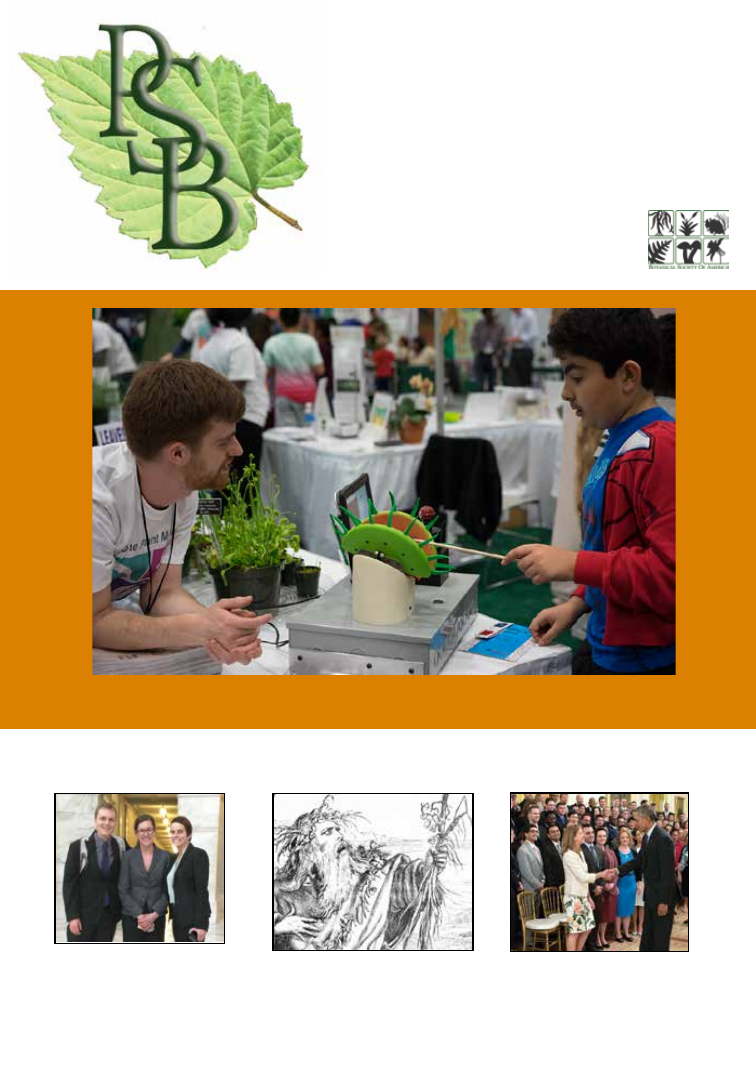
IN THIS ISSUE...
PLANTS Grant Recipients and Mentors Gather at Botany 2015!
SUMMER 2016 VOLUME 62 NUMBER 2
PLANT SCIENCE
BULLETIN
A PUBLICATION OF THE BOTANICAL SOCIETY OF AMERICA
BSA members attend
Congressional Visits
Day.... p. 61
BSA Member Erika Edwards
Receives Presidential Early
Career Award... p. 101
“Plants Move, Plants Matter” at the USA Science and Engineering Festival
Shakespeare, Plant Blindness,
and Electronic Media...p. 85

Summer 2016 Volume 62 Number 2
PLANT SCIENCE BULLETIN
Editorial Committee
Volume 62
Kathryn LeCroy
(2018)
Environmental Sciences
University of Virginia
Charlottesville, VA 22904
kal8d@virginia.edu
L.K. Tuominen
(2016)
Department of Natural Science
Metropolitan State University
St. Paul, MN 55106
Lindsey.Tuominen@metrostate.edu
Daniel K. Gladish
(2017)
Department of Biology &
The Conservatory
Miami University
Hamilton, OH 45011
gladisdk@muohio.edu
Melanie Link-Perez
(2019)
Department of Botany
& Plant Pathology
Oregon State University
Corvallis, OR 97331
linkperm@oregonstate.edu
From the Editor
Greetings!
In this issue, we celebrate many of the Society’s award
winners, including the 2016 Distinguished Fellows
and this year’s recipient of the Emerging Leader Award
(p. 62). Many of our student award winners are list-
ed in this issue, as well (p. 65). Congratulations to all!
Look for more award winners in the Fall issue.
I want to take a moment to thank the many people
who have contributed book reviews to Plant Science
Bulletin. These contributors volunteer their time and
effort to read and review the newest books in plant
science and we could not offer this valuable resource
without their commitment. I have added many a book
to my own reading list after reading a review. If you
would like to write a book review for PSB, the current
list of available books can always be found at http://
cms.botany.org/home/publications/plant-science-bul-
letin.html.
PSB has had multiple requests from readers looking
for advice in choosing textbooks that are successful in
incorporating plant biology into more general topics.
This spring, my own university considered switching
General Biology textbooks, which most of you know, is
typically a laborious and contentious process. I would
like to call on you, the readers of Plant Science Bulletin,
to address the need for reviews of textbooks, includ-
ing General Biology textbooks, from the perspective
of botanists.
Textbooks rarely make our list of books available for
review and we generally don’t have copies available.
However, if you currently use a textbook with which
you are particularly happy (or unhappy), PSB would
welcome your review of that text. If you are interested
in contributing, please contact me at psb@botany.org.
I hope that many of you are planning to make the trip
to Savannah for Botany 2016!
If you have ideas or comments about Plant Science
Bulletin, please find me or attend “Are You Being
Served,” a discussion with the editors of BSA publica-
tions, on Wednesday, August 3, at 1:30 p.m. in Room
106 of the Convention Center.
See you in Savannah!
Shannon Fehlberg
(2020)
Research and Conservation
Desert Botanical Garden
Phoenix, AZ 85008
sfehlberg@dbg.org

57
TABLE OF CONTENTS
SOCIETY NEWS
Summer 2016 Public Policy Note... ......................................................................................................58
Dunn Receives First Annual Botany Advocacy Leadership Award. ..................................61
2016 Congressional District Visits......................................................... .............................................61
Botanical Society of America’s Award Winners.................... .......................................................62
SPECIAL FEATURES
Eat Your Weeds: Edible and Wild Plants in Urban
Environmental Education and Outreach........................................................................................ 72
Shakespeare, Plant Blindness, and Electronic Media ............... .............................................85
SCIENCE EDUCATION
USA Science and Engineering Festival: “Plants Move, Plants Matter”
Booth Draws Thousands of Visitors. .............................................................................................94
Botany Booth in a Box Outreach Competition.. ...........................................................................95
PlantingScience Seeking 100 New Mentors for Fall 2016 as Improved
Website Launched.... ................................................................................................................................95
Digging Deeper Together: Collaborative Teacher/Scientist Professional
Development Launches this Summer... .........................................................................................96
STUDENT SECTION
Getting the Most out of BOTANY 2016: A Guide for Students ...........................................97
ANNOUNCEMENTS
Linnean Society of London Meeting at the Arnold Arboretum . ........................................100
BSA Member Erika Edwards Receives Presidential Early Career Award .................. 100
Marshall Sundberg Named 2016 Roe R. Cross Distinguished Professor .................. 101
BOOK REVIEWS
Economic........................................................................................................................... .............................. 104
Historical..... ..................................................................................................................................................... 109
Systematics ................................................................................................................................................... 110
www.botanyconference.org
Register now for the
conference you don’t want to miss!

58
Summer 2016 Public Policy Note
By Marian Chau (Lyon Arboretum
University of Hawai‘i at Mānoa) and
Morgan Gostel (Smithsonian Institution),
Public Policy Committee Co-Chairs
SOCIETY NEWS
This year has kicked off with much excitement
for the BSA Public Policy Committee; 2016
marks the fifth year of BSA participation in
the annual Biological and Ecological Sciences
Coalition (BESC) Congressional Visits Day.
Two BSA members participated in the event,
held on April 27 and 28: Dr. Krissa Skogen,
BSA Public Policy Award winner, and Dr.
Morgan Gostel, BSA Public Policy Committee
co-chair.
Read about Dr. Skogen’s experience, below
and stay tuned for next year’s Public Policy
Award application, which can be found at
http://cms. botany.org/home/awards/awards-
for-early-career-scientists/publicpolicyaward.
html in November 2016.
Dr. Skogen’s Experience
I was honored to have been selected for the
BSA Public Policy Award and to participate
in the Biological and Ecological Sciences
Coalition Congressional Visits Day. I’ve been
interested in the interface between public
policy and science for a while and saw this
event as a unique opportunity both to learn
from scientists who have devoted part of their
careers to public policy and to engage with
policy makers myself.
The first morning was held at the office of
the Ecological Society of America, where a
panel of scientists who have transitioned their
careers from science to public policy shared
their personal stories and provided advice.
The speakers included Rich Pouyat (Senior
Policy Analyst, Climate Resilience and Land
Use, Office of Science and Technology Policy),
Nadine Lymn (Communications Director,
National Science Board Office, National
Science Foundation), Brittany Marsden
(Analyst in NOAA OAR’s Formulation and
Congressional Analysis Division), and Alan
Thornhill (Director Office of Science Quality
and Integrity, U.S. Geological Survey). I
found this session particularly valuable, as the
speakers highlighted many of the important
aspects of being a liaison between science
and policy making. Their advice included
many obvious but often overlooked factors
important for being effective in such a role, such
as recognizing that science is only one of the
many considerations taken into account when
policy decisions are made. They emphasized

PSB 62 (2) 2016
59
Congressional Visits Day, Midwest team inside
the Russell Senate Office Building, Washington,
D.C. Left to right, BSA Public Policy Commit-
tee Co-Chair, Morgan Gostel; BSA Public Pol-
icy Award winner, Krissa Skogen; and fellow
team member, Nina Richtman.
the fact that many of the skills that one gains
as a result of becoming a scientist are essential
to succeeding as a liaison, including the ability
to think critically, write clearly, listen, step
outside of your comfort zone, and—one of my
favorites—never let a good crisis go to waste.
The afternoon’s events were held at the AIBS
offices and focused on preparing participants
for congressional meetings, including
information on federal trends in science
funding, tips for successful meetings with
policymakers, and an overview of the legislative
process. Kei Koizumi (Assistant Director for
Federal Research and Development, White
House Office of Science and Technology
Policy) provided insight on federal spending
on science and how it impacts scientists.
Julie Palakovich Carr (AIBS) then provided
a number of important talking points for our
meetings with Congress members, including
the fact that 68% of federal funding for non-
medical research comes from NSF as well
as state-specific funding and benefits. The
afternoon ended with an orientation for
congressional meetings provided by Alison
Mize and Terence Houston (ESA) and
mock Capitol Hill meetings. With the goal
of asking for support for funding NSF at $8
billion in fiscal year 2017, my team members
and I honed our message. As scientists, we
represented industry (Nina Richtman –
DuPont Pioneer, Iowa), museum (Morgan
Gostel – Smithsonian Institution, Washington,
DC), and non-profit (myself – Chicago
Botanic Garden, Illinois) and provided a great
overview of the benefits of science funding
at numerous levels: academic, educational,
and industry. I left the AIBS office energized,
excited, and well-prepared for our meetings
the following day.
The second day I joined Morgan Gostel and
Nina Richtman on the Hill. We met with
Representative David Young (IA – R) and
staffers from the offices of Senator Dick
Durban (IL - D), Senator Mark Kirk (IL - R),
and Representative Bob Dold (IL - R), Senator
Joni Ernst (IA – R), Senator Chuck Grassley
(IA – R), and Representative Eleanor Holmes
Norton (Washington, DC – D). During our
meetings, Nina, Morgan and I each took the
lead for our home state/district. I felt lucky
to share my personal story of the impact that
NSF funding has had on my career at pivotal
times, including as a graduate student and
now as an early-career scientist with post-
docs and students of my own. I emphasized
the dual role of NSF funding, for both basic
research and education, and the value of
engaging students at various levels, as the
critical thinking, writing, and analytic skills
that one learns while pursuing scientific
endeavors are essential for nearly every
profession. I was also proud to represent
my home institution, the Chicago Botanic

PSB 62 (2) 2016
60
Society News
Science is about telling
stories, sharing our
passions, and getting
others excited about
our work. Engaging a
new audience—policy
makers—is essential to
the future of science...
Garden, and the great work being conducted
by my colleagues and the students in our Plant
Biology and Conservation graduate program,
much of which has been funded by NSF. Nina
and Morgan’s personal stories were a great
complement to mine and provided further
context for the importance of federal funding
for NSF to scientists in academic institutions
and industry.
Prior to my trip, I was nervous about how my
meetings would unfold and whether I was
sufficiently prepared. Thanks to the fantastic
coordination by AIBS prior to our meetings,
in the end, I was well-prepared and had a
great time—it was easy, fun, and exciting. At
the end of my visit, three things were striking
to me:
• First, I was shocked by how easy it was to ask for $8
billion, and that all Congress members and staffers are
expecting you to ask them for something when you
meet with them.
• Second, I was encouraged by the fact that the offices
we met with were receptive to our message; people are
interested in science and they like to hear our stories
and learn about the impact we are having.
• Third, I was surprised by how fun it was to share my
passion for science and education with people in a po-
sition to effect change and to share my personal story,
as well as those of students and colleagues with whom
I’ve worked, of how science funding, and NSF funding
in particular, has changed our career trajectories and
lives.
Science is about telling stories, sharing our
passions, and getting others excited about
our work. We are accustomed to engaging
our students and colleagues. Engaging a
new audience—policy makers—is essential
to the future of science. However, many
scientists and faculty don’t know how to
become engaged and many don’t know just
how important—and easy—it is to meet
with their representatives in Congress and
voice their concerns. While participating
in the Congressional Visits Day may be of
particular interest to someone considering
a career change from a focus on science to
a career at the science-policy interface, I’d
argue that meeting with one’s representatives
is an extremely valuable experience for any
scientist, and truly is part of the job of being
a scientist.
Traveling to Washington DC isn’t a
requirement for meeting with Congress
members; many host district visit days when
they are home on recess or may tour your
home institution. Many colleges, universities,
and non-profits have lobbyists who represent
them on the Hill. Find out if you have a
lobbyist, connect with them and stay up to date
on important science-related policy matters.
Call the offices of your representatives when
an important vote is approaching and share
your concerns—a simple sentence or two
stating your request takes only a few minutes
but very few citizens, and scientists, pick up
the phone. I’m grateful for the opportunity to
participate in the Congressional Visits Day
and I thank BSA for providing support and
encourage others to participate in future years.
I left DC inspired and excited about my role
in communicating the importance of funding
basic science and education and committed
to remaining engaged in public policy. the
importance of funding basic science and
education and committed to remaining
engaged in public policy.

PSB 62 (2) 2016
61
FROM THE
PSB
ARCHIVES
60 years ago: Guest Editor George S. Avery,
Jr. introduces a special PSB issue on teach-
ing botany: “One hundred years ago botany
courses, natural history, or whatever, were
chiefly of taxonomic content. A large propor-
tion of the population lived in what we now
call “the country.” In that different America it
was a daily experience for people to see and
know wild plants. Today by farthe most of us
live in cities or suburbs, and the old approach
has become inadequate.”. . .
“In the America of today and the growing
ever- changing America of the future, botany
faces a challenge. Whether we can meet it, or
are to continue along the old traditional paths
that may lead to extinction-- is the question.
The articles in this issue suggest that many
teachers are thinking about ways of meeting
the challenge. But words alone are not enough,
no matter how dynamic and thought-provok-
ing they may be. We need a program that will
make general botany courses a more central
and vital part of the undergraduate curricu-
lum.” (PSB 2(3): 2)
50 years ago: “A request that the Botanical So-
ciety of America Archives be deposited in the
History of Science Collection at The Universi-
ty of Texas was presented at the Council Meet-
ing on August 23, 1964. This request received
the approval of the Council. Since receiving
these Archives, our staff has microfilmed the
Society records through 1949. Recently Dr.
Richard C. Starr, Secretary, Botanical Society
of America, has deposited in the Archives the
Society’s Minutes for 1950 through 1954.
In addition to these official records, the Col-
lection has been receiving manuscripts,
photographs and publications related to the
Botanical Society of America and also to out-
standing U.S. botanists.” (PSB 12(2): 8)
Society News
Dunn Receives First Annual
Botany Advocacy
Leadership Award
The BSA Public Policy Committee and
the ASPT Environment and Public Policy
Committee have selected an awardee for
the first annual jointly sponsored Botany
Advocacy Leadership Grant. The award
goes to Dr. Michael Dunn on behalf of the
Southwest Chapter of the Oklahoma Native
Plant Society for a seminar and lecture
series that will contribute to public policy
by supporting outreach and education on
native plant conservation and awareness.
Congratulations, Michael!
The Botanical Advocacy Leadership Grant is
an annual award, so we encourage members
to apply next year. You can find more
information on the grant at cms.botany.org/
file.php?file=SiteAssets/awards/BSA_BAL_
Call.pdf. Stay tuned in January 2017 for an
update on Michael Dunn’s seminar series, and
for the 2017 call for applications.
2016 Congressional
District Visits
The Botanical Society of America is helping
to sponsor the 2016 Congressional District
Visits event. Help showcase your science
to your elected lawmakers by meeting with
them locally in your district! Read a summary
about the 2015 CDV event at
https://www.
aibs.org/public-policy/news/lawmakers_
tour_research_facilities.html
. Register for this
event by July 17, 2016 at https://www.aibs.org/
public-policy/congressional_district_visits.
html.

PSB 62 (2) 2016
62
Botanical Society of America’s
Award Winners
2016 Distinguished Fellow
Award Winners
The Botanical Society of America Distinguished
Fellow Award (formerly known as the Merit
Award) is the highest honor our Society bestows.
Each year, the Merit Award Committee solicits
nominations, evaluates candidates, and selects
those to receive an award. Awardees are chosen
based on their outstanding contributions to the
mission of our scientific Society. The committee
identifies recipients who have demonstrated
excellence in basic research, education, and
public policy, or who have provided exceptional
service to the professional botanical community,
or who may have made contributions to a
combination of these categories.
Professor Joseph Armstrong
Joseph Armstrong is a highly praised teacher/
educator, a public advocate for botany
andevolution, and an active researcher of
quitevaried interests. His numerous awards
include Outstanding Teacher at Illinois
State University and the BSA’s Charles E.
Bessey award. Well before STEM education
came into vogue, he actively challenged and
involved students in courses and educational
experiences, as reflected in his books and
numerous writings. His former students are
effusive in their high regard for his teaching
and influences on their professional lives;
as one of them stated, “he’s all about all the
students.” He has been equally vigorous in his
public outreach for botany and evolution, and
he has been a major contributor to and tireless
worker for the BSA. Professor Armstrong’s
research has dealt with the whole plant, from
root apical meristems through the wood of
stems to flowers; his substantial published
research articles have included studies on
anatomy, morphology, floral development,
pollination biology, genetics, systematics, and
ecology. As one of his supporters noted, his
“studies on the role of floral morphology for
the distinction of families in the premolecular
era are especially noteworthy.” Many have
noted that he is a student of the whole plant and
its place in ecosystems, as well as a proponent
of botany and evolution through teaching and
public outreach—Professor Armstrong is “a
man of many hats.”

PSB 62 (2) 2016
63
Professor Jacob Weiner
Weiner has made important contributions
in several areas of ecology, including
size variation within plant populations,
plant competition at the individual and
population levels, plant growth and resource
allocation, and the application of ecological
and evolutionary knowledge to agricultural
production systems. He is associated with a
specific approach to plant ecology, which is
analytic, mechanistic, and starts with simple
models that produce testable hypotheses.
Several of his papers are considered “classics”
and are used in plant ecology courses around
the world because they are easy to read and
have a clear logic. He is known for finding
non-conventional angles and solutions to
difficult problems, and he has often succeeded
in discovering simplicity in the seemingly
overwhelming complexity of plant behavior.
For example, he showed that patterns of
allocation in plants that had been interpreted
as “flexible reproductive strategies” could be
better and more simply explained in terms
of fixed allometric trajectories. In the middle
of his career, he made a notable shift in focus
and location. After serving on the faculty at
Swarthmore College for 18 years, where he
taught courses in botany and ecology and
did research on basic mechanisms of plant
competition and allocation, he left for the
Royal Veterinary and Agricultural University
(now part of the University of Copenhagen) in
Denmark in 1996 and began applying theories
from plant ecology to the improvement
of agriculture. Using ideas from plant
population biology and testing the resulting
hypotheses, he has demonstrated that the
potential for weed suppression by cereal crops
is much greater than appreciated, and that this
potential can be realized through increased
crop density and spatial uniformity. He is
currently attempting to apply evolutionary
theory to agriculture and plant breeding.

PSB 62 (2) 2016
64
Dr. Michael Barker Receives
Emerging Leader Award
Dr. Michael Barker is an Assistant Professor in
the Department of Ecology and Evolutionary
Biology at the University of Arizona. Barker
received his undergraduate degree at Denison
University, earned a Master’s degree at Miami
University, and then obtained a PhD in 2009 at
Indiana University with Drs. Loren Rieseberg
and Gerald Gastony. After his NSERC-BRITE
Postdoctoral Fellowship at University of
British Columbia with Dr. Sally Otto, he took
his current position in 2011. Over that time,
Barker has proven to be a prolific researcher,
with more than 50 peer-reviewed publications.
As an emerging leader, Barker enjoys a
national and international reputation for
being an expert at using bioinformatics and
computational biology to confront enduring
evolutionary questions in botany. Barker
has successfully focused on developing
algorithms for studying ancient and recent
polyploidy (whole genome duplications).
Taxonomically, he has worked primarily on
ferns and members of the sunflower family;
however, his novel methods in computational
biology have led him to work on many plant
groups as now on insects and other lineages
of life. His expertise also spans time from
macroevolution to microevolution—from
the diversification of major lineages to recent
hybridization and plant domestication.
Barker has an impressive record of leadership
not only in research, but also his dedication
to teaching, outreach, and service. Whether
coordinating computational workshops
or directing campus-wide bioinformatics
efforts, Barker has demonstrated a willingness
to step up and assume leadership roles in
professional societies and at the University of
Arizona. He has organized several symposia
and colloquia, including a BSA symposium
and special issue of the American Journal of
Botany (July 2016) on the theme of polyploidy
and genome evolution. Given his record of
accomplishment and contributions to Botany,
Dr. Michael Barker is an exemplary recipient
of the BSA Emerging Leader Award.

PSB 62 (2) 2016
65
BSA Public Policy Award
The Public Policy Award was established in 2012 to support the development of tomorrow’s leaders
and a better understanding of this critical area. The 2016 recipient is:
Krissa Skogen, Ph.D., Conservation Scientist, Conservation and Land Management Internship
Program Manager, Chicago Botanic Garden and Adjunct Professor – Northwestern University
The J. S. Karling Graduate Student Research Award
Jonathan P. Spoelhof, University of Florida (Advisor: Douglas Soltis), for the proposal:
Connecting Adaptation and Expression in Neopolyploid Arabidopsis thaliana
The BSA Graduate Student Research Awards
Ana María Bedoya, University of Washington, Seattle (Advisor: Richard Olmstead), for the
proposal: Andean uplift and the transformation of aquatic ecosystems: Impacts on the evolutionary
patterns in aquatic plants of northern South America
Alexander C. Bippus, Humboldt State University (Advisor: Alexandru M.F. Tomescu), for the
proposal: Exploring the phylogeny of basal Tracheophytes: The early Devonian radiation
Megan Bontrager, University of British Columbia (Advisor: Amy Angert), for the proposal: The
roles of geography and environment in determining population genetic structure and performance
at the northern range edge of Clarkia pulchella
Matthew Chmielewski, Portland State University (Advisor: Sarah Eppley), for the proposal:
Does local dispersal of bryophytes by birds matter? Testing temporal shifts in bryophyte movement
via birds and wind in a Pacific Northwest forest
Taylor Crow, University of Wyoming (Advisor: Kristina Hufford), for the proposal: Alternative
methods for delineating seed transfer zones
Timea Deakova, Portland State University (Advisor: Sarah Eppley), for the proposal: A novel
finding: Exploring the role of isoprene emission from germinating Polytrichum juniperinum moss spores
Evan Eifler, University of Wisconsin – Madison (Advisor: Tom Givnish), for the proposal: Spatial
and temporal patterns of diversification in Geissorhiza (Iridaceae): Phylogeny, biogeography, and
vulnerability in the Cape Floristic Province
Jonathan A. Flickinger, Florida International University (Advisor: Javier Francisco-Ortega),
for the proposal: Systematics of the Lathberry Clade of Eugenia L. (Myrtaceae) in the Caribbean
Islands

PSB 62 (2) 2016
66
Luiz Henrique Martins Fonseca, Universidade de São Paulo (Advisor: Lúcia G. Lohmann),
for the proposal: Systematics, phylogeny and diversification of Adenocalymma (Bignonieae,
Bignoniaceae)
Diana Gamba, University of Missouri – St. Louis (Advisor: Nathan Muchhala), for the proposal:
Is speciation faster in the tropics? Effects of seasonality and mutualists on angiosperm genetic
structure
Ian Gilman, University of Idaho (Advisor: David Tank), for the proposal: Phylogeography of
Cordylanthus and Pseudocordylanthus: A framework for assessing the role of niche evolution and
conservatism in the process of speciation
Nathan Paul Hartley, Duke University (Advisor: Paul Manos), for the proposal: Diversification
of a neotropical litter-trapping epiphyte clade (Anthurium section Pachyneurium): A preliminary
assessment of phylogenetic niche conservatism
Caitlin Maraist, Portland State University (Advisor: Sarah Eppley), for the proposal: Effects of
phyllospheric fungi on sexual effort and chemical cues in the dioecious moss, Ceratodon purpureus
F. Nicolas Medina, Claremont Graduate University, Rancho Santa Ana Botanic Garden (Advisor:
J. Travis Columbus), for the proposal: Phylogenetic insights into the New World strangler figs
(Ficus subgen. Urostigma sect. Americana): Testing for hybridization and introgression
Chelsea Miller, University of Tennessee, Knoxville (Advisor: Charles Kwit), for the proposal:
Does the presence of entomopathogenic fungi on myrmecochorous seeds affect seed-handling and
dispersal behaviors in Aphaenogaster ants?
Andre A. Naranjo, University of Florida (Advisor: Pamela Soltis), for the proposal: The
comparative phylogeography of Eastern North American wetland forest species
Chathurani Ranathunge, Mississippi State University (Advisor: Mark E. Welch), for the
proposal: Elucidating the adaptive role of microsatellites in natural populations of Helianthus
annuus (Asteraceae)
María Adolfina Savoretti, Universidad Nacional de La Plata and Instituto de Botánica
Darwinion (Advisor: Alexandru M.F. Tomescu), for the proposal: Systematic affinities of Early
Cretaceous mosses of western North America – an inquiry into the deep history of bryophytes
Katelin D. Stanley, Florida State University (Advisor: Austin R. Mast), for the proposal: A
comparative anchor for anchored phylogenomics: Systematic discovery of Elephantopodinae
(Asteraceae) from within the “Evil Tribe”

PSB 62 (2) 2016
67
Vernon I. Cheadle Student Travel Awards
(BSA in association with the Developmental and Structural Section)
This award was named in honor of the memory and work of Dr. Vernon I. Cheadle.
Christopher Nelson, Florida Museum of Natural History (Advisor, Dr. Nathan A. Jud), for the
Botany 2016 presentation: “A new species of Mammea (Calophyllaceae) from the lower Miocene
of Panama” Co-author: Nathan A. Jud
Adam Ramsey, University of Memphis (Advisor, Dr. Jennifer R. Mandel), for the Botany 2016
presentation: “Patterns of cyto-nuclear disequilibrium and the influence of heteroplasmy in wild
carrot, Daucus carota (Apiaceae)” Co-author: Jennifer R. Mandel
Amanda Salvi, University of Michigan, Ann Arbor (Advisor, Dr. Selena Y. Smith), for the
Botany 2016 presentation: “Effect of canopy shading on morphology, anatomy, and self-shading
in spiral gingers (Costus)” Co-author: Selena Y. Smith
Rachel Schwallier, Naturalis Biodiversity Center (Advisor, Dr. Barbara Gravendeel), for the
Botany 2016 presentation: “Evolution of wood anatomical characters in Nepenthes and close
relatives in Caryophyllales” Co-authors: Barbara Gravendeel, Hugo de Boer, Bertie Joan van
Heuven, Anton Sieder, Sukaibin Sumail, Rogier van Vugt, Stephan Nylinder, and Frederic Lens
The BSA Undergraduate Student Research Awards
The BSA Undergraduate Student Research Awards support undergraduate student research and
are made on the basis of research proposals and letters of recommendation. The 2016 award
recipients are:
Christie Dang, Creighton University (Advisor, Dr. Mackenzie Taylor), Post-pollination
development in the hydrophilous species Stuckenia pectinata (Potamogetonaceae)
Anna Hakkenberg, University of Richmond (Advisor, Dr. Carrie Wu), Genetic patterns of
introduction during the emerging invasion of wavyleaf basketgrass (Oplismenus undulatifolius)
into U.S. Mid-Atlantic forest understories
María del Pilar Herrera, San Marcos University (Advisor, Dr. Julien Bachelier), Comparative
development of extremely dimorphic male and female reproductive structures in Orthopterygium
huaucui, a very rare and highly endemic dioecious genus of Anacardiaceae
Elizabeth Leo, Towson University (Advisor, Dr. Laura Gough), Bioavailability and trophic
transfer of heavy metal soil contaminants in urban gardens in Baltimore, MD.
Nathan Luftman, Bucknell University (Advisors, Drs. Christopher T. Martine and Jason
Cantley), Chenopodium “Moloka’i” (Amaranthaceae): A potential new species on the Hawaiian Island Moloka’i

PSB 62 (2) 2016
68
Kendall Major, University of Memphis (Advisor, Dr. Jennifer Mandel), Genetic diversity and
population structure in the clonal plant Trillium recurvatum
Yu-Ling Shih, Da-Yeh University (Advisors, Dr. Pei-Luen Lu), Botanical biodiversity of Long
Lellang, Sarawak, Malaysia
Austin Szubryt, Southern Illinois University – Carbondale (Advisor, Dr. Kurt Neubig), The
golden rule for goldentops: Using phylogenetics to classify Euthamia (Asteraceae)
The BSA Young Botanist Awards
The purpose of these awards is to offer individual recognition to outstanding graduating seniors
in the plant sciences and to encourage their participation in the Botanical Society of America.
The 2016 “Certificate of Special Achievement” award recipients are:
Kevin Bird, University of Missouri (Advisor: Dr. J. Chris Pires)
Katie Brown, University of Guelph (Advisor: Dr. Christina (Chris) Caruso)
Carmela Buono, Rutgers University (Advisor: Dr. Myla F.J. Aronson)
Alice Butler, Bucknell University (Advisor: Dr. Chris Martine)
Wade Dismukes, University of Missouri (Advisor: Dr. J. Chris Pires)
Ashley Donnel, Eastern Illinois University (Advisor: Dr. Scott J. Meiners)
Benjamin Durrington, Hillsdale College (Advisor: Dr. Ranessa Cooper)
Zoe Feder, Oberlin College (Advisor: Dr. Michael J. Moore)
Meghan Garanich, Bucknell University (Advisor: Dr. Chris Martine)
Cazandra Koonce, St. Louis Community College (Advisor: Dr. Scott D. Gevaert)
Erin Johnson, Oberlin College (Advisor: Dr. Michael J. Moore)
Evan Kilburn, Auburn University (Advisor: Dr. Robert S. Boyd)
Ian Medeiros, College of the Atlantic (Advisor: Dr. Nishanta “Nishi” Rajakaruna)
Jacob Mreen, St. Louis Community College (Advisor: Dr. Scott D. Gevaert)
Julia Olivieri, Oberlin College (Advisor: Dr. Michael Moore)
Becca Otoole, University of Florida (Advisor: Dr. Douglas Soltis)
Madeline McClelland, Willamette University (Advisor: Dr. Susan R. Kephart)
Sebastian Mortimer, Willamette University (Advisor: Dr. Susan R. Kephart)
Margo Paces, Fort Lewis College (Advisor: Dr. Ross A. McCauley)
Amanda Salvi, University of Michigan (Advisor: Dr. Selena Y. Smith)
Jake Summers, Connecticut College (Advisor: Dr. Chad Jones)|
Anna Talcott, Hillsdale College (Advisor: Dr. Ranessa Cooper)
Imena Valdes, Florida International University (Advisor: Dr. Suzanne Koptur)
Rebecca Valls, Florida International University (Advisor: Dr. Eric von Wettberg)
Scott Van De Verg, University of Hawai’i (Advisor: Dr. Cliff Morden)
Kayla Ventura, University of Florida (Advisor: Dr. Pamela S. Soltis)
Lauren Walter, Hobart and William Smith Colleges (Advisor: Dr. Shannon C.K. Straub)

PSB 62 (2) 2016
69
The BSA PLANTS Grant Recipients
The PLANTS (Preparing Leaders and Nurturing Tomorrow’s Scientists: Increasing the diversity of
plant scientists) program recognizes outstanding undergraduates from diverse backgrounds and
provides travel grants and mentoring for these students.
Timothy Batz, California State Polytechnic University (Advisor: Dr. Bharti Sharma)
Janet Mansaray, Howard University (Advisor: Dr. Janelle Burke)
Corey Milligan, Harris-Stowe State University (Advisor: Dr. Thomas Brown)
Brooke Palmer, Colorado State University (Advisor: Dr. Stacey Smith)
Vivianna Sanchez, Mount St. Mary’s University (Advisor: Dr. Adriane Jones)
Jaime Schwoch, Portland State University (Advisor: Dr. Mitch Cruzan)
Evelyn Valdez-Rangel, University of Houston-Downtown (Advisor: Dr. Michael Tobin)
Rebecca Valls, Florida International University (Advisor: Dr. Eric von Wettberg)
Nathan Vega, California State University-Fullerton (Advisor: Dr. Joshua Der)
Monica Warner, California State University - Dominguez Hills (Advisor: Dr. Kathryn Thiess)
Shan Wong, Florida International University (Advisor: Dr. Hong Liu)
Genetics Section Student Research Awards
Genetics Section Student Research Awards provide $500 for research funding and an additional
$500 for attendance at a future BSA meeting.
Ben Merritt, University of Cincinnati (Advisor: Dr. Theresa M. Culley), for the proposal titled
“Questions of genomic and geographic scales: Characterization and assessment of molecular tools
in Sedum lanceolatum Torr. (Crassulaceae)”
Megan Bontrager, University of British Columbia (Advisor: Dr. Amy Angert), for the proposal
titled “The roles of geography and environment in determining population genetic structure and
performance at the northern range edge of Clarkia pulchella”
Genetics Section Student Travel Awards
Adam Ramsay, University of Memphis (Advisor, Dr. Jennifer R. Mandel) for the Botany 2016
presentation: “Patterns of cyto-nuclear disequilibrium and the influence of heteroplasmy in wild
carrot, Daucus carota (Apiaceae)” Co-author: Jennifer R. Mandel
Charles Foster, University of Sydney (Advisor, Dr. Simon Ho) for the Botany 2016 presentation:
“Evaluating the impact of genomic data and priors on Bayesian estimates of the angiosperm
evolutionary timescale” Co-authors: Herve Sauquet, Marlien van der Merwe, Hannah
McPherson, Maurizio Rossetto and Simon Ho

PSB 62 (2) 2016
70
American Journal of Botany and Applications in
Plant Sciences: Higher Impact Factors
Thomson Reuters recently released its latest Journal Citation Reports, and we’re
proud that American Journal of Botany (AJB) and Applications in Plant Sciences
(APPS) both have higher impact factors:
AJB’s impact factor is now 2.8, and APPS is now 0.9.
Thanks to all contributing authors, reviewers, associate editors, and
editors-in-chief for their hard work!
Monica Warner, California State University, California State University, Dominguez Hills
(Advisor, Dr. Kathryn E. Theiss) for the Botany 2016 presentation: “Evaluating species
differentiation in endangered rush lillies using population genetics” Co-authors: Kathryn E.
Theiss and Susan Kephart
Developmental & Structural Section
Student Travel Awards
Muhammad Akbar Abdul Ghaffar, Ohio State University (Advisor, Katrina Cornish), for
the Botany 2016 presentation: “Histological study of Laticifer and rubber particle ontogeny in
Taraxacum kok-saghyz roots” Co-authors: Tea Meulia and Katrina Cornish
Bridget Giffei, Creighton University (Advisor, Mackenzie Taylor) for the Botany 2016
presentation: “Post-pollination development in Ruppia maritima (Ruppiaceae, Alismatales)” Co-
authors: Christie L. Dang, Kristine M. Altrichter, Ana E. Wilden and Mackenzie Taylor

The New Photosynthesis
System from LI-COR is Here
Introducing the LI-6800 Portable Photosynthesis System
We can’t wait to show
you.
See it for yourself at
www.licor.com/6800-in-action

72
Eat Your Weeds:
Edible and Wild Plants in Urban
Environmental Education and Outreach
1
By Lauren J. Frazee
2
Graduate Program in Ecology and Evolution, Department of Ecology, Evolution, and Natu-
ral Resources, School of Environmental and Biological Sciences, Rutgers, The State University
of New Jersey, New Brunswick, NJ
Sara Morris-Marano
Mohican Outdoor Center, Appalachian Mountain Club, Blairstown, NJ; Department
of Ecology, Evolution, and Natural Resources, School of Environmental and Biological
Sciences, Rutgers, The State University of New Jersey, New Brunswick, NJ
Jennifer Blake-Mahmud
Graduate Program in Ecology and Evolution, Department of Ecology, Evolution, and Natu-
ral Resources, School of Environmental and Biological Sciences, Rutgers, The State Universi-
ty of New Jersey, New Brunswick, NJ
Lena Struwe
Department of Ecology, Evolution, and Natural Resources, School of Environmental and
Biological Sciences, Rutgers, The State University of New Jersey, New Brunswick, NJ; De-
partment of Plant Biology and Pathology, School of Environmental and Biological Sciences,
Rutgers, The State University of New Jersey, New Brunswick, NJ
Abstract
Edible weedy plants are ubiquitous in human-
dominated areas and provide opportunities to
combat plant blindness and improve citizens’
local ecological knowledge in formal and informal
urban environmental educatio (UEE) programs.
Weeds exemplify intriguing ecological, cultural,
and ethnobotanical concepts, making them ideal
resources for hands-on, socially relevant, and
personally meaningful educational activities.
Cosmopolitan, spontaneous, weedy plant species
are often freely accessible for use in the curricula of
many grade levels in varied educational venues as
well as in extra-curricular activities for all learners,
given that proper safety and legal precautions are
taken. We developed and hosted a UEE outreach
activity based on edible weedy plants at Rutgers
University as part of an annual, university-wide
event attended by over 80,000 people in the spring
of 2014. Incorporating edible weeds into such
programs teaches plant identification skills and
ecological appreciation in settings that are “close
to home” for most people.
SPECIAL FEATURES

PSB 62 (2) 2016
73
Articles
Key Words
botanical education; ecological knowledge;
food; informal education; K-99 education;
place-based learning; plant blindness;
species identification; urban environmental
education; urban vegetation
Footnotes
1
Manuscript received 26 January 2016;
revision accepted 31 March 2016.
2
Corresponding author email: lauren.
frazee@ rutgers.edu
doi: 10.3732/psb.1500003
Introduction
Positive human-nature interactions are vital
to counteract modern day environmental
problems, yet urbanization and development
continue to threaten our connection with
and understanding of the biosphere (Miller,
2005; White et al., 2010; Liefländer et al.,
2012). Current generations are becoming
increasingly estranged from living organisms
except other humans, supermarket food
plants, and pets (Miller, 2005). As of 2014,
82% of the population of the United States
lived in urban areas (United Nations, 2014);
native species diversity and abundance have
declined in cities (Gaston, 2010; Duncan et
al., 2011); and the ease of accessibility to green
space tends to diminish as city populations
grow (Fuller and Gaston, 2009). Together,
these phenomena may prevent much of the
world’s population from experiencing and
observing nature in a positive light (Morrone
and Meredith, 2003), ultimately leading to a
widespread lack of environmental concern
(Chawla, 1998). Therefore, developing
effective materials and curricula for urban
environmental education (UEE) that target
a broad audience is necessary to create an
ecologically and socially responsible society
for the future (Tidball and Krasny, 2010;
Ardoin et al., 2012).
Spontaneous urban plants (also known as
“weeds”) are ubiquitous in cities worldwide;
they inhabit every crack and corner of the
cityscape. The omnipresence of weeds in
modern cities and their suburbs makes them
some of the most universally accessible wild
species available for study and observation.
These weedy plants, whether native or non-
native, have traits that make them well suited
to highly disturbed human-dominated
environments such as suburban lawns or
pavement cracks (e.g. Cheptou et al., 2008; Del
Tredici, 2010). The sheer prevalence of weeds
makes them convenient and effective tools for
combatting plant blindness, defined as “the
inability to see or notice the plants in one’s
own environment, leading to the inability
to recognize the importance of plants in the
biosphere and in human affairs” (Wandersee
and Schussler, 1999; Smith, 2014). Learning
about weeds has the potential to encourage
people to notice the abundance of plant life
that surrounds them on a daily basis (Allen,
2003), even within cities. Studying weeds is
also a way to encourage learners of all ages
and backgrounds to appreciate, respect,
and inquire about nature in all of its diverse
forms (e.g., useful versus not useful plants, or
attractive versus “ugly” species).
Weedy plant foraging and city herbalism
have experienced a resurgence in popular
culture in the West in recent years (e.g. Wong
and Leroux, 2012; Lerner, 2013; Vorass-
Herrera, 2013; Blair, 2014). However, the fact
that most urban, weedy plant species have
ancient ethnobotanical histories and cultural
relevance for diverse human groups is not well
known today (Zimdahl, 2013). Chickweed, for

PSB 62 (2) 2016
74
Articles
example, is one of the most common vascular
plants, found in over 100 city floras worldwide
(Aronson et al., 2014). Chickweed has a
well-documented ethnobotanical record
in traditional South American, European,
and Asian cultures: the young shoots and
leaves are used as ophthalmic and anti-
inflammatory medicines in Patagonia; used
as fodder to increase egg-laying in poultry in
central Italy; and cooked along with cabbage
for human nourishment in southwest China
(e.g. Guarrera et al., 2005; Weckerle et al.,
2006; Molares and Ladio, 2009). Yet, most
wellknown and beloved plants in today’s
Western cultures are showy horticultural
ornamentals and garden crops—not the wild,
weedy plants historically used for medicinal
or food purposes. Exposing people to the
edible, medicinal, and other cultural or
historical uses of weeds can stimulate people’s
interest and curiosity in wild organisms.
Furthermore, using edible urban weeds as
study organisms roots UEE in the socio-
ecological nature of the city by connecting
students and the public to the natural world
via cultural, culinary, biological, ecological,
and historical references and provides a truly
interdisciplinary framework for formal and
informal education (Tidball and Krasny, 2010;
Blanchet-Cohen and Reilly, 2013).
Using edible weedy plants in environmental
educational initiatives also supports the
development and maintenance of plant
identification skills. Being able to identify
a species and giving it a unique name is not
only important for educational efforts in
combatting plant blindness, but it is also
a crucial pre-requisite to foraging for wild
foods. Along with the ease and accessibility of
incorporating edible weedy plants into UEE,
a strong emphasis must be placed on safety
precautions. A strong foundation of botanical
identification skills and morphological
knowledge is necessary for the success and
safety of any edible wild plant program. Many
plants are edible, but many others are toxic.
Foragers, instructors, and learners must
be aware of toxic “lookalikes” and should
not consume any plant product until the
identity of the collected species is certain.
New foragers may choose to begin with a
mentor or guide to learn the basics of plant
identification. Thorough, reliable field guides
and repeated field identification practice
are essential for cautious foraging and can
help remind even the most experienced
field botanists of subtle yet potentially
important morphological differences between
specimens. In urban settings, in particular,
educators must also ensure that foragers are
careful to avoid potentially toxic urban sites
that have been contaminated by pesticides,
fertilizers, automotive fuel, heavy metals, or
animal waste, among other pollutants. The
possibility of individual reactions to allergens
in common plants should be discussed prior
to foraging. In addition to safety precautions,
foragers should always acquire permission
from landowners to access and remove plant
materials from a given site.
We recognized the potential of using
spontaneous weedy plants as an exciting
and relevant way to engage the public, so
we organized an outreach table featuring
edible weedy plants for our local community.
We held our outreach event at the annual
Rutgers Day—a university-wide open house
for Rutgers University in New Brunswick,
New Jersey—that engages and informs the
extended local community through activities
provided by university students, clubs, and
departments. The local and state-wide impact
of this celebration is significant: in 2013, this
event was attended by nearly 80,000 people.
For Rutgers Day 2014, our environmental
education table was entitled “Eat Your Weeds:

PSB 62 (2) 2016
75
How to Safely Savor Wild Edible Plants.” Our
overarching teaching goal was to encourage
community members to make meaningful
connections not only with living wild plants,
but also with ecological processes and
associated biodiversity in urban and suburban
areas through eating weeds (Table 1).
Activity Description
Plant species selection
Six edible urban weeds that are locally
abundant were chosen to be showcased at
our outreach table during Rutgers Day 2014
(Table 2): Taraxacum officinale (common
dandelion), Allium vineale (field garlic, wild
onion), Alliaria petiolata (garlic mustard),
Stellaria media (common chickweed),
Cardamine hirsuta (hairy cress), and Rumex
acetosella (sheep sorrel). Although not as
common in suburban and urban areas, and
not always strictly weedy in our part of the
world, we also included Rosa canina (wild
rose) and Sambucus nigra (elderberry) as
highlighted species due to the commercial
availability of food products using these plants
(see Table 2). We also served two prepared
food products: Elderflower Lemonade from a
syrup concentrate (“Flädersaft,” IKEA Foods,
Sweden) and Rose Hip Soup (cold) from a
smoothie mix (“Nyponsoppa,” Ekströms,
Eslöv, Sweden).
Fact sheet preparation
Consuming and foraging for wild foods
involves certain risks, such as injury while
foraging, plants growing in polluted soils, and
poisoning due to eating misidentified plants. To
address these potential risks, we incorporated
safety information into our activity plan in
the following ways: (1) the back of each recipe
card listed foraging tips and species-specific
advice for plant identification; (2) we supplied
a general handout to provide information
on how to safely collect and consume edible,
weedy plants; and (3) we chose to highlight
plants that grow commonly in the lawns,
gardens, and along the sidewalk edges of
homes, where legal and informed foraging is
most likely to occur (with information about
pesticides, soil quality, and other risk factors).
Preparation of recipe cards and handouts on
safe foraging required approximately 8 person
hours.
Teaching Goals
Learning Outcomes
To inspire enthusiasm in a wide range of par-
ticipants To enable people to enjoy, risk- and
cost-free edible weedy plants
For participants across age ranges to express
excitement and enthusiasm in trying new cu-
linary dishes featuring weeds
To disseminate information regarding the
safe identification, procurement, and prepa-
ration of weedy plants
For participants to collect resources enabling
effective plant identification, collection, and
preparation with the intent to use them in the
future
To broaden perspectives and attitudes about-
weedy plants
For participants to entertain wider view-
points regarding the usefulness of sponta-
neous vegetation
Table 1. “Eat Your Weeds” educational outreach goals and outcomes.

PSB 62 (2) 2016
76
Articles
Plant species name
Recipe(s) created
Role(s) in activity
Alliaria petiolata
Garlic mustard
(Brassicaceae)
Garlic Mustard Hummus
Sample tasting, recipe
handout, and live plant
display
Allium vineale
Wild garlic or onion
(Amaryllidaceae)
Cream Cheese Spread with Wild
Garlic Shoots
Sample tasting, recipe
handout, and live plant
display
Cardamine hirsuta
Hairy cress
(Brassicaceae)
Hairy Cress Salad with Goat
Cheese, Walnuts, and Honey-
Dijon Vinaigrette
Recipe handout and live
plant display
Rosa canina
Wild rose
(Rosaceae)
Rose Hip Soup*
Sample tasting and live
plant display
Rumex acetosella
Sheep sorrel
(Polygonaceae)
Fresh Fruit Salad with Sheep
Sorrel and Sweet Whipped
Cream
Recipe handout
Sambucus nigra
Elderberry
(Adoxaceae)
Elderflower Lemonade*
Sample tasting
Stellaria media
Chickweed
(Caryophyllaceae)
Sautéed Chickweed with Ginger,
Garlic, and Soy Sauce
Recipe handout and live
plant display
Taraxacum officinale
Dandelion
(Asteraceae)
Dandelion Flower Lemonade†;
Deep-Fried Dandelion Flowers;
Orecchiette Pasta with Italian
Sausage, Dandelion Greens, and
Lemon Zest
Sample tasting, recipe
handouts, and live plant
display
Table 2. Food and drink featured plant contents and role.
Notes:
*Rose Hip Soup and Elderflower Lemonade are not original recipes; these beverages are avail-
able commercially. †Dandelion Flower Lemonade was used as the sample tasting dish for T.
officinale.
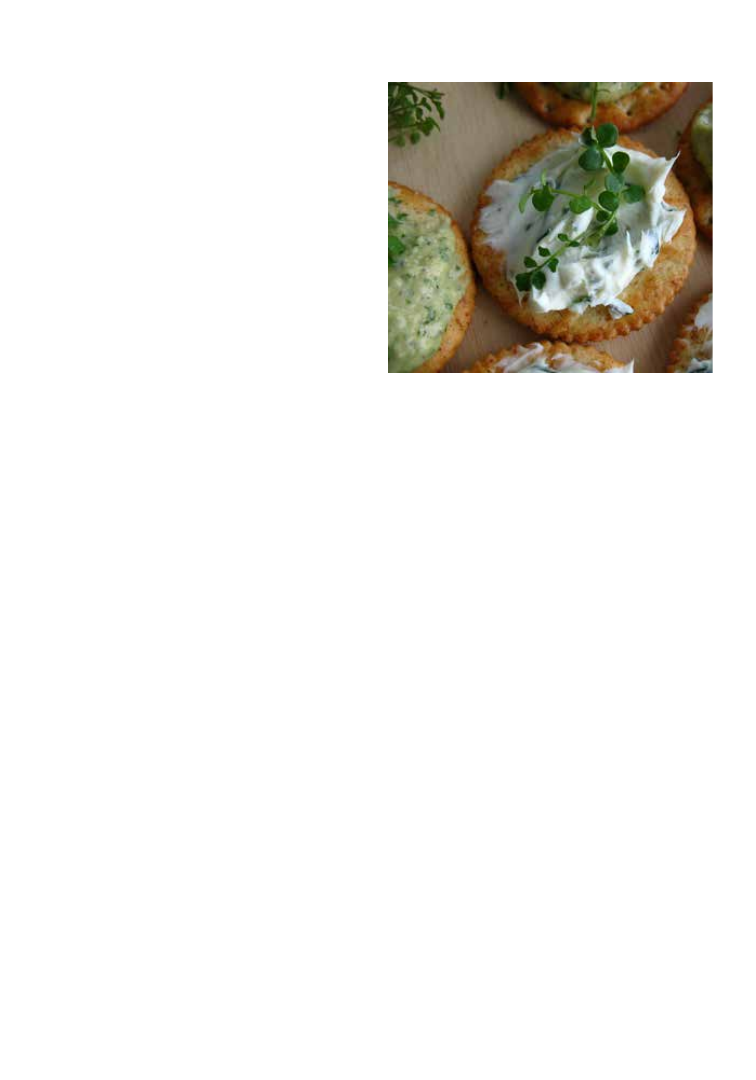
PSB 62 (2) 2016
77
Articles
Recipe preparation
Over several weeks we developed eight original
recipes based on six of our highlighted weedy
plant species. We selected three of the eight
original recipes to feature in our free tastings,
using three species of the most easily accessible
and identifiable weeds: Alliaria petiolata,
Allium vineale, and Taraxacum officinale.
For ingredients we spent approximately 3
hours foraging for plant material locally
in areas where pesticides and herbicides
had not been applied. We prepared Cream
Cheese Spread with Wild Garlic Shoots (Fig.
1), Garlic Mustard Hummus, Elderflower
Lemonade, Rose Hip Soup, and Dandelion
Flower Lemonade in bulk to offer as samples
on crackers and in small tasting cups at our
table (see Table 2). Food preparation prior
to the event required approximately 6 hours
to prepare the necessary quantities (i.e. two
gallons of Rose Hip Soup, two gallons of
Dandelion Flower Lemonade, two gallons of
Elderflower Lemonade, and 64 ounces each of
Garlic Mustard Hummus and Cream Cheese
Spread with Wild Garlic Shoots).
Event day set-up
With set-up teams consisting of two people
and two handcarts, we set up three tables along
one of the major pedestrian paths on Cook
Campus, Rutgers University during Rutgers
Day. Our outreach area was equipped with a
large, custom-designed overhead sign reading
“WEEDS” made from clear plastic tubing
filled with a variety of dried weedy plant parts
(Fig. 2). A newly developed, original logo
that read “EAT YOUR WEEDS” appeared
on all outreach materials (Fig. 3). Outreach
materials included recipe cards with a picture
of its featured edible weed and specific foraging
tips; new, illustrated field identification guides
Figure 1. Cream Cheese Spread with Wild
Garlic Shoots and hairy cress garnish (center)
and Garlic Mustard Hummus (either side) on
crackers. These recipes were prepared in bulk
to distribute sample tastings at our “Eat Your
Weeds” table at Rutgers Day 2014. Photo: cc //
Lena Struwe, 2014.
to 34 local weeds; and handouts on safe
foraging practices. We dug up and potted over
20 living examples of weedy species featured
in our field guide and displayed these on one
of the tables (see Fig. 2). We also incentivized
food sampling by handing out stickers about
weeds to all tasters with fun and informative
messages such as “I eat weeds,” “Weeds are also
made of stardust,” “I drink weeds,” “Weeds are
superevolutionary,” and “Without humans, no
weeds.” All of our materials (recipe cards, field
guide, and foraging safety handout) are freely
available as PDF files on our website and blog
(Struwe, 2014; http://4weeds.blogspot.com).
We staffed our table with two to four rotating
volunteers throughout the day.column.}
Results
At the 8-hour-long Rutgers Day event on
26 April 2014, we distributed over 2000 free
samples of weedy food and beverage items

PSB 62 (2) 2016
78
Articles
Figure 2. A memorable sign, reading “WEEDS” and made out of dried plant material in tubes, sits
above potted weedy plant example specimens at our “Eat Your Weeds” table at Rutgers Day 2014.
Pictured from left to right are Lauren J. Frazee, volunteer Zachary Bunda, and Dr. Lena Struwe.
Photo: cc // Jennifer Blake-Mahmud, 2014.
at our outreach table. We estimate that we
communicated directly or indirectly (though
visuals, handout materials, or “sticker
interactions”) with 2000 to 3000 visitors about
the public misconceptions and overlooked
virtues of weeds in today’s society, including
but not limited to edibility. We also handed out
over 400 recipe cards and about 500 field guide
pamphlets. Almost 84,000 people attended
Rutgers Day 2014 overall (Szteinbaum et al.,
2014).
Although Rutgers Day attracts community
members of diverse backgrounds, there were
common themes in responses from the public.
While we conducted no formal assessment of
visitors to our table to evaluate our learning
goals and outcomes, volunteers jotted down
notes of interesting stories and interactions
during the event. Five to six table volunteers
then discussed these anecdotes during our
reflection and debriefing process, and here we
present and interpret that information. Table
visitors included faculty members, students,
friends, and parents as well as local families
with elderly relatives and toddlers in tow. Most
people were very interested in the sample
tastings, and some returned to the table twice
or more that day. The most popular recipe
cards were for Deep-Fried Dandelion Flowers
and Cream Cheese Spread with Wild Garlic
Shoots. Many visitors quickly recognized our
example specimens and sample ingredients
(see Table 2; Fig. 2) as plants that are common
in their own yards or neighborhoods. The most
common question for plant identification
was about Lamium purpureum (deadnettle),
a common weed in many front yards at that
time of the year (i.e., early-mid spring), and
many people wanted to know how to rid their
yards of it.
Children as well as adults added the stickers to
their clothing and wore them around campus
for the remainder of the day, potentially
providing (and provoking) interactions on
weedy plant topics with additional visitors
that not yet had visited (or could not visit) our

PSB 62 (2) 2016
79
Articles
Figure 3. An original logo created for our “Eat
Your Weeds” table at Rutgers Day 2014 appear-
edon all outreach materials. Image: cc // Lena
Struwe, 2014
table. Many adults reminisced with us about
what they or their older relatives used to eat
earlier in their lives and told us (and children,
if present) about foraging for wild plants as
children, drinking older relatives’ dandelion
wine, and where the best spots were for
finding certain species. A disabled veteran
told us about foraging for stinging nettle in
New Jersey and that he appreciated our effort
to educate the public about edible plants.
Discussion
Using edible weeds in UEE is an effective
way to stimulate curiosity in plants, to
broaden perspectives on spontaneous
weedy vegetation, and to encourage plant
identification skills. This activity combats
plant blindness by encouraging participants to
observe and experience weedy plants, which
are often overlooked and underappreciated.
The intended take-home message for festival-
goers and visitors to our table was: “Notice
these plants, all plants, and all life, for that
matter; experience them; enjoy them; and find
out what they do and represent” (see Table 1).
This type of activity strengthens connections
between the people of the New Jersey–New
York metropolitan area and their local, urban
flora.
We attribute our success in implementing our
outreach program on edible, urban weeds
to three factors. First, utilizing local, urban
weeds in UEE is a means of outdoor, place-
based learning (Theobald, 1997; Kolb, 2014).
In place-based learning, students make use
of nearby resources to study both the natural
world and the community; all such lessons
come directly from the context of the local
environment (Gruenewald and Smith, 2014).
Place-based curricula have also been found
to increase student motivations for scholastic
achievement (Powers, 2004). Moreover, the
opportunities (or “places” themselves) for
studying weeds occur at every point in time
and space along the urban-rural gradient.
The cityscape itself is transformed into a
living laboratory when weeds become study
organisms. Students can uproot local weeds,
bring them to their classroom, and interact
with them directly. Getting students out and
into their surroundings to experience wild
organisms will help combat the ongoing trend
of human disconnection from nature through
direct contact with plants (Miller, 2005).
Second, the edible weeds that we presented
at our activity have traditional significance
for many ethnic and cultural groups and are
highly recognizable. Simply put, humans
both love and hate weeds. In general, weeds
have been and continue to be associated with
all human settlements in urban, suburban,
and rural environments worldwide; weeds
are a universal human phenomenon. All
of the weedy plants featured in this activity
are economically important as sources of
flavoring agents, medicine, vegetables, fruits,
and/or serve as ornamental species (see Table

PSB 62 (2) 2016
80
2; Wiersema and León, 2013). In modern
cities, weedy plants are considered important
in the provisioning of ecosystem services
such as habitat for wild species, microhabitat
regulation, and air filtration (Robinson and
Lundholm, 2012). The connections between
metropolitan areas, people, and weeds are a
result of the complex sociopolitical ecology
of urban development (Gaston, 2010). In this
way, we presented social as well as biological
and cultural contexts for learning about each
plant.
Third, our tasting opportunities, take-home
recipes and guides, thought-provoking
stickers, and weedy plant example specimens
encouraged an active, multisensory,
kinesthetic, and engaging experience (Stern
et al., 2014). Eating, in itself, is a personal
action that can translate into multi-sensory,
experiential learning. Visitors to our outreach
table could choose to partake in learning
and exploration by any or all of the following
methods: eating or drinking free samples;
smelling plants, choosing favorite recipes
for future use; perusing species guides and
safety pamphlets; observing live plants
labeled with species names; talking to us and
asking questions; and even sharing their own
experiences with fellow visitors.
In all, food is inherently motivating and,
perhaps most importantly, eating weeds is
a novelty in today’s society. We tend to care
about and remember the texture, tastes, and
smells of certain foods, thereby encouraging
connections with personal experiences. Using
edible plants and food preparation methods
in educational activities such as the Food,
Math, and Science Teaching Enhancement
Resource Initiative developed at East Carolina
University (USA) has shown to increase
students’ abilities to retain information in the
life sciences (Duffrin et al., 2010; Hovland
et al., 2013). Moreover, both accompanying
students in local foraging activities and
encouraging members of the public to engage
in independent wild plant foraging and
then preparing wild plant foods promotes
learning-by-doing, or experience-based
learning. Outdoor, field-based experiences
in general can be highly memorable and
beneficial to learners (Dillon et al., 2006).
Similarly, schoolyard vegetable gardening
activities have been touted as a key method for
improving children’s environmental attitudes
and aptitude in the sciences (Waliczek and
Zajicek, 1999; Williams and Dixon, 2013).
Risk is an inherent part of foraging and
consuming wild plant species, but the design
of this activity helps to minimize those risks.
We chose to highlight certain species for
Weeds are natural
choices for use in
urban environmental
education due to their
relative abundance
in cities and suburbs,
interesting ecological
niches, and strong
historical associations
with a diversity of
cultural practices.
These are globally
accessible resources
with broad appeal
for informal public
outreach as well
as formal nature
education.

PSB 62 (2) 2016
81
Articles
sample tastings (i.e., dandelion, wild onion/
wild garlic, and garlic mustard) that are easy to
identify by characteristic leaf morphology and
have no poisonous “look-alikes.” Dandelion
flower heads and their tufted, wind-blown
fruits are well-recognized in modern culture,
and their use as a decorative motif—in
stationery, interior design, and even tattoos—
has recently surged. Wild onion and garlic
mustard leaves have distinct, pungent scents
when broken. All of these species are usually
found in high density and abundance where
they are present and generally do not cause
allergic reactions in humans. (However, people
with food allergies should remain cautious.) In
addition, these species look strikingly different
from the most common poisonous plants in
the mid-Atlantic and northeastern United
States, such as jimsonweed, nightshade, and
poison ivy, which can cause symptoms such
as gastric irritation and painful rashes. We
strongly discourage consuming or serving
any foods made with wild plant species unless
their species identities have been confirmed
with 100% accuracy. All plant species used
in this activity can be harvested up to two
weeks before food preparation, refrigerated,
and verified with a specialist ahead of time.
Local botanical societies or institutions of
higher education may be able to assist with
verification. Learning to forage for edible
plants, or simply knowing the toxic plants
in your environment, necessitates a strong
knowledge in botanical identification of
species and their morphologies and provides
an excellent argument for improved botanical
education at the K-99 level.
Using urban edible plants in informal public
education easily lends itself to formal lesson
planning in the plant sciences and UEE as well
as to other informal contexts in diverse venues
and seasons. These activities could be prepared
for small or large crowds anywhere there are
wild edible plants, but the accessibility of edible
weeds in city and suburban environments
makes them especially meaningful for UEE. In
the mid-Atlantic and northeastern urbanized
United States, educators can typically forage
during much of the growing season for plant
materials or sample specimens of the species
used here (after asking permission from
property owners or land managers, where
necessary). Wild onion grows prolifically in
lawns in the early spring and late fall in this
region, whereas dandelion and garlic mustard
have leafy growth in lawns and suburban
woods, respectively, from the early spring
through the fall. Moreover, there are numerous
other edible urban plant species available for
harvest and study outside of temperate zones.
Of the 17 most common urban plants in cities
around the world (Aronson et al., 2014), all
but four have well-described edible and/or
medicinal uses (Wiersema and León, 2013).
We recommend that educators account
for certain logistical factors when hosting
large-scale outreach events based on foods
and beverages made from urban weeds.
The limiting factor in making this activity
successful for large crowds (such as Rutgers
Day) is simply the number of volunteer hours
needed for bulk food preparation and “plating”
or serving during the event. Crackers topped
with Garlic Mustard Hummus and Cream
Cheese Spread with Wild Garlic Shoots
were taken up by visitors at a rate exceeding
the speed at which we could prepare them.
Various strategies could be implemented to
relieve volunteers from this burden, such as
using squeeze bottles to dispense toppings
onto crackers, planning to serve less labor-
intensive samples, or simply doing more
preparatory work ahead of time. Furthermore,
we suggest serving at least one drink and at
least one solid food and choosing recipes that
are palatable across a wide range of tastes

PSB 62 (2) 2016
82
Articles
(e.g. sweet and savory) to diversify the menu.
Tasters should have easy access to ingredient
lists to avoid problems with food allergies and
intolerances. Another important planning
consideration is seasonality. For example, the
herbaceous weedy species harvested for this
event are not available in late fall and winter
in temperate areas. However, we do see the
potential for educators to develop seasonal
edible weed activities that reflect the change
in plant species composition throughout the
year, especially in temperate climates.
Conclusions
Our “Eat Your Weeds” outreach table at Rutgers
Day 2014 in New Brunswick, NJ, is an example
of how to incorporate plant- and place-based
learning, socioecological connections, and
direct contact with wild organisms in urban
environments in a practical and fun way.
We have evaluated our outreach activity as
highly successful in encouraging community
members to become more familiar with local,
wild plant biodiversity in an urban setting
(see Table 1). We received overwhelmingly
positive feedback and recognition from
visitors, observers, and university media
(Szteinbaum et al., 2014). Edible urban weeds
are an easy and economical teaching tool
for active, culturally relevant, place-based
learning in UEE and in combatting plant
blindness. Weeds are natural choices for use
in UEE due to their relative abundance in
cities and suburbs, interesting ecological
niches, and strong historical associations
with a diversity of cultural practices. These
are globally accessible resources with broad
appeal for informal public outreach as well as
formal nature education.
Acknowledgements
The authors thank Aishwarya Bhattacharjee,
Zachary Bunda, Leif Albert, Natalie Howe,
Carlos Olivares, and Julia Perzley for
preparing and serving food and volunteering
at our table on Rutgers Day 2014. We are also
grateful to Laura Shappell for designing the
field guide pamphlet, which was illustrated by
Bobbi Angell. The “Eat Your Weeds” project
was sponsored by the Chrysler Herbarium,
and our Rutgers Day table was arranged
through Department of Ecology, Evolution,
and Natural Resources and Department of
Plant Biology and Pathology at The School
of Environmental and Biological Sciences at
Rutgers University. This project was supported
by a USDA-Hatch grant (NJ17145) and a
USDA planning grant (WERA1015) awarded
to L.S.

PSB 62 (2) 2016
83
Articles
Literature Cited
Allen, W. 2003. Plant blindness. BioScience 53: 926.
Ardoin, N. M., C. Clark, and E. Kelsey. 2012.
An exploration of future trends in environmental
education research. Environmental Education Re-
search 19: 499-520.
Aronson, M. F. J., F. A. La Sorte, C. H. Nilon, M.
Katti, M. A. Goddard, C. A. Lepczyk, P. S. War-
ren, et al. 2014. A global analysis of the impacts
of urbanization on bird and plant diversity reveals
key anthropogenic drivers. Proceedings of the
Royal Society of London B, Biological Sciences
281: 20133330.
Blair, K. 2014. The wild wisdom of weeds: 13 es-
sential plants for human survival. Chelsea Green
Publishing, White River Junction, Vermont, USA.
Blanchet-Cohen, N., and C. Reilly. 2013. Teach-
ers’ perspectives on environmental education
in multicultural contexts: towards culturally-re-
sponsive environmental education. Teaching and
Teacher Education 36: 12-22.
Chawla, L. 1998. Significant life experiences re-
visited: a review of research on sources of envi-
ronmental sensitivity. Journal of Environmental
Education 29: 11-21.
Cheptou, P.-O., O. Carrue, S. Rouifed, and A.
Cantarel. 2008. Rapid evolution of seed disper-
sal in an urban environment in the weed Crepis
sancta. Proceedings of the National Academy of
Sciences, USA 105: 3796-3799.
Del Tredici, P. 2010. Wild urban plants of the
Northeast. Cornell University Press, Ithaca, New
York, New York, USA.
Dillon, J., M. Rickinson, K. Teamey, M. Morris,
M. Y. Choi, D. Sanders, and P. Benefield. 2006.
The value of outdoor learning: evidence from re-
search in the UK and elsewhere. School Science
Review 87: 107-111.
Duffrin, M. W., J. Hovland, V. Carraway-Stage,
S. McLeod, C. Duffrin, S. Phillips, D. Rivera, et
al. 2010. Using food as a tool to teach science to
3rd grade students in Appalachian Ohio. Journal
of Food Science Education 9: 41-46.
Duncan, R. P., S. E. Clemants, R. T. Corlett, A. K.
Hahs, M. A. McCarthy, M. J. McDonnell, M. K.
Schwartz, et al. 2011. Plant traits and extinction in
urban areas: a meta-analysis of 11 cities. Global
Ecology and Biogeography 20: 509-519.
Fuller, R. A., and K. J. Gaston. 2009. The scaling
of green space coverage in European cities. Biol-
ogy Letters 5: 352-355.
Gaston, K. J. [ed.], 2010. Urban ecology. Cam-
bridge University Press, Cambridge, United
Kingdom.
Gruenewald, D. A., and G. A. Smith [eds.], 2007.
Place-based education in the global age. Law-
rence Erlbaum Associates, New York, New York.
Guarrera, P. M., G. Forti, and S. Marignoli. 2005.
Ethnobotanical and ethnomedicinal uses of plants
in the district of Acquapendente (Latium, Central
Italy). Journal of Ethnopharmacology 96: 429-444.
Hovland, J. A., V. A. Carraway-Stage, A. Cela, C.
Collins, S. R. Díaz, A. Collins, and M. W. Duffrin.
2013. Food-based science curriculum increases
4th graders multidisciplinary science knowledge.
Journal of Food Science Education 12: 81-86.
Kolb, D. A. 2014. Experiential learning: experi-
ence as the source of learning and development,
2nd ed. Pearson Education, Upper Saddle River,
New Jersey, USA.
Lerner, R. 2013. Dandelion hunter: foraging the
urban wilderness. Lyons Press, Guilford, Con-
necticut, USA.
Liefländer, A. K., G. Fröhlich, F. X. Bogner, and
P. W. Schultz. 2012. Promoting connectedness
with nature through environmental education.

PSB 62 (2) 2016
84
Articles
Environmental Education Research 19: 370-384.
Miller, J. R. 2005. Biodiversity conservation and
the extinction of experience. TRENDS in Ecolo-
gy and Evolution 20: 430-434.
Molares, S., and A. Ladio. 2009. Ethnobotanical
review of the Mapuche medicinal flora: use pat-
terns on a regional scale. Journal of Ethnophar-
macology 122: 251-260.
Morrone, M., and J. Meredith. 2003. Underserved
audiences and environmental education in Ohio.
Applied Environmental Education and Communi-
cation 2: 203-212.
Powers, A. 2004. An evaluation of four place-
based education programs. Journal of Environ-
mental Education 35: 17-32.
Robinson, S. L., and J. T. Lundholm. 2012. Eco-
system services provided by urban spontaneous
vegetation. Urban Ecosystems 15: 545-557.
Smith, V. A. 3 Sept. 2014. “Botanists battle ‘plant
blindness’ with seeds of knowledge.” Philadel-
phia Inquirer [Philadelphia, Pennsylvania, USA]:
A1. Print.
Stern, M. J., R. B. Powell, and D. Hill. 2014. En-
vironmental education program evaluation in the
new millennium: what do we measure and what
have we learned? Environmental Education Re-
search 20: 581-611.
Struwe, L. 2011 onward. For weeds everywhere
blog. Website
http://4weeds.blogspot.com
.
Szteinbaum, S., E. Petenko, J. Pastor, M. K. Su-
naz, and J. Sacasa. 28 April 2014. “Sixth annual
Rutgers Day attracts record-breaking crowds.”
Daily Targum [New Brunswick, New Jersey, USA].
Theobald, P. 1997. Teaching the commons. Jour-
nal of Curriculum Studies 30: 601-603.
Tidball, K. G., and M. E. Krasny. 2010. Urban en-
vironmental education from a social-ecological per-
spective: conceptual framework for civic ecology
education. Cities and the Environment 3: article 11.
United Nations, Department of Economic and So-
cial Affairs, Population Division. 2014. World Ur-
banization Prospects: The 2014 Revision, High-
lights (ST/ESA/SER.A/352).
Vorass-Herrera, M. 2013. The front yard forager:
identifying, collecting, and cooking the 30 most
common urban weeds. Mountaineers Books, Se-
attle, Washington, USA.
Waliczek, T. M., and J. M. Zajicek. 1999. School
gardening: improving environmental attitudes of
children through hands-on learning. Journal of
Environmental Horticulture 17: 1740-1804.
Wandersee, J. H., and E. E. Schussler. 1999. Pre-
venting plant blindness. American Biology Teach-
er 61: 82-86.
Weckerle, C. S., F. K. Huber, Y. Yongping, and S.
Weibang. 2006. Plant knowledge of the Shuhi in
the Hengduan Mountains, Southwest China. Soci-
ety for Economic Botany 60: 3-23.
White, P., J. S. Golden, K. P. Biligiri, and K. Ka-
loush. 2010. Modeling climate change impacts of
pavement production and construction. Resource
Conservation and Recycling 54: 776-782.
Wiersema, J. H., and B. León. 2013. World eco-
nomic plants: a standard reference, 2nd ed. CRC
Press, Boca Raton, Florida, USA.
Williams, D. R., and P. S. Dixon. 2013. Impact
of garden-based learning on academic outcomes
in schools: synthesis of research between 1990
and 2010. Review of Educational Research 83:
211–235.
Wong, T. M., and E. Leroux. 2012. Foraged fla-
vor: finding fabulous ingredients in your backyard
or farmer’s market. Clarkson Potter Publishers,
New York, New York, USA.
Zimdahl, R. L. 2013. Ethnobotany: fundamentals
of weed science. Academic Press, Oxford, United
Kingdom.

PSB 62 (2) 2016
85
Articles
Abstract
“Plant blindness” is lack of botanical
awareness. In Shakespearean London,
knowledge of plants among the general
public can be characterized as extensive.
Allusions to dozens of wildflowers, weeds,
and plant-derived potions were immediately
understood by Shakespeare’s audiences. By
comparison, in modern London, a published
study showed that secondary level students,
graduates, and a substantial portion of
biology teachers, could scarcely recognize ten
common wildflowers. Eight of these ten are
referenced in Shakespeare, and all appear in
British folklore. This comparison of historical
versus contemporary plant knowledge in
a given locale appears unique, but studies
focusing on comparisons of contemporary
rural versus urban environments are available.
Both categories of comparisons support the
conclusion that contemporary urban life
promotes plant blindness. Disconnection
from agricultural and natural environments
(“nature deficit disorder”), not zoocentrism,
is likely responsible for “plant blindness.”
Electronic media with botanical themes
offer one potential venue for re-establishing
awareness of plants.
Shakespeare, Plant Blindness and
Electronic Media
1
Key Words
botanical literacy; nature deficit disorder;
plant blindness; Shakespeare; video games
Footnotes
1
Resubmission received 25 March 2016;
revision accepted 26 March 2016.
2
Corresponding author email: fdugan@wsu.
edu
doi: 10.3732/psb.1600002
Introduction:
The Bard’s Botany
In the preface to Roy Vickery’s (2010) volume
on British and Irish plant lore, a tale is told of
the great ethnobotanist Richard Evans Schultes
(1915-2001). “The great man” in conversation
with Vickery makes the pronouncement,
“The British Isles have no ethnobotany.” The
majority of Vickery’s 226 pages document
the opposite. It is true that we don’t think of
peoples of the British Isles as using plant-
derived body paint in ceremonies and rituals,
nor as consulting shamans intoxicated on
plant hallucinogens, so in this sense Schultes
was correct. But that the Isles host centuries-
old plant lore is beyond dispute. Although
Vickery (2010) deserves a careful read from
any persons interested in plant lore of the
European tradition, an alternative source for
much of this lore is found in more widely
read literature: Shakespeare. This plant lore is
highly pertinent to the current concept and
debates regarding “plant blindness.”
By Frank M. Dugan
2
USDA-ARS Plant Introduction, Washing-
ton State University, Pullman, WA.

PSB 62 (2) 2016
86
Articles
Most readers will recall in Shakespeare’s
plays allusions to plant products, such as a
love potion:
The juice of it on sleeping eyelids laid
Will make man or woman madly dote
Upon the next live creature that it sees.
(Midsummer Night’s Dream II.i.)
Or, plant poisons:
… I would the milk
Thy mother gave thee when thou suck’dst
her breast
Had been a little ratsbane for thy sake!
(1 Henry VI V.iv.)
Such themes are abundant in Shakespeare.
Tabor (1970) provided a catalog of abundant
instances of plant poisons and potions in
Shakespeare.
Shakespeare also had knowledge of weedy
plants, and attributed to them symbolic as
well as agronomic significance (Archer et al.,
2012). Thus we have Lear’s daughter Cordelia:
Alack ‘tis he: why, he was met even now
As mad as the vext sea; singing aloud;
Crown’d with rank fumitor and fur row-
weeds,
With bur-docks, hemlock, nettles,
cucko-flowers,
Darnel, and all the idle weeds that grow
In our sustaining corn.
(King Lear IV.iv)
Or, the Duke of Burgundy:
…her fallow leas
The darnel, hemlock, and rank fumitory,
Do root upon …
…and nothing teems
But hateful docks, rough thistles, kecksies,
burs
(Henry V V.ii)
Figure 1. Lear’s crown of weeds (from Clarke
and Clarke, 1864). Alternative representations
of Lear’s crown as containing attractive daisies,
clover, wildflowers, even roses, etc., miss the
bard’s intent (Archer et al., 2012).
Leaving aside for the moment the botanical
identity of such plants as kecksies and cucko-
flowers, it seems apparent that weeds such
as “rank fumitory” are both symptom and
symbol of things going badly (Fig. 1), and that
Shakespeare could specify quite a few weeds
(Archer et al., 2012). However, most analyses
of Shakespeare’s botany have focused on the
Shakespearean flowers.
Over decades, there have been reams
written on flowers and their connotations in
Shakespeare (e.g., Ellacombe, 1884; Grindon,
1883; Savage, 1923; Thiselton Dyer, 1884;
Willes, 2015). For example, we have Oberon,
on scenic beauty:
I know a bank where the wild thyme
blows,
Where oxslips and the nodding violet
grows;
Quite over-canopied with lush wood
bine,
With sweet musk-roses, and with
eglantine
(Midsummer Night’s Dream II.i.)

PSB 62 (2) 2016
87
Articles
Or, Autolycus, singing for joy:
When daffodils begin to peer,
With hey! the doxy over the dale,
Why, then comes in the sweet o’the
year
(Winter’s Tale IV.ii)
The whole point of this foray into potions,
weeds, and flowers is that Shakespeare was
familiar with many plants, their significance,
and their products. Approximately 190 plant
names appear in Shakespeare (Rydén, 1978).
Given the time and changes in language that
separate us from Shakespeare, and given
that he wrote well in advance of Linnaean
taxonomy, it’s understandable that some
names remain ambiguous for us. It’s difficult
to determine with precision exactly which
Linnaean species were intended by some
names, such as “lady-smocks” (Lever, 1952).
However, when Shakespeare used flowers
as symbols, he assumed his audience would
understand. Various sources strongly affirm
that Shakespeare’s audiences understood
his botanical allusions and were otherwise
familiar with numerous plants and their
properties: “It is essential to remember that
the flower symbolism had to be understood
by an ordinarily intelligent audience, or
the scene would be meaningless” (Lever,
1952). Shakespeare’s use of these symbols
was “familiar and meaningful to Elizabethan
theatre-goers” (Rydén, 1978). Occasionally
the significance of a name for a given plant,
or herbal potion, may have eluded some of
his audience, but this was very unlikely to
happen consistently. “With their virtues and
properties (real or imagined) plants were, to
an extent unknown today, in the centre of
everyone’s life” (Rydén, 1978). “Town and
country dweller alike knew the names of
herbs and flowers used in cookery, household
remedies and gardens” (Boas Hall, quoted
in Rydén, 1978). Although correspondence
between Shakespearean plant names and
their Linnaean counterparts may sometimes
be in doubt, there is no doubt that “Each
plant would ‘speak’ to Shakespeare’s audience”
(Thomas and Faircloth, 2014). “Shakespeare’s
botanical references are not mere literary
devices; they take us to the very heart of social
life in Elizabethan and Jacobean England”
(Willes, 2015). We can reasonably assume that
most of his audience recognized several dozen
plant names and their contextual allusions in
the plays and sonnets.
Remember also that Shakespeare’s London
(the growing urban center, plus neighboring
villages later subsumed into greater London),
although rapidly expanding, was about
200,000 inhabitants at the end of the 16th
century (Porter, 2009). He or any other
inhabitant could walk out of densely populated
neighborhoods into the countryside (or if
equipped with horse or carriage, ride out even
more quickly) and no doubt a high proportion
of Londoners often did: “Nature was close at
hand for any Londoner with eyes to see” (Tuan,
1978). They, far more often than modern city
dwellers, became familiar with the plants,
livestock, and wildlife of the countryside
even if these persons had not originated
from rural areas. Moreover, those who were
literate were exposed to an increasing array of
cheap, printed herbals and agronomic tracts
(Dugan, 2015). Also, with the National Health
Service being non-existent in those days,
most people in London or elsewhere, when ill
(or when in need of love charms, spells, etc.),
turned to what was known as cunning folk
(usually “wise-women” or “herb-wives”), or
to the apothecaries to whom the herb-wives
sold plants, for plant-based therapies (Allen
and Hatfield, 2004; Beith, 1995). Neither
countryside nor plants were far away for the
common Londoner.

PSB 62 (2) 2016
88
Articles
The Bard’s Audiences
Compared to the Modern
Urban Public
Assuming that the hypothesis of high botanical
literacy amongst Shakespeare’s audiences is
well supported by the above arguments, it
seems irresistible to compare this situation
with that of today’s urban populations.
Such comparisons are methodologically
problematic, given differences in gender,
age, and ethnicity between audiences of
Shakespeare’s time and populations in today’s
London. And studies addressing the botanical
literacy of modern, London populations are, to
put it mildly, rare. I’ve found one: Bebbington
(2005). In this study, 812 A-level biology
students (essentially the equivalent of high
school seniors in the United States), another
92 persons who had graduated from A-level,
plus 21 biology teachers, were presented with
a color sheet illustrating ten very common
British wildflowers (ragwort, cow parsley,
foxglove, red campion, germander speedwell,
primrose, lesser celandine, common dog
violet, common daisy, and greater plantain).
Although considerable latitude was given
in naming (e.g., any form of “violet” would
do for “common dog violet”), no A-level
students were able to name eight or more
plants, 10% could name none, and 93%
could name only four or fewer plants. Recent
graduates of A-level, still enrolled in some
form of schooling, exhibited slightly greater
competence: 3% to 5% could name eight or
more plants, but 81% to 91% of graduates
could name only four or fewer plants. Biology
teachers fared best, with only 5% able to name
none, 10% were able to name all ten plants,
34% could name only four or fewer plants, and
38% could name eight or more. (On the online
pdf, gray scale with deplorable resolution
[okay, we all have our excuses], yours truly,
the plant scientist, initially recognized seven:
cow parsley, foxglove, campion, primrose,
violet, daisy, and plantain.)
How many of these ten plants can be
documented as relevant to Shakespeare’s
audiences? Rydén (1978) does not index
ragwort, foxglove, speedwell, or celandine,
but has numerous entries for primrose,
daisy, and violet; considers cow parsley one
of the contenders for “kecksies” along with
other umbelliferous plants; ties campion to
“Cuckow flower” (probably Lychnis, “a much-
vexed problem”); and specifies plantain as a
medicinal plant in Shakespeare. Rydén’s list of
Latin (Linnaean) names is much shorter than
that for common names, reflecting ambiguities
in assignment, and some of the Latin names
below are absent in Rydén (1978).
Name assignment, sometimes encompassing
Latin names, is collectively more extensive
in other relevant sources, but not necessarily
more accurate: Of the ten plants, Savage
(1923) indexes primrose (Primula vulgaris),
violet (Viola odorata), daisy (Bellis perennis)
and plantain (Plantago major) as occurring
in Shakespeare, as did Ellacombe (1884),
but with the latter sometimes lacking (or
with differing) specific epithets. Cook (1940)
provides references (play, act, scene, and line)
for primrose, violet, and daisy. Cow parsley, or
Anthriscus sylvestris (Darbyshire et al., 1999)
is probably Shakespeare’s “kecksies” (above),
used to refer to weedy plants in the Apiaceae
in general, and sometimes cow parsley in
particular (Thomas and Faircloth, 2014).
Ellacombe (1884) and Thiselton Dyer (1884)
thought kecksies to be dried stalks of hemlock,
but this opinion is discounted by Thomas and
Faircloth (2014) on the basis that hemlock
is otherwise designated in Shakespeare. The
“cucko-flower” in Shakespeare is very likely

PSB 62 (2) 2016
89
Articles
the red campion (Elton, 1904), a name applied
to various reddish or pink-tinted flowers in
Silene (Lychnis).
Foxglove (Digitalis purpurea) is a different case
because, “Strangely enough, the foxglove … is
not mentioned by Shakespeare”—“strangely”
because the plant is striking and was common
in Shakespeare’s British landscape (Grieve,
1931). It was recorded as used by common folk,
topically (as a bath), against fairy changelings
(Lamb, 2007), and was in 17th-century
London sought by gardeners (Clayton, 2003),
so it is highly probable that Shakespearean
audiences knew it well. Bebbington’s (2005)
“germander speedwell” (
Veronica chamaedrys
)
is a bit more slippery. Speedwell or “Fluellen”
(“members of the Veronicaceae family”) seem
represented only by the name of a character
in Shakespeare, Captain Fluellen (Henry V
IV.i.), in which the name of the plant seems
to indicate the character’s status (Thomas and
Faircloth, 2014). Lesser celandine (Ranunculus
ficaria
, one of the yellow buttercups
) is
suggested for one of Shakespeare’s somewhat
ambiguous references, cuckoo-bud (differing
from cuckoo-flower, according to Thomas and
Faircloth, 2014). “Cuckoo-buds” are denoted
simply as Ranunculus in Savage (1923), or what
moderns often call buttercups, an opinion
seconded by Ellacombe (1878) and Willes
(2015). A remaining challenge is “ragwort”
(usually J
acobaea vulgaris, syn. Senecio
jacobaea, but sometimes related species
),
and I could find no direct reference to it in
Shakespeare. The poet John Clare, an ardent
admirer of Shakespeare, wrote a sonnet, “The
Ragwort” (1832), in which “tattered weed
of small worth held” (Shakespeare’s second
sonnet) is presented as “tattered leaves” of
Clare’s first line. Ragwort was, in the British
Isles of the 16th century and later, thought to
be used by fairies as a “riding stick” (Simpson,
1995), implying a popular awareness of
the plant. “
Gerard [the famed herbalist,
contemporary with Shakespeare] noted
that the ragwort or St. James’s wort (Senecio
jacobaea) was known by country people as
‘stagger-wort’” (Drury, 1985).
So, Shakespeare very probably alluded to eight
of Bebbington’s (2005) ten plants (cow parsley,
campion, speedwell, primrose, celandine,
violet, daisy, plantain; or their closest
relatives, very similar in appearance and
perhaps indistinguishable at the time), and
the other two (ragwort, foxglove) are clearly
indicated as common in Shakespeare’s day,
and were embedded in folklore. All ten plants
are further documented in British folklore
(Vickery, 2010). It must be remembered
that there were no folklorists per se in
Shakespeare’s day. Folklore was collected and
published by folklorists much later (Artese,
2015). Shakespeare himself “was the first great
folklorist who went to the very source of the
learning of the folk.… He was a conscientious
collector who did not invent, but saw the
inherent beauty of the popular mythology,
and then presented it to the world” (Wheatley,
1916). The most reasonable assumption, given
evidence above for widespread botanical
literacy in Shakespearean London, given
that Shakespeare’s botanical allusions were
intended to be understood by his audience,
and given that all these plants are well
documented in British rural folklore, is that
Shakespeare’s audiences and other intelligent
people of the general public were familiar with
all or most of these ten plants and capable of
recognizing them. They would have scored
highly on Bebbington’s (2005) test, certainly
better than the modern A-level students and
A-level graduates (the overwhelming majority
of whom could name only four or fewer of the
ten common wild flowers), perhaps better
than Bebbington’s biology teachers (more
than a third of whom could name only four or
fewer). And probably better than me (at only
seven)!
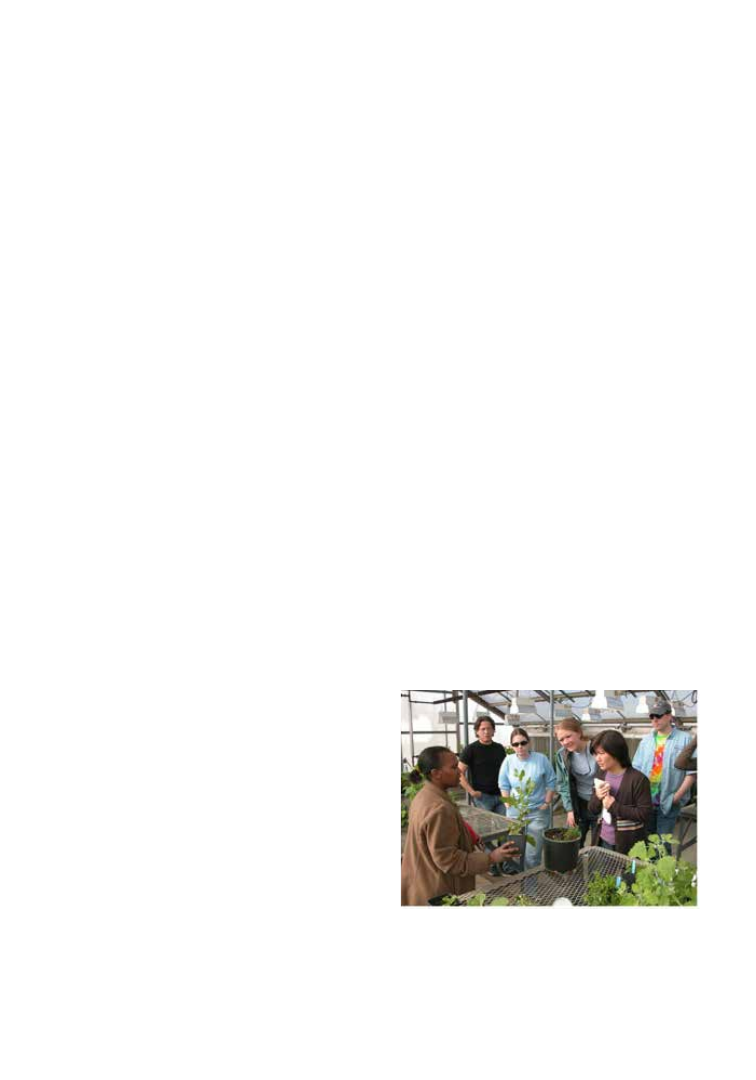
PSB 62 (2) 2016
90
Articles
The most plausible conclusion is that by
comparison with Shakespeare’s day, botanical
literacy of the general populace has gone
downhill in modern London, and by
extension, other urban environments. Given
the proximity of Shakespearean audiences
to nature, and the lack of such proximity
in modern urban populations, this isn’t a
shocking conclusion. Common sense dictates
that rural populations will, collectively,
have a more extensive knowledge of nature
than urban populations, and you can take
your pick of academic studies that support
this conclusion. For example: Among 507
modern German adolescents, urban settings
and preferences had a negative correlation
with knowledge of trees and herbs relative
to settings and preferences closer to nature
(Lückmann and Menzel, 2014). In general,
urbanization results in lower population
exposure to natural biodiversity (Turner
et al., 2004). These processes have bearing
on a current, much discussed perspective
regarding botanical literacy, “plant blindness.”
Plant Blindness
First introduced as a pedagogical term in
education (Wandersee and Schussler, 1998),
the term “plant blindness” soon evolved to
a theory (Wandersee and Schussler, 2001).
Essentially, it’s held that current learning
about organisms is zoocentric, resulting in
diminished knowledge about plants relative
to knowledge about animals (Hershey, 2002;
Strgar, 2007; Schussler and Olzak, 2008),
although there may be deeper explanations:
“Instead of invoking zoological biases as
the root cause, there may well be a visual-
cognitive-societal basis for why plants …
are frequently ignored or undervalued”
(Wandersee and Schussler, 2001). But whether
by conspiracy, design, or social evolution, it’s
usually held that animals are more engaging
than plants.
A variety of strategies including online
learning, plant-based learning modules
and laboratory exercises (Fig. 2) have been
designed to counteract plant blindness
(Hemingway et al., 2011; Uno, 2009). The
idea is that somehow, there must be a way that
teachers can make fir trees or pampas grass
as exciting as baby pandas. For example, an
intensive survey of 1299 Viennese secondary
students (grades 5-12) strongly indicated that
medicinal plants and “stimulant herbal drugs”
(sage and belladonna are later specified, but
one can guess about some others) are of
greater interest than ornamental or edible
plants (Pany, 2014). To successfully build
on the children’s interest, plants in the first
two categories should be emphasized for
teaching: “No time should be wasted on plants
considered as uninteresting” (Pany, 2014).
This is not great news for agronomists wanting
to reach out to young urban students, but it
probably accurately reflects views of city kids.
Unsurprisingly, the most consistent interest
across grades was in stimulants, a somewhat
problematic teaching vehicle.
Figure 2. Students, well-recovered from plant
blindness, inspect one of their chlorophyllous friends
(from Washington State University Department of
Plant Pathology, http://plantpath.wsu.edu).

PSB 62 (2) 2016
91
Articles
There are also studies of children’s knowledge
of animals (e.g., Balmford et al., 2002;
Genovart et al., 2013; Westervelt, 1984).
Moreover, historical folklore collected in
broad or restricted locales at specified dates
can be examined for ethnozoological or
ethnobotanical relevance. But comparisons
with contemporary knowledge about animals
seem even more fraught with difficulty than
the comparison above. I know of no published
source enabling comparison of historical
ethnozoological knowledge with that of
contemporary knowledge in a specific locale,
analogous to use of Shakespeare in making
comparison to Bebbington (2005). Based on
experience, I assert that urban children are
more likely to have diminished knowledge of
animals (as well as plants) relative to children
who have grown up experiencing the zoobiota
of farms, fields, and forests, an assertion
commensurate with Lückmann and Menzel
(2014) and Turner et al. (2004). Accordingly,
a very legitimate hypothesis is that separation
from nature and agriculture—“nature
deficit disorder” (Louv, 2008)—is the factor
primarily responsible for plant blindness.
Unsurprisingly, the connection between
nature deficit disorder and plant blindness is
explored in education literature (e.g., Frisch et al.,
2010).
Electronic Media
The closest most kids get to genuine
enthusiasm for botany is the video game Plants
vs. Zombies (Popcap Games, Seattle). (If you
don’t know what this is, kids will think you’re
mentally deficient.) You may have noticed
that despite the attraction of children to video
games, there is virtually no deployment of
analogously colorful, fast-paced, interactive
gaming for legitimate learning in chemistry,
biology, history, etc. Admittedly, there are a
few tentative steps, e.g., Klopfer et al. (2012),
on a game with cartoon characters and
competition for understanding weather data,
or see Sadler et al. (2013) on a “game-based
curriculum” in high school biology. Typical
is Herrero et al. (2014), who advance claims
that playing the commercial videogame Spore
(Electronic Arts, Redwood City, California)
promotes understanding of biological
evolution.
It is conceivable that video games could,
instead of constituting a distraction from
nature, actually teach serious botany. Xylem
transport could be illustrated in a manner
similar to our own innards in Fantastic Voyage
(1966), but of course faster-paced. Sort of like
Harvard University’s and XVIVO’s Inner Life
of the Cell series, (e.g., 2006 www.xvivo.net/
animation/the-inner-life-of-the-cell/; 2013
www.xvivo.net/animation/harvard-protein-
packing/) but with elements of competition.
Of course, there has to be funding. And
something in the game has to explode. If this
can be done, there is a chance that significant
numbers of the younger set will voluntarily
use technology to actually look at living plants.
Some might even want to become botanists.
Conclusions
The disconnect between modern urban life
and nature (including agriculture) seems
ubiquitous and persistent, resulting not
only in “plant blindness” but in a broader
“nature deficit disorder.” The inability of a
contemporary urban population to recognize
common wildflowers familiar to a much
earlier urban population of the same locale
is a symptom of this disconnect, as is the
gap between rural and urban populations
in familiarity with products of nature. Thus
far, electronic media beloved of urban youth
represent a distraction from nature, but also
represent a potential venue to restore interest
in the world of nature and agriculture.

PSB 62 (2) 2016
92
Acknowledgements
The author thanks Lori Carris and Sian
Ritchie for constructive harassment on the
manuscript.
Literature Cited
Allen, D. E., and G. Hatfield. 2004. Medicinal
Plants in Folk Tradition: An Ethnobotany of Brit-
ain & Ireland. Timber Press, Portland, Oregon.
Archer, J. E., R. M. Turley, and H. Thomas. 2012.
The autumn king, remembering the land in King
Lear. Shakespeare Quarterly 63: 518-543.
Artese, C. 2015. Shakespeare’s Folktale Sources.
University of Delaware Press, Newark.
Balmford, A., T. Coulson, and J. Taylor. 2002.
Why conservationists should heed Pokémon. Sci-
ence 295: 2367.
Bebbington, A. 2005. The ability of A-level stu-
dents to name plants. Journal of Biological Edu-
cation 39: 63-67.
Beith, M. 1995. Healing Threads: Traditional
Medicines of the Highlands and Islands. Birlinn,
Edinburgh.
Clarke, C. and M. L. Clarke (eds). 1864. Cassell’s
Illustrated Shakespeare: The Plays of Shake-
speare Vol. III. Tragedies. Cassell, Petter, and
Galpin. London.
Clayton, N. 2003. Weeds, people and contested
places. Environment and History 9: 301-331.
Cook, P. 1940. William Shakespeare, botanist.
Shakespeare Association Bulletin 15: 149-165.
Darbyshire, S. J., R. Hoeg, and J. Haver-
kort. 1999. The biology of Canadian weeds.
111. Anthriscus sylvestris (L.) Hoffm. Cana-
dian Journal of Plant Science 79: 671–682.
Drury, S. 1985. Herbal remedies for livestock
in seventeenth and eighteenth century England:
Some examples. Folklore 96: 243-247.
Dugan, F. M. 2015. Kitchen witches: Facts, folk-
lore, and fakelore on the transfiguration of the
herb-women, pp. 101-121 in: Hidden Histories
and Ancient Mysteries of Witches, Plants, and
Fungi. APS Press, St. Paul.
Ellacombe, H. N. 1884. The Plant-Lore and Gar-
den-Craft of Shakespeare, 2nd ed. W. Satchel &
Co., London.
Elton, C. I. 1904. William Shakespeare: His Fam-
ily and Friends. E.P. Dutton & Co., New York.
Frisch, J. K., M. M. Unwin, and G. W. Saunders.
2010. Name that plant! Overcoming plant blind-
ness and developing a sense of place using science
and environmental education, pp. 143-157 in: The
Inclusion of Environmental Education in Science
Teacher Education, A.M. Bodin, B.S. Klein and
S. Weaver (eds), Springer, New York.
Genovart, M., G. Tavecchia, J. J. Enseñat, and P.
Laiolo. 2013. Holding up a mirror to the society:
Children recognize exotic species much more
than local ones. Biological Conservation 159:
484–489.
Grieve, M. 1931. A Modern Herbal (2 volumes).
Harcourt, Brace & Co., New York. 902 pp.
Grindon, L.H. 1883. The Shakespeare Flora: A
guide to all the principal passages in which men-
tion is made of Trees, Plants, Flowers, and Vege-
table Productions. Palmer & Howe, Manchester.
Hemingway, C., W. Dahl, C. Hauffler, and C.
Stuessy. 2011. Building botanical literacy. Sci-
ence 331: 1535-1536.
Herrero, D., H. del Castillo, N. Monjelat, A. B.
García-Varela, M. Checa and P. Gómez. 2014.
Evolution and natural selection: learning by play-
ing and reflecting. New Approaches in Education-
al Research 3: 26-33.
Hershey, D. R. 2002. Plant blindness: “We have
met the enemy and he is us.” Plant Science Bulle-
tin
48(3): 78–85.

PSB 62 (2) 2016
93
Klopfer, E., J. Sheldon, J. Perry, and V. H. H.
Chent. 2012. Ubiquitous games for learning
(UbiqGames): Weatherlings, a worked example.
Journal of Computer Assisted Learning 28: 465–
476.
Lamb, M. E. 2007. The Popular Culture of Shake-
speare, Spenser and Jonson. Routledge, New York.
Lever, J. W. 1952. Three notes on Shakespeare’s
plants. Review of English Studies 3: 117-129.
Louv, R. 2008. Last Child in the Woods: Saving
Our Children from Nature Deficit Disorder. Al-
gonquin, New York.
Lückmann, K., and S. Menzel. 2014. Herbs vs.
trees: Influences on teenager’s knowledge of plant
species. Journal of Biological Education 48: 80-90.
Pany, P. 2014. Students’ interest in useful plants:
A potential key to counteract plant blindness.
Plant Science Bulletin 60: 18-25.
Porter, S. 2009. Shakespeare’s London: Everyday
Life in London, 1580-1616. Amberley, The Hill,
Stroud, Gloucestershire.
Rydén, M. 1978. Shakespearean Plant Names:
Identifications and Interpretation. Acta Universi-
tatis Stockholmiensis. Stockholm.
Sadler, T. D., W. L. Romine, P. E. Stuart, and D.
Merle-Johson. 2013. Game-based curricula in bi-
ology classes: Differential effects among varying
academic levels. Journal of
Research in Science
and Teaching 50: 479-499.
Savage, F. G. 1923. Shakespeare’s Flora &
Folklore: Old-time Customs, Natural Histo-
ry and uses of nearly two hundred Flowers,
Fruits, Herbs, Nuts, Plants, Shrubs, Trees,
Vegetables, etc. mentioned in the Plays and
Poems. Shakespeare Press, Stratford-on-Avon.
Schussler, E.E., and L.A. Olzak. 2008. It’s not
easy being green: student recall of plant and an-
imal images. Journal of Biological Education
42:112-119.
Simpson, J. 1995. “The Weird Sisters Wander-
ing”: Burlesque witchery in Montgomerie’s Fly-
ting. Folklore 106: 9-20.
Strgar, J. 2007. Increasing the interest of students
in plants. Journal of Biological Education 42: 19-23.
Tabor, E. 1970. Plant poisons in Shakespeare.
Economic Botany 24: 81-94.
Thiselton Dyer, T. F. 1884. Folk-Lore of Shake-
speare. Harper & Brothers, New York.
Thomas, V., and N. Faircloth. 2014. Shakespeare’s
Plants and Gardens. Bloomsbury, London.
Tuan, Y.-F. 1978. The city: Its distance from na-
ture. Geographical Review 68: 1-12.
Turner, W. R., T. Nakamura, and M. Dinetti.
2004. Global urbanization and the separation of
humans from nature. Bioscience 54: 585-590.
Uno, G. E. 2009. Botanical literacy: What and
how should students learn about plants? Ameri-
can Journal of Botany 96: 1753-1759.
Vickery, R. 2010. Garland’s, Conkers and Moth-
er-Die: British and Irish Plant Lore. Continuum,
London.
Wandersee, J. H., and E. E. Schussler. 1998. A
model of plant blindness. 3rd Annual Associates
Meeting of the 15˚ Laboratory, Louisiana State
University, Baton Rouge.
Wandersee, J. H., and E. E. Schussler. 2001. To-
ward a theory of plant blindness. Plant Science
Bulletin 47: 2-9.
Westervelt, M. O. 1984. A provocative look at
young people’s perceptions of animals. Chil-
dren’s Environments Quarterly 1: 4-7.
Wheatley, H. B. 1916. The folklore of Shake-
speare. Folklore 27: 378-407.
Willes, M. 2015. A Shakespearean Botanical.
Bodleian Library, Oxford.

94
SCIENCE EDUCATION
By Catrina Adams,
Education Director
BSA Science Education News and Notes is a
quarterly update about the BSA’s education
efforts and the broader education scene. We
invite you to submit news items or ideas for
future features. Contact Catrina Adams, Ed-
ucation Director, at cadams@botany.org.
USA Science & Engineering Festival:
“Plants Move, Plants Matter”
Booth Draws Thousands of Visitors
This April, BSA joined the U.S. Botanic
Garden, the American Society for Plant
Biologists, the Donald Danforth Plant Science
Center, Society for Economic Botany, and
Rutgers University in a large, five-part, 600
square foot “Plant Presence” booth at the USA
Science and Engineering festival (USASEF).
Over the course of three days, over 365,000
people attended the festival, and thousands
stopped by the plants booth to explore hands-
on activities and demonstrations around
seeds, flowers, roots, stems, and leaves.
The BSA “leaf” part of the booth included
a working model of a Venus flytrap with
trigger hairs created by Rutgers Mechanical
Engineering undergraduate students Adam
Burrous and Valeria Saro-Cortes (Figure 1),
a leaf adaptation origami game developed by
Jennifer Blake Mahmud (Rutgers) and Catrina
Adams (Figure 2), and a chloroplast movement
“leaf print” demonstration implemented with
help from Holly Gorton (St. Mary’s College
of Maryland) and Terry Woodford Thomas
(Donald Danforth Plant Science Center).
Visitors loved seeing our model Venus flytrap
and learning more about its sophisticated
triggering mechanism, as well as taking a
closer look at the live Venus flytrap on display,
courtesy of the U.S. Botanic Garden. The
origami game was very popular with upper
elementary and middle school students,
and many teachers took full sets to use in
their classrooms. The leaf print and video of
chloroplast movement fascinated many by
showing a kind of plant movement of which
few were aware.
We could not have pulled off the event without
help from many D.C. area volunteers. Thanks
to Monica Carlsen, Betsy Collins, Greg Perrier,
Caroline Puente, Jonathan Singer, and Martha
Weiss for your help at the event!

PSB 62 (2) 2016
95
Science Education
The activities that were developed and piloted
at USASEF will be added to U.S. Botanic
Garden programming, and the model Venus
flytrap will continue to be used at the U.S.
Botanic Garden.
Botany Booth in a Box
Outreach Competition
We are looking forward to the first BSA
outreach competition at this year’s Botany
Conference in Savannah. We had over 20
submissions and are looking forward to live
demonstrations by the semifinalists during the
opening reception in the exhibit hall this year.
If you will attend this year’s annual meeting,
please join us to see what outreach activities
your colleagues have developed, and cast your
votes for this year’s winners!
PlantingScience Seeking
100 New Mentors for Fall
2016 as Improved Website
Launched
PlantingScience, our online science mentoring
program, is looking for 100 new scientist
mentors to join the program to work with
middle- and high-school students on student-
designed projects around eight themes in plant
biology, from seed germination to Arabidopsis
genetics. We are in the process of launching a
new and improved PlantingScience website,
http://dig.plantingscience.org, which has a
much bigger capacity to serve more teachers
and students each year.
We are very excited to finally be growing our
capacity to help more students, but it means
that we now have an increased demand for
scientist mentors to work with those students.
Mentoring a team or two takes only about
an hour a week, can be done from anywhere
with an internet connection, and is a great
way to connect with middle- and high-school
students to share your passion for plants and
science. If you have not mentored before,
please consider giving it a try this fall. If you
have been mentoring already, please share this
opportunity with your colleagues! Sign up to
be notified when registration opens on the
new website at: https://dig.plantingscience.
org/community/joinplantingscience/
becomeamentor.
For graduate students and post-docs, we also
offer an opportunity to serve as a Master Plant
Science Team (MPST) member. Members
of this team serve in enhanced roles, both
mentoring and serving as liaisons between
a teacher and his or her other mentors. In
exchange for a larger role, we offer MPST
members a free BSA membership and 50%
off meeting registration for the following year.
The deadline for MPST applications is August
8, 2016.
Figure 1. Rutgers mechanical engineering un-
dergraduate student Adam Burrous shows vis-
itors how trigger hairs work using the working
Venus flytrap model that he and Valeria Saro-
Cortes built as their senior capstone project

PSB 62 (2) 2016
96
Science Education
Digging Deeper Together:
Collaborative Teacher/Sci-
entist Professional Develop-
ment Launches this Summer
We are looking forward to two exciting
weeks of professional development this
summer in Colorado Springs, CO. As part
of a collaborative NSF grant, we are bringing
together 34 high-school teachers and 20 early-
career scientist “PlantingScience Fellows” to
work collaboratively over the summer and into
the fall to improve students’ PlantingScience
projects and the way students think about
photosynthesis, plants, and science and what
it means to be a plant scientist. This team
will be working closely together during the
fall PlantingScience session, co-mentoring
students through their PlantingScience
projects.
Congratulations to this year’s PlantingScience
Fellows: Steven Callen, Julia Chapman, Kevin
Dorn, Chloe Drummond, Kate Eisen, Kate
Eisen, Nathanial Frein, Ben Gahagen, Julie
Herman, Kevyn Juneau, Kelly Ksiazek, Jacob
Landis, Jesse Mayer, Alex Pilote, Jerald Pinson,
Devesh Shukla, Andries Temme, Amanda
Tracey, Erika Valek, Catherine Vrentas, and
Martha Zwonitzer. Thanks also to scientist
mentor leaders Susan Bush and Eric Jones,
and teacher leaders Kim Parfitt and Kara
Butterworth.
DON’T MISS
BOTANY 2016:
CELEBRATING OUR HISTORY,
CONSERVING OUR FUTURE
http://botanyconference.org/
An exciting number of education,
outreach and training offerings for
you to consider:
Workshops on:
• Making a Visual Key: A Lab Exercise
with Practical Consequences
• Planting Inquiry in Science Class-
rooms
• Using Visual Learning to Improve
Comprehension
• Web-based Retrieval Practice as a
Self-Directed Study Tool for Students
in Botany and Plant Taxonomy
Symposium “The Importance of
Communicating Science”
Professional Development workshops
for students:
• Botanical Career Panel
• Applying to Graduate School: Tips
for Success
• We are All Plumbers Now: Toolbox-
es for Building Unconventional STEM
Career Pipelines
Don’t miss the Teaching Section
presentations and posters, and the
PlantingScience mixer.
Check the website for updates and
schedule.

97
STUDENT SECTION
By Angela McDonnell and Becky
Povilus, BSA Student Representatives
The BOTANY conference is quickly
approaching! With 6 days of lectures, field
trips, workshops, socials, and more, where
does one start and how can you get the most
out of your experience? Check out our tips
and links below for some ideas!
Travel and Lodging
Travel Grants. Although it is too late to apply
for this year, you can take advantage of the many
travel grants next year. Keep these on your radar
next spring! You can find them online at http://
www.botany.org, then click Awards, scroll to
Travel awards for students, then a list will pop up
with links to each of the following:
• PLANTS grants are funded by NSF and BSA
to bring talented and diverse undergraduates
to the meeting.
• Triarch Botanical Images Awards provide
acknowledgement and travel support to BSA
meetings for outstanding student work in the
area of creating botanical digital images.
• Section Awards are worth checking out.
There are many to choose from, so be sure to
check with your sections!
• Vernon I. Cheadle Awards are generally giv-
en to students who are presenting in a session
sponsored by the Developmental and Struc-
tural Section
Find a Roommate. Split your hotel costs
by sharing a room with a roommate! Take
advantage of the 2016 BOTANY Housing
Partner Finder: http://images.botany.org/
roommate.shtml. Besides saving you $$$, it
can be a great way to connect with your peers
and make new friends and contacts.
Getting the Most out of
BOTANY 2016: A Guide for Students

PSB 62 (1) 2016
Student Section
98
Volunteer at the Conference. Did you
know that you can earn back your early
registration fee by volunteering your time
at the conference? The conference couldn’t
happen without the help of students to run the
registration booth, help at ticket events, and
make sure that sessions run smoothly. These
opportunities are limited each year and are
actually unavailable for BOTANY 2016, but
keep this in mind next spring for next year’s
conference!
Highlights for Students
Workshops: There are so many to choose
from! Two are specifically aimed at students:
• “Applying to Graduate School: Tips for
Success,” led by Anna Monfils, is a panel dis-
cussion designed to introduce undergradu-
ate students to the specific requirements for
applying to graduate programs in plant biol-
ogy. (Free)
• “Crafting an Effective Elevator Speech and
Communicating Broader Impacts of your
Work,” led by your friendly neighborhood
BSA student reps. The workshop features
tips from Doug Soltis, and time with your
peers to help you create an elevator speech
of your own, just in time for use during the
conference. ($10)
Student Luncheon: A Focus on Careers
in Botany. What can you do with a degree
in botany? Come find out at the Student
Luncheon! Pam Diggle will speak about
publishing, and then you’ll get a chance to talk
to representatives from various career paths
in a “speed-dating” format. You’ll even get a
delicious catered lunch! ($5)
Botanical Career Panel. Organized by Susan
Pell from the US Botanic Garden, this panel
will be held Monday afternoon and includes
professionals with botanical degrees who
will discuss their professional experiences
and answer participants’ questions. The
moderator will facilitate an open discussion
designed to address opportunities in the post-
undergraduate and post-graduate job markets.
(Free)
Poster Session. Whether you are presenting
your own work or just there to see what
people are working on, this is a great time to
talk science, learn about cutting-edge plant
research, and meet people! Poster sessions will
happen on August 1 and 2. Be sure to check out
a detailed schedule on the web at http://2016.
botanyconference.org/engine/search/ or via
the Botany Conference App, which will be
available soon! (Free)
Celebrating 10 years of BSA Student Reps:
Come Meet your Reps! Time flies—it’s already
been 10 years since the first BSA student reps
were appointed as board members to help the
Society meet the needs of student members.
Come meet the past and present reps, and
learn about what we do for the society… and
why you might want to become one! We’ll be
meeting 1 hour before the Student Social and
Networking Event (see below), at the Moon
River Brewing Company, which is walking
distance from the conference center at 21 W
Bay St, Savannah, GA 31401. (Free)
Student Social and Networking Event. A
favorite event for many! This year we’ll be
at the Moon River Brewing Company…
reportedly one of the most haunted buildings
in Savannah! Come catch up with old friends
and meet new ones while enjoying craft brews,
munchies, and a gorgeous beer garden. It’s easy
to add a ticket for this event (which includes a
drink ticket!) to your conference registration:
Find a link to register for the conference at
2016.botanyconference.org, and click “Modify
Registration.” A special thanks to our sponsor,

PSB 62 (1) 2016
Student Section
99
International Journal of Plant Sciences, for
making this event possible! ($5)
Field trips. Savannah has a rich history and
diverse local ecosystems, and you can explore
it first-hand with local experts! This year, 11
different field trips are being offered; you can
choose from tours of history sites, kayak trips,
and hiking trails that showcase the flora and
fauna. Also be sure to check out the Botany
in Action trip—you can help give a beloved
urban park some TLC! (cost varies by field trip)
A special note about field trips and student
members of the BSA Systematics Section: Did
you know that ASPT and/or BSA Systematics
Section members are eligible for field trip
grants? Send Jim Cohen an e-mail message
(jcohen@kettering.edu) after you register
for the field trip. Include your name, e-mail
address, affiliation, mailing address, whether
you are an ASPT or BSA Systematics Section
member, and the field trip title. You could be
reimbursed for up to $100!
For most ticketed events, it’s not too late to
register! Tickets for these events are easy to
add to your conference registration: Find the
link to register for the conference on the web
at botanyconference.org, and click “Modify
Registration.”
The BOTANY Conference App!
Schedule Planner. With so much going on
during the conference, planning your days
can be a challenge. The online BOTANY
Conference App lets you browse talks and
events and then add the ones you want to a
schedule that you can check online, so you can
stay on track. BSA members can download the
app at https://dl.doubledutch.me/download.
aspx?appId=a9832a5e-fd6a-4fee-9c76-
fde1f8e41ba3®ion=us.
Share your BOTANY experience! Social media
allows you to share your experiences at the
conference, and the number of tweets, posts,
likes, and shares are growing every year. The
social media aspect lets you share your photos
and thoughts throughout the conference,
and it can be a way to share your work and
increase your visibility. It’s a great way to see
what is going on and keep tabs on all your
conference buddies! Use the #BOTANY2016
hashtag when discussing the conference!
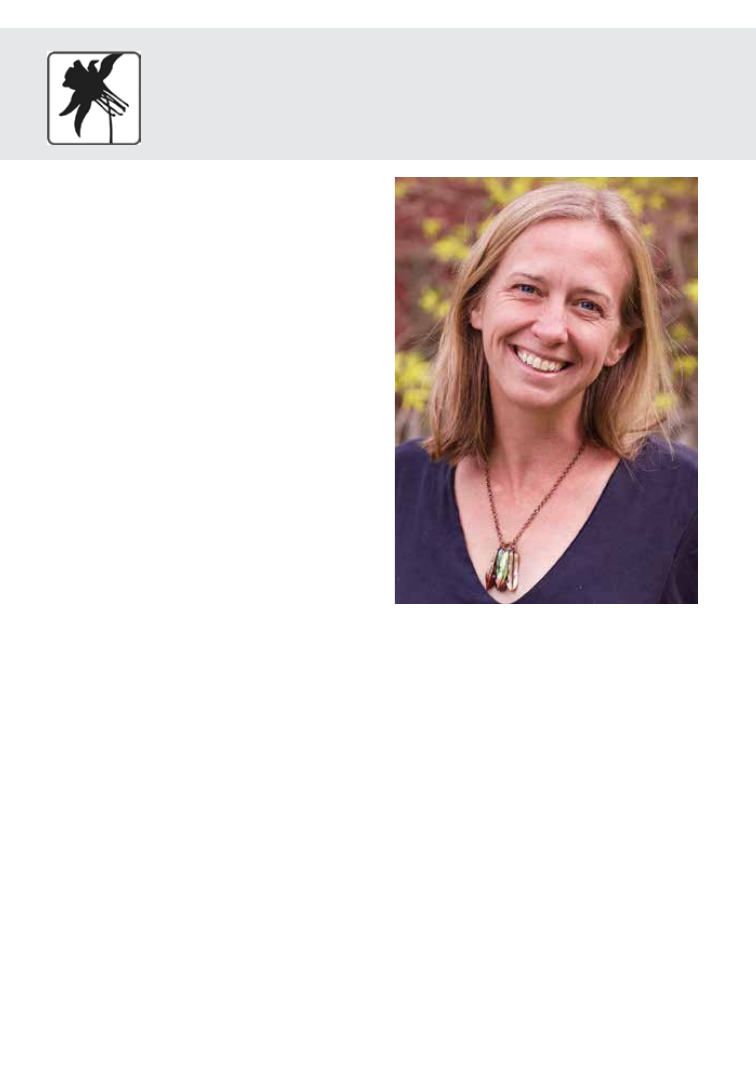
100
ANNOUNCEMENTS
Linnean Society of London
Meeting at the
Arnold Arboretum
On May 6-8, 2016, 60 Fellows of the Linnean
Society met at the Arnold Arboretum for a
historic meeting of the Linnean Society—
the first in North America since its founding
in 1788. Ned Friedman, Director of the
Arboretum, together with Linnean Society
Past-President Dianne Edwards, planned
the meeting as an opportunity for American
members to participate in a “Burlington
House” type of meeting with scientific
papers and an induction of new Fellows
(who ordinarily must travel to the annual
Anniversary Meeting in London to formalize
their election by signing the Fellows roll).
The botany was well represented with papers
presented by: BSA Corresponding Member
Diane Edwards, Ned Friedman, Robin
Hopkins, Sandy Knapp, Jan Salick, Dennis
Stevenson, and Marsh Sundberg. Other
Fellows in attendance, with BSA connections,
included: Peter Crane, Pamela Diggle, Vicki
Funk, Cynthia Jones, Ed Schneider, Lena
Struwe, Barry Tomlinson, and Joe Williams.
BSA Member
Erika Edwards Receives
Presidential Early Career
Award
Erika Edwards, associate professor of ecology
and evolutionary biology at Brown University,
was awarded the Presidential Early Career
Award for Scientists and Engineers. Edwards
was among 105 honorees who received this,
the U.S. government’s highest award for
engineers and scientists in the early stages
of their independent research careers, at the
White House in May.
The National Science Foundation nominated
Dr. Edwards for her “innovative research
[Edwards headshot]
Erika Edwards
Image: Casey Dunn, Brown University
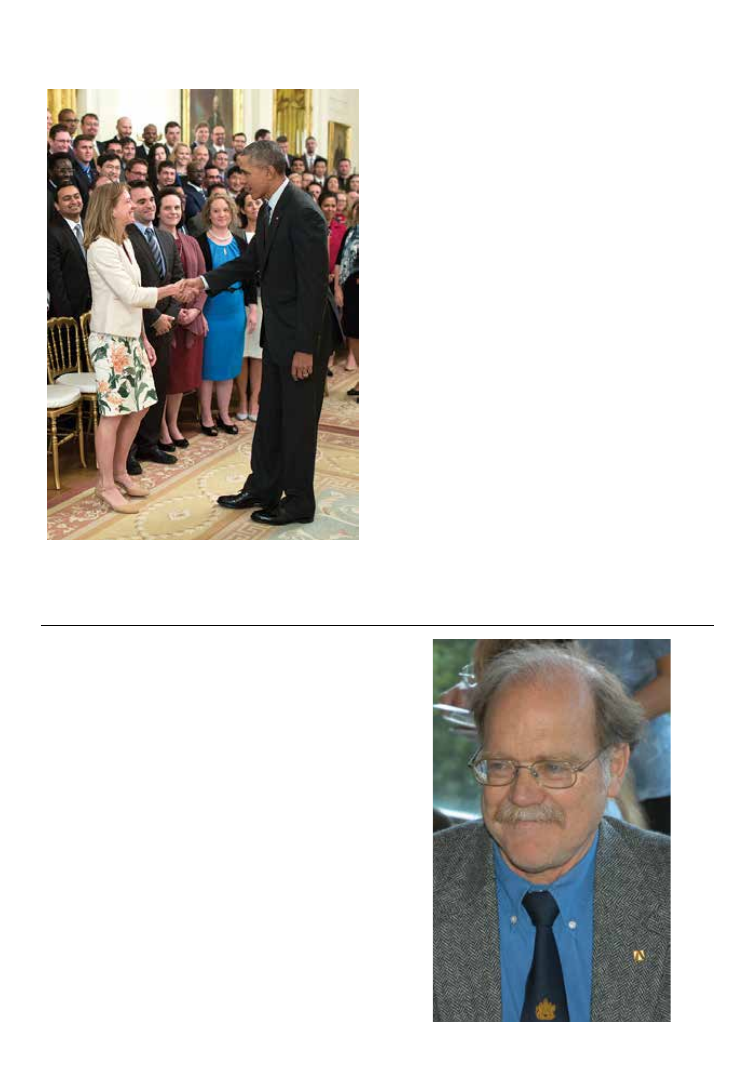
PSB 62 (2) 2016
101
Announcements
leading to exciting breakthroughs in
understanding the drivers of plant
evolutionary innovation, and particularly the
evolution of plant form and photosynthesis
systems, and for engaging public outreach on
plant biology.”
“What makes this so special for me is that we
do not work on human health, or medicine...
we are not engineers; we are botanists,”
Edwards said in a press release from Brown
University. “My lab is an evolutionary
biology lab, and our primary focus is on
understanding how different plant species
are related to one another, and how they have
adapted to climate change and the emergence
of new environments over deep evolutionary
time. It is wonderful to have this type of
science recognized as important for humanity
and relevant to our current challenges. We
have a lot to learn from history, and that
certainly includes natural history - nature is
full of inspiring and elegant solutions to big
problems.”
President Barack Obama greets Erika Edwards
at the White House.
Marshall Sundberg Named
2016 Roe R. Cross
Distinguished Professor
Long-time BSA member Marshall
Sundberg was named the 2016 Roe R.
Cross Distinguished Professor at Emporia
State University. This award, established
in 1979 to honor the ESU professor who
“best demonstrates teaching excellence,
professional activities, fostering of
intellectual atmosphere, service to the
university outside the classroom and status
as a student mentor” is the highest teaching
award given by the University.
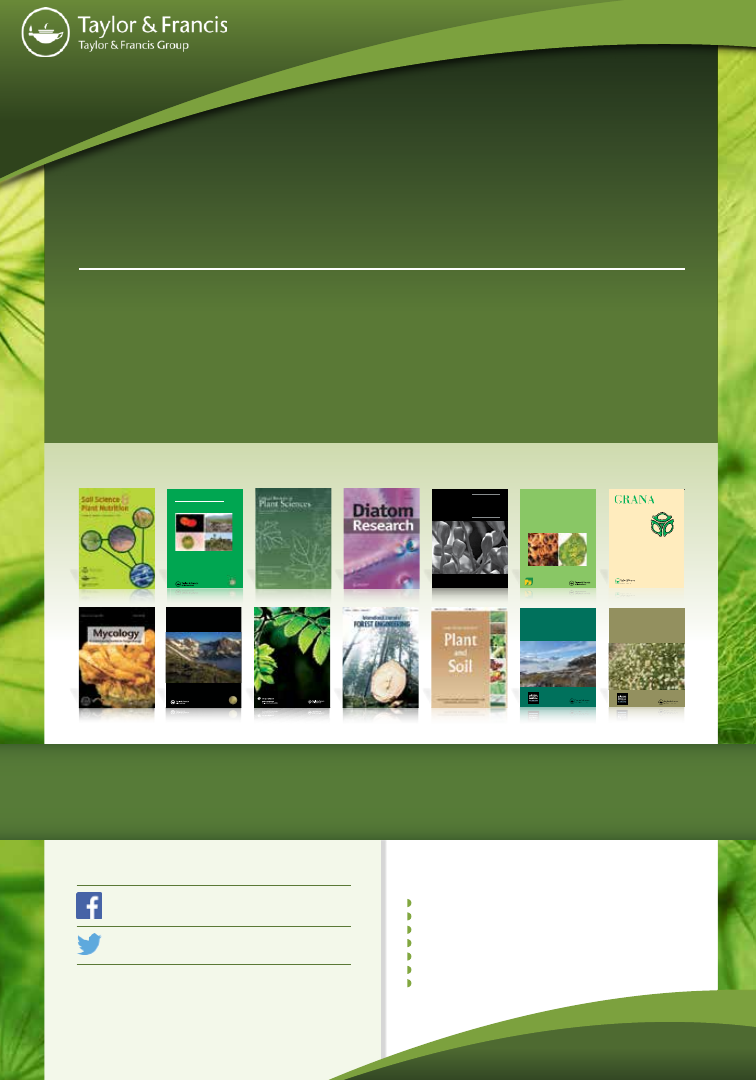
Taylor & Francis boasts a growing, wide-ranging and high calibre journals portfolio in Plant Sciences. Our journals
are edited by some of the most prominent academics in their fields. We are partnered with an array of the world’s
leading societies, such as the Arboricultural Association, Botanical Society of Scotland, British Phycological
Society, Canadian Phytopathological Society, Forest Products Society, International Society for Diatom Research,
Japanese Society of Soil Science and Plant Nutrition, Mycological Society of China, Nordic Forest Cooperation
Committee, Royal Society of New Zealand, Société Botanique de France and the Università degli Studi di Firenze,
to publish cutting-edge, high quality research across the spectrum of Plant Sciences.Taylor & Francis is at the
forefront of the publishing landscape for researchers who seek to further their disciplines with their work.
Botany and
Plant Sciences
Journals from Taylor & Francis
FREE
ACCESS
Discover and order
Agricultural Science at
www.crcpress.com
www.tandfonline.com
Don’t miss out!
Visit the journals’ homepages at
www.tandfonline.com
to:
w
Submit your research
w
Register for table of contents alerts
w
Discover most read, most cited and free articles
w
Access the journals’ latest news and offers
w
Purchase online access to back issues
w
View the full Editorial Board
w
Recommend the journal to your library
The Botany and Plant Sciences portfolio includes:
Discover our Botany and Plant Sciences portfolio
explore.tandfonline.com/content/est/plant
Become a fan on Facebook
www.facebook.com/tandfplantsciences
Register your email to receive information on journals and books
in your subject area
www.tandfonline.com/eupdates
Follow us on Twitter
www.twitter.com/tandfplant
The Botany and Plant Sciences portfolio includes:
P
lant E
colog
y & D
iv
ersity
Volume
8 N
umbers
5–6 O
ctober–December
2015
Plant Ecology & Diversity
Volume 8 Numbers 5–6 October–December 2015
Monographs in Long Term High Mountain Ecological Research - the Niwot Ridge
Long Term Ecological Research Site, 1995–2015
Contents
Monographs in Long Term High Mountain Ecological Research - the Niwot Ridge Long Term Ecological
Research Site, 1995–2015
Laszlo Nagy
595
An overview of research from a high elevation landscape: the Niwot Ridge, Colorado Long Term Ecological
Research programme
Mark W. Williams, Timothy R. Seastedt, William D. Bowman, Diane M. McKnight and Katharine N. Suding 597
Contrasting long-term alpine and subalpine precipitation trends in a mid-latitude North American
mountain system, Colorado Front Range, USA
Timothy G.F. Kittel, Mark W. Williams, Kurt Chowanski, Michael Hartman, Todd Ackerman, Mark Losleben
and Peter D. Blanken
607
Cryosphere: ice on Niwot Ridge and in the Green Lakes Valley, Colorado Front Range
Matthias Leopold, Gabriel Lewis, David Dethier, Nel Caine and Mark W. Williams 625
The ‘teflon basin’ myth: hydrology and hydrochemistry of a seasonally snow-covered catchment
Mark W. Williams, Eran Hood, Noah P. Molotch, Nel Caine, Rory Cowie and Fengjing Liu 639
Fluxes of energy, water, and carbon dioxide from mountain ecosystems at Niwot Ridge, Colorado
John F. Knowles, Sean P. Burns, Peter D. Blanken and Russell K. Monson 663
Winter gas exchange between the atmosphere and snow-covered soils on Niwot Ridge, Colorado, USA
Daniel Liptzin, Detlev Helmig, Steven K. Schmidt, Brian Seok and Mark W. Williams
677
Limnology of the Green Lakes Valley: phytoplankton ecology and dissolved organic matter biogeochemistry
at a long-term ecological research site
Matthew P. Miller and Diane M. McKnight
689
Plant–microbe interactions at multiple scales across a high-elevation landscape
Steven K. Schmidt, Andrew J. King, Courtney L. Meier, William D. Bowman, Emily C. Farrer, Katharine N. Suding
and Diana R. Nemergut
703
Vegetation change at high elevation: scale dependence and interactive effects on Niwot Ridge
Katharine N. Suding, Emily C. Farrer, Andrew J. King, Lara Kueppers and Marko J. Spasojevic 713
A slide down a slippery slope – alpine ecosystem responses to nitrogen deposition
William D. Bowman, Diana R. Nemergut, Diane M. McKnight, Matthew P. Miller and Mark W. Williams 727
Plant community response to nitrogen and phosphorus enrichment varies across an alpine tundra
moisture gradient
Eve I. Gasarch and Timothy R. Seastedt
739
The consequences of multiple resource shifts on the productivity and composition of alpine tundra communities:
inferences from a long-term snow and nutrient manipulation experiment
Eve I. Gasarch and Timothy R. Seastedt
751
The forest–alpine ecotone: a multi-scale approach to spatial and temporal dynamics of treeline change
at Niwot Ridge
Patrick S. Bourgeron, Hope C. Humphries, Daniel Liptzin and Timothy R. Seastedt 763
Of plants and pikas: evidence for a climate-mediated decline in forage and cache quality
Sabuj Bhattacharyya and Chris Ray
781
Children’s book series and associated curricula support elementary education and outreach in water resources
Chris Ray, Diane M. McKnight, Marcie D. Bidwell, Tiffany Fourment, Colleen Flanagan Pritz and Amy H. Rinehart 795
Plant Ecology
& Diversity
Volume 8 Numbers 5–6 October–December 2015
ISSN 1755-0874
8
mm
Monographs in Long Term High Mountain Ecological
Research - the Niwot Ridge Long Term Ecological
Research Site, 1995–2015
TPED_COVER_8-05-06.indd 1
25/02/16 7:12 PM
P
lant E
colog
y & D
iv
ersity
Volume
8 N
umbers
5–6 O
ctober–December
2015
Plant Ecology & Diversity
Volume 8 Numbers 5–6 October–December 2015
Monographs in Long Term High Mountain Ecological Research - the Niwot Ridge
Long Term Ecological Research Site, 1995–2015
Contents
Monographs in Long Term High Mountain Ecological Research - the Niwot Ridge Long Term Ecological
Research Site, 1995–2015
Laszlo Nagy
595
An overview of research from a high elevation landscape: the Niwot Ridge, Colorado Long Term Ecological
Research programme
Mark W. Williams, Timothy R. Seastedt, William D. Bowman, Diane M. McKnight and Katharine N. Suding 597
Contrasting long-term alpine and subalpine precipitation trends in a mid-latitude North American
mountain system, Colorado Front Range, USA
Timothy G.F. Kittel, Mark W. Williams, Kurt Chowanski, Michael Hartman, Todd Ackerman, Mark Losleben
and Peter D. Blanken
607
Cryosphere: ice on Niwot Ridge and in the Green Lakes Valley, Colorado Front Range
Matthias Leopold, Gabriel Lewis, David Dethier, Nel Caine and Mark W. Williams 625
The ‘teflon basin’ myth: hydrology and hydrochemistry of a seasonally snow-covered catchment
Mark W. Williams, Eran Hood, Noah P. Molotch, Nel Caine, Rory Cowie and Fengjing Liu 639
Fluxes of energy, water, and carbon dioxide from mountain ecosystems at Niwot Ridge, Colorado
John F. Knowles, Sean P. Burns, Peter D. Blanken and Russell K. Monson 663
Winter gas exchange between the atmosphere and snow-covered soils on Niwot Ridge, Colorado, USA
Daniel Liptzin, Detlev Helmig, Steven K. Schmidt, Brian Seok and Mark W. Williams
677
Limnology of the Green Lakes Valley: phytoplankton ecology and dissolved organic matter biogeochemistry
at a long-term ecological research site
Matthew P. Miller and Diane M. McKnight
689
Plant–microbe interactions at multiple scales across a high-elevation landscape
Steven K. Schmidt, Andrew J. King, Courtney L. Meier, William D. Bowman, Emily C. Farrer, Katharine N. Suding
and Diana R. Nemergut
703
Vegetation change at high elevation: scale dependence and interactive effects on Niwot Ridge
Katharine N. Suding, Emily C. Farrer, Andrew J. King, Lara Kueppers and Marko J. Spasojevic 713
A slide down a slippery slope – alpine ecosystem responses to nitrogen deposition
William D. Bowman, Diana R. Nemergut, Diane M. McKnight, Matthew P. Miller and Mark W. Williams 727
Plant community response to nitrogen and phosphorus enrichment varies across an alpine tundra
moisture gradient
Eve I. Gasarch and Timothy R. Seastedt
739
The consequences of multiple resource shifts on the productivity and composition of alpine tundra communities:
inferences from a long-term snow and nutrient manipulation experiment
Eve I. Gasarch and Timothy R. Seastedt
751
The forest–alpine ecotone: a multi-scale approach to spatial and temporal dynamics of treeline change
at Niwot Ridge
Patrick S. Bourgeron, Hope C. Humphries, Daniel Liptzin and Timothy R. Seastedt 763
Of plants and pikas: evidence for a climate-mediated decline in forage and cache quality
Sabuj Bhattacharyya and Chris Ray
781
Children’s book series and associated curricula support elementary education and outreach in water resources
Chris Ray, Diane M. McKnight, Marcie D. Bidwell, Tiffany Fourment, Colleen Flanagan Pritz and Amy H. Rinehart 795
Plant Ecology
& Diversity
Volume 8 Numbers 5–6 October–December 2015
ISSN 1755-0874
8
mm
Monographs in Long Term High Mountain Ecological
Research - the Niwot Ridge Long Term Ecological
Research Site, 1995–2015
TPED_COVER_8-05-06.indd 1
25/02/16 7:12 PM
Volume 53 Number 4 December 2015
ISSN 0028-825X
NEW ZEALAND JOURNAL OF
BOTANY
Biology of Plants, Fungi and Algae of the Southern Hemisphere
Trim Size: 174 X 248 mm
Research articles
Taxonomic notes on the New Zealand flora: lectotypes in the
fern family Gleicheniaceae
LR Perrie and PJ Brownsey
183
New records of Ramalina (Ramalinaceae, Ascomycota)
for mainland New Zealand
DJ Blanchon, PJ de Lange and DJ Galloway
192
Leaf temperatures of divaricate and broadleaved tree species
during a frost in a North Island lowland forest remnant,
New Zealand
CH Lusk and MJ Clearwater
202
Short communications
DNA sequence analysis confirms the identity of the intergeneric
hybrid Argyrotegium mackayi × Leucogenes leontopodium
(Asteraceae: Gnaphalieae)
RD Smissen, MJ Thorsen, I Breitwieser and JM Ward
210
New records of Antarctic lichens
A Passo, JM Rodriguez and J Chiapella
216
Notes on a new population of the endangered Chilean tree
Gomortega keule
D Muñoz-Concha, C Farías and J Méndez
224
Factors affecting recruitment of Beilschmiedia tawa
in northern New Zealand
NS Morales
231
Volume 53 Number 4 December 2015
New Zealand Journal of Botany
Volume 53 Number 4 December 2015
NEW ZEALAND JOURNAL OF
BOTANY
Spine Width: 3.5 mm
TNZB 53_4 COVER.indd 1-3
17-12-2015 16:11:03
Volume 53 Number 4 December 2015
ISSN 0028-825X
NEW ZEALAND JOURNAL OF
BOTANY
Biology of Plants, Fungi and Algae of the Southern Hemisphere
Trim Size: 174 X 248 mm
Research articles
Taxonomic notes on the New Zealand flora: lectotypes in the
fern family Gleicheniaceae
LR Perrie and PJ Brownsey
183
New records of Ramalina (Ramalinaceae, Ascomycota)
for mainland New Zealand
DJ Blanchon, PJ de Lange and DJ Galloway
192
Leaf temperatures of divaricate and broadleaved tree species
during a frost in a North Island lowland forest remnant,
New Zealand
CH Lusk and MJ Clearwater
202
Short communications
DNA sequence analysis confirms the identity of the intergeneric
hybrid Argyrotegium mackayi × Leucogenes leontopodium
(Asteraceae: Gnaphalieae)
RD Smissen, MJ Thorsen, I Breitwieser and JM Ward
210
New records of Antarctic lichens
A Passo, JM Rodriguez and J Chiapella
216
Notes on a new population of the endangered Chilean tree
Gomortega keule
D Muñoz-Concha, C Farías and J Méndez
224
Factors affecting recruitment of Beilschmiedia tawa
in northern New Zealand
NS Morales
231
Volume 53 Number 4 December 2015
New Zealand Journal of Botany
Volume 53 Number 4 December 2015
NEW ZEALAND JOURNAL OF
BOTANY
Spine Width: 3.5 mm
TNZB 53_4 COVER.indd 1-3
17-12-2015 16:11:03
Research articles
Development of gene-based markers for the identification
of wheat-rye translocations possessing 1RS
YJ Lee and YW Seo
241
High-frequency plantlet regeneration by somatic embryogenesis
from mature zygotic embryos of onion
X Wu, F Yang, XC Piao, KH Li, ML Lian and Y Dai
249
Biocontrol potential of chenodeoxycholic acid (CDCA) and
endophytic Bacillus subtilis strains against the most
destructive grapevine pathogens
H Boubakri, A Hadj-Brahim, C Schmitt, I Soustre-Gacougnolle
and A Mliki
261
Effect of photoperiod and temperature on flowering of
Rhodanthe floribunda and Pycnosorus thompsonianus
Krisantini, P Wickramasinghe, V Wickramasinghe and
ME Johnston
275
Heterobeltiosis, potence ratio and genetic control of processing
quality and disease severity traits in tomato
N Pandiarana, A Chattopadhyay, T Seth, VD Shende,
S Dutta and P Hazra
282
Effects of salicylic acid applied pre- or post-transport on
post-harvest characteristics and antioxidant enzyme activity
of gladiolus cut flower spikes
I Rahmani, N Ahmadi, F Ghanati and M Sadeghi
294
Effect of canopy temperature on the stripe rust resistance
of wheat
J-J Cheng, H Li, B Ren, C-J Zhou, Z-S Kang and L-L Huang
306
Volume 43 Number 4 December 2015
ISSN 0114-0671
Volume 43 Number 4 December 2015
NEW ZEALAND JOURNAL OF
CROP AND
HORTICULTURAL
SCIENCE
NEW ZEALAND JOURNAL OF
CROP AND
HORTICULTURAL
SCIENCE
Volume 43 Number 4 December 2015
New Zealand Journal of Crop and Horticultural Science
Spine Width: 4.5 mm
Trim Size: 174 X 248 mm
TNZC 43_4 COVER.indd 1-3
10-12-2015 16:48:16
Research articles
Development of gene-based markers for the identification
of wheat-rye translocations possessing 1RS
YJ Lee and YW Seo
241
High-frequency plantlet regeneration by somatic embryogenesis
from mature zygotic embryos of onion
X Wu, F Yang, XC Piao, KH Li, ML Lian and Y Dai
249
Biocontrol potential of chenodeoxycholic acid (CDCA) and
endophytic Bacillus subtilis strains against the most
destructive grapevine pathogens
H Boubakri, A Hadj-Brahim, C Schmitt, I Soustre-Gacougnolle
and A Mliki
261
Effect of photoperiod and temperature on flowering of
Rhodanthe floribunda and Pycnosorus thompsonianus
Krisantini, P Wickramasinghe, V Wickramasinghe and
ME Johnston
275
Heterobeltiosis, potence ratio and genetic control of processing
quality and disease severity traits in tomato
N Pandiarana, A Chattopadhyay, T Seth, VD Shende,
S Dutta and P Hazra
282
Effects of salicylic acid applied pre- or post-transport on
post-harvest characteristics and antioxidant enzyme activity
of gladiolus cut flower spikes
I Rahmani, N Ahmadi, F Ghanati and M Sadeghi
294
Effect of canopy temperature on the stripe rust resistance
of wheat
J-J Cheng, H Li, B Ren, C-J Zhou, Z-S Kang and L-L Huang
306
Volume 43 Number 4 December 2015
ISSN 0114-0671
Volume 43 Number 4 December 2015
NEW ZEALAND JOURNAL OF
CROP AND
HORTICULTURAL
SCIENCE
NEW ZEALAND JOURNAL OF
CROP AND
HORTICULTURAL
SCIENCE
Volume 43 Number 4 December 2015
New Zealand Journal of Crop and Horticultural Science
Spine Width: 4.5 mm
Trim Size: 174 X 248 mm
TNZC 43_4 COVER.indd 1-3
10-12-2015 16:48:16
Scandinavian Jour
nal
of
Fo
re
st R
es
ea
rch
Volume 26, Issue 6, December 2011
ISSN: 0282-7581
Volume 26, Issue 6
December 2011
Short-term effects of mechanical and biological treatments on Sorbus aucuparia
L. sprouting in mesic forests in Finland
505
Leena Hamberg, Henna Vartiamäki, Minna Malmivaara-Lämsä, Irja Löfström,
Sauli Valkonen and Jarkko Hantula
Factors affecting the success of autumn direct seeding of Pinus sylvestris L. in
Finnish Lapland
515
Mikko Hyppönen and Ville Hallikainen
Natural regeneration in patch clear-cutting in Picea abies stands in Southern Finland
530
Sauli Valkonen, Katja Koskinen, Juhani Mäkinen and Ilkka Vanha-Majamaa
Density–growth relationships in thinned and unthinned Norway spruce and Scots pine
stands in Norway
543
Belachew Gizachew and Andreas Brunner
Effects of sample size and tree selection criteria on the performance of taper equations
555
Nirmal Subedi, Mahadev Sharma and John Parton
Conversion to pine: Changes in timing and magnitude of high and low fl ows
568
Yusuf Serengil, Wayne T. Swank, Mark S. Riedel and James M. Vose
Usefulness of biophysical proxy data for modelling habitat of an endangered forest species:
The white-backed woodpecker Dendrocopos leucotos
576
Kristoffer Stighäll, Jean-Michel Roberge, Kjell Andersson and Per Angelstam
Greenhouse gas balance of harvesting stumps and logging residues for energy in Sweden
586
Eva-Lotta Lindholm, Johan Stendahl, Staffan Berg and Per-Anders Hansson
The infl uence of interaction with forest on cognitive function
595
Won Sop Shin, Chang Seob Shin, Poung Sik Yeoun and Jae Joon Kim
News & Views
599
Contents
Scandinavian Journal of
Forest Research
Scandinavian Jour
nal
of
Fo
re
st R
es
ea
rch
Volume 26, Issue 6, December 2011
ISSN: 0282-7581
Volume 26, Issue 6
December 2011
Short-term effects of mechanical and biological treatments on Sorbus aucuparia
L. sprouting in mesic forests in Finland
505
Leena Hamberg, Henna Vartiamäki, Minna Malmivaara-Lämsä, Irja Löfström,
Sauli Valkonen and Jarkko Hantula
Factors affecting the success of autumn direct seeding of Pinus sylvestris L. in
Finnish Lapland
515
Mikko Hyppönen and Ville Hallikainen
Natural regeneration in patch clear-cutting in Picea abies stands in Southern Finland
530
Sauli Valkonen, Katja Koskinen, Juhani Mäkinen and Ilkka Vanha-Majamaa
Density–growth relationships in thinned and unthinned Norway spruce and Scots pine
stands in Norway
543
Belachew Gizachew and Andreas Brunner
Effects of sample size and tree selection criteria on the performance of taper equations
555
Nirmal Subedi, Mahadev Sharma and John Parton
Conversion to pine: Changes in timing and magnitude of high and low fl ows
568
Yusuf Serengil, Wayne T. Swank, Mark S. Riedel and James M. Vose
Usefulness of biophysical proxy data for modelling habitat of an endangered forest species:
The white-backed woodpecker Dendrocopos leucotos
576
Kristoffer Stighäll, Jean-Michel Roberge, Kjell Andersson and Per Angelstam
Greenhouse gas balance of harvesting stumps and logging residues for energy in Sweden
586
Eva-Lotta Lindholm, Johan Stendahl, Staffan Berg and Per-Anders Hansson
The infl uence of interaction with forest on cognitive function
595
Won Sop Shin, Chang Seob Shin, Poung Sik Yeoun and Jae Joon Kim
News & Views
599
Contents
Scandinavian Journal of
Forest Research
CYAN
MAGENTA
YELLOW
BLACK
Botany Letters
Volume 163
Number 1
March 2016
Editorial
Elisabeth Dodinet and Marc-Andre´ Selosse
1
List of reviewers
3
Letter
Letters to the twenty-first century botanist: ‘‘What is a flower?’’
Sophie Nadot and Elisabeth Dodinet
9
Articles
First genome size assessment, heterochromatin and rDNA chromosome mapping in the genus
Sclerocarya (Anacardiaceae): insight into the new basic chromosome number
Pauline Bationo-Kando, Jean-Didier Zongo and Sonja Siljak-Yakovlev
11
New status and combinations for the two East African taxa of Isachne R. Br. (Gramineae)
J.F. Veldkamp
19
Ceramium cornutum and Ceramium pallidum (Rhodophyta: Ceramiales) two new records for Morocco:
morphology and reproductive structures
Mustapha Hassoun, Ghizlane Salhi, Hanaa Moussa, Hassane Riadi, Mohamed Kazzaz and
Hanaa Zbakh
25
Assessing the phylogenetic dimension of Australian Acacia species introduced outside their native
ranges
Kowiyou Yessoufou, Kevin Mearns, Hosam O. Elansary and Gerrit Hendrik Stoffberg
33
Pollen morphology and folding of Prototulbaghia Vosa (Amaryllidaceae), South Africa
Madeleen Struwig, Stefan John Siebert, Melissa Andriessen and Anine Jordaan
41
Micromorphological intraspecific differentiation of nectar guides and landing platform for pollinators in
the Iberian parasitic plant Cistanche phelypæa (Orobanchaceae)
Renata Piwowarczyk, Luis Carlo´n, Justyna Kasin´ska, Szymon Tofil and Piotr Furman´czyk
47
Validation of chasmophytic syntaxa of colline and montane zones in Tajikistan (Middle Asia)
Arkadiusz Nowak, Sylwia Nowak, Marcin Nobis and Agnieszka Nobis
57
Long-chain primary alcohols in Momordica cochinchinensis Spreng leaf surface waxes
Abhishek Mukherjee and Anandamay Barik
61
Corrigendum
67
ISSN 1253-8078
Botany Letters
Volume 163 - Number 1 - March 2016
Socie´te´ botanique de France
Volume
163
Number
1
March
2016
ISSN
1253-8078
Botany
Letters
Spine width= 3.5mm
CYAN
MAGENTA
YELLOW
BLACK
Botany Letters
Volume 163
Number 1
March 2016
Editorial
Elisabeth Dodinet and Marc-Andre´ Selosse
1
List of reviewers
3
Letter
Letters to the twenty-first century botanist: ‘‘What is a flower?’’
Sophie Nadot and Elisabeth Dodinet
9
Articles
First genome size assessment, heterochromatin and rDNA chromosome mapping in the genus
Sclerocarya (Anacardiaceae): insight into the new basic chromosome number
Pauline Bationo-Kando, Jean-Didier Zongo and Sonja Siljak-Yakovlev
11
New status and combinations for the two East African taxa of Isachne R. Br. (Gramineae)
J.F. Veldkamp
19
Ceramium cornutum and Ceramium pallidum (Rhodophyta: Ceramiales) two new records for Morocco:
morphology and reproductive structures
Mustapha Hassoun, Ghizlane Salhi, Hanaa Moussa, Hassane Riadi, Mohamed Kazzaz and
Hanaa Zbakh
25
Assessing the phylogenetic dimension of Australian Acacia species introduced outside their native
ranges
Kowiyou Yessoufou, Kevin Mearns, Hosam O. Elansary and Gerrit Hendrik Stoffberg
33
Pollen morphology and folding of Prototulbaghia Vosa (Amaryllidaceae), South Africa
Madeleen Struwig, Stefan John Siebert, Melissa Andriessen and Anine Jordaan
41
Micromorphological intraspecific differentiation of nectar guides and landing platform for pollinators in
the Iberian parasitic plant Cistanche phelypæa (Orobanchaceae)
Renata Piwowarczyk, Luis Carlo´n, Justyna Kasin´ska, Szymon Tofil and Piotr Furman´czyk
47
Validation of chasmophytic syntaxa of colline and montane zones in Tajikistan (Middle Asia)
Arkadiusz Nowak, Sylwia Nowak, Marcin Nobis and Agnieszka Nobis
57
Long-chain primary alcohols in Momordica cochinchinensis Spreng leaf surface waxes
Abhishek Mukherjee and Anandamay Barik
61
Corrigendum
67
ISSN 1253-8078
Botany Letters
Volume 163 - Number 1 - March 2016
Socie´te´ botanique de France
Volume
163
Number
1
March
2016
ISSN
1253-8078
Botany
Letters
Spine width= 3.5mm
Taylor & Francis
GRANA Vol. 55, 2016. No. 1, pp. 1–100
ISSN 0017-3134
Vol. 55, 2016. No. 1
An international journal of PALYNOLOGY and AEROBIOLOGY
Editorial Board
F. Eide, Norway; K. Dybkjær, Denmark; S. Lindström, Denmark; H. Seppä, Finland; D. Batten,
UK; G. Jones, USA; M. Harley, UK; M. Hesse, Austria; K. Raunsgaard Pedersen, Denmark;
R. van der Ham, The Netherlands
Chief Editor
Else Marie Friis
Editors
David J. Cantrill, Thomas Denk, Carol A. Furness, Matthew Smith
Technical Editor
Christian Pott
1
5
17
24
52
71
GRANA, Vol. 55, 2016. No. 1
Contents
C. Rydin and C. Hoorn
The Gnetales: past and present . . . . . . . . . . . . . . . . . . . . . . . . . . . . . . . . .
M. B. Prámparo, P. L. Narváez and N. Mego
Galeacornea guayaguensis sp. nov., a new elaterate pollen species from the
Cretaceous of central-western Argentina . . . . . . . . . . . . . . . . . . . . . . . . . . .
C. F. P. da Luz
Pollen grains of Ephedra tweediana C.A.Mey., recent species of the
Ephedraceae in Brazil . . . . . . . . . . . . . . . . . . . . . . . . . . . . . . . . . . . . . . .
K. Bolinder, L. Norbäck Ivarsson, A. M. Humphreys, S. M. Ickert-Bond,
F. Han, C. Hoorn and C. Rydin
Pollen morphology of Ephedra (Gnetales) and its evolutionary
implications . . . . . . . . . . . . . . . . . . . . . . . . . . . . . . . . . . . . . . . . . . . . .
M. Judite Garcia, E. Premaor, P. E. De Oliveira, M. E. C. Bernardes-de-Oliveira,
R. Dino, L. Antonioli and J. B. D. Menezes
Cenozoic distribution of Ephedripites Bolkhovitina (1953) ex Potonié (1958)
emend. Krutzsch (1961) in Brazil . . . . . . . . . . . . . . . . . . . . . . . . . . . . . . . .
F. Han, C. Rydin, K. Bolinder, G. Dupont-Nivet, H. A. Abels,
A. Koutsodendris, K. Zhang and C. Hoorn
Steppe development on the Northern Tibetan Plateau inferred from
Paleogene ephedroid pollen . . . . . . . . . . . . . . . . . . . . . . . . . . . . . . . . . . .
4.5
mm
SGRA_COVER_55-01.indd 1
22/01/16 4:21 PM
Taylor & Francis
GRANA Vol. 55, 2016. No. 1, pp. 1–100
ISSN 0017-3134
Vol. 55, 2016. No. 1
An international journal of PALYNOLOGY and AEROBIOLOGY
Editorial Board
F. Eide, Norway; K. Dybkjær, Denmark; S. Lindström, Denmark; H. Seppä, Finland; D. Batten,
UK; G. Jones, USA; M. Harley, UK; M. Hesse, Austria; K. Raunsgaard Pedersen, Denmark;
R. van der Ham, The Netherlands
Chief Editor
Else Marie Friis
Editors
David J. Cantrill, Thomas Denk, Carol A. Furness, Matthew Smith
Technical Editor
Christian Pott
1
5
17
24
52
71
GRANA, Vol. 55, 2016. No. 1
Contents
C. Rydin and C. Hoorn
The Gnetales: past and present . . . . . . . . . . . . . . . . . . . . . . . . . . . . . . . . .
M. B. Prámparo, P. L. Narváez and N. Mego
Galeacornea guayaguensis sp. nov., a new elaterate pollen species from the
Cretaceous of central-western Argentina . . . . . . . . . . . . . . . . . . . . . . . . . . .
C. F. P. da Luz
Pollen grains of Ephedra tweediana C.A.Mey., recent species of the
Ephedraceae in Brazil . . . . . . . . . . . . . . . . . . . . . . . . . . . . . . . . . . . . . . .
K. Bolinder, L. Norbäck Ivarsson, A. M. Humphreys, S. M. Ickert-Bond,
F. Han, C. Hoorn and C. Rydin
Pollen morphology of Ephedra (Gnetales) and its evolutionary
implications . . . . . . . . . . . . . . . . . . . . . . . . . . . . . . . . . . . . . . . . . . . . .
M. Judite Garcia, E. Premaor, P. E. De Oliveira, M. E. C. Bernardes-de-Oliveira,
R. Dino, L. Antonioli and J. B. D. Menezes
Cenozoic distribution of Ephedripites Bolkhovitina (1953) ex Potonié (1958)
emend. Krutzsch (1961) in Brazil . . . . . . . . . . . . . . . . . . . . . . . . . . . . . . . .
F. Han, C. Rydin, K. Bolinder, G. Dupont-Nivet, H. A. Abels,
A. Koutsodendris, K. Zhang and C. Hoorn
Steppe development on the Northern Tibetan Plateau inferred from
Paleogene ephedroid pollen . . . . . . . . . . . . . . . . . . . . . . . . . . . . . . . . . . .
4.5
mm
SGRA_COVER_55-01.indd 1
22/01/16 4:21 PM
C
A
NAD
IAN
JOU
R
NAL
OF
P
L
AN
T P
AT
H
O
LOG
Y
Volume 38, Number 1, Januar
y–March 2016
Special topics/Sujets spéciaux
A review of wheat leaf rust research and the development of resistant cultivars in Canada
B. D. McCallum, C. W. Hiebert, S. Cloutier, G. Bakkeren, S. Barcellos Rosa, D. G. Humphreys,
G. F. Marais, C. A. McCartney, V. Panwar, C. Rampitsch, B. J. Saville and X. Wang
1
Symposium contribution/Contribution à un symposium
Using DIR1 to investigate long-distance signal movement during Systemic Acquired Resistance
R. K. Cameron, P. Carella, M. Isaacs, M. Champigny, J. Merl-Pham, S. Dey and A. C. Vlot
19
Defi ning Arabidopsis NPR1 orthologues in crops for translational plant immunity
X. Kuai and C. Després
25
Plant pathogenic oomycetes: counterbalancing resistance, susceptibility and adaptation
A. Burkhardt and B. Day
31
Bacteria and phytoplasmas/Bactéries et phytoplasmes
Identifi cation of bacterial pathogens and races of Pseudomonas syringae pv. phaseolicola
from dry bean fi elds in Western Canada
S. Chatterton, P. M. Balasubramanian, R. S. Erickson, A. Hou, D. L. McLaren, M. A. Henriquez
and R. L. Conner
41
Disease control/Moyens de lutte
Comparison of the sensitivity of Monilinia fructicola isolates to tebuconazole in Brazil
using three methods
P. S. F. Lichtemberg, W. M. Zeviani, T. J. Michailides and L. L. May De Mio
55
Epidemiology/Épidémiologie
Characterization of Colletotrichum lindemuthianum races infecting dry edible bean
in North Dakota
J. M. Halvorson, R. S. Lamppa, S. G. Markell and J. S. Pasche
64
Forest Pathology/Pathologie forestière
Neofusicoccum arbuti: a hidden threat to Arbutus menziesii characterized by widespread
latent infections and a broad host range
R. R. McGregor, M. L. Sakalidis and R. C. Hamelin
70
Genetics and resistance/Génétique et résistance
Transferring clubroot resistance from Chinese cabbage (Brassica rapa) to canola (B. napus)
A. H. Hirani, F. Gao, J. Liu, G. Fu, C. Wu, Y. Yuan, W. Li, J. Hou, R. Duncan and G. Li
82
(continued on inside back cover)
CONTENTS
Cover illustrations: (Left) Close-up of trunk of diseased arbutus showing symptoms consistent with infection by
Neofusicoccum arbuti. Numerous sunken blackened cankers with a raised, uneven margin can be seen. For more
insight, see the article by R. R. McGregor et al. in this issue.
(Right) Symptoms of halo blight on a bean leaf, showing
large yellow halos surrounding small necrotic lesions. The pathogen
Pseudomonas syringae pv. phaseolicola was
recovered from the lesions. For more insight, see the article by S. Chatterton et al. in this issue.
ISSN: 0706-0661
PLANT
PATHOLOGY
CANADIAN JOURNAL OF
Revue canadienne de phytopathologie
Volume 38, Number 1, January–March 2016
JOURNAL OF THE CANADIAN PHYTOPATHOLOGICAL SOCIETY
REVUE DE LA SOCIÉTÉ CANADIENNE DE PHYTOPATHOLOGIE
An International Journal of Phytopathology
6.5
mm
TCJP_COVER_38-01.indd 1
22/03/16 5:59 PM
C
A
NAD
IAN
JOU
R
NAL
OF
P
L
AN
T P
AT
H
O
LOG
Y
Volume 38, Number 1, Januar
y–March 2016
Special topics/Sujets spéciaux
A review of wheat leaf rust research and the development of resistant cultivars in Canada
B. D. McCallum, C. W. Hiebert, S. Cloutier, G. Bakkeren, S. Barcellos Rosa, D. G. Humphreys,
G. F. Marais, C. A. McCartney, V. Panwar, C. Rampitsch, B. J. Saville and X. Wang
1
Symposium contribution/Contribution à un symposium
Using DIR1 to investigate long-distance signal movement during Systemic Acquired Resistance
R. K. Cameron, P. Carella, M. Isaacs, M. Champigny, J. Merl-Pham, S. Dey and A. C. Vlot
19
Defi ning Arabidopsis NPR1 orthologues in crops for translational plant immunity
X. Kuai and C. Després
25
Plant pathogenic oomycetes: counterbalancing resistance, susceptibility and adaptation
A. Burkhardt and B. Day
31
Bacteria and phytoplasmas/Bactéries et phytoplasmes
Identifi cation of bacterial pathogens and races of Pseudomonas syringae pv. phaseolicola
from dry bean fi elds in Western Canada
S. Chatterton, P. M. Balasubramanian, R. S. Erickson, A. Hou, D. L. McLaren, M. A. Henriquez
and R. L. Conner
41
Disease control/Moyens de lutte
Comparison of the sensitivity of Monilinia fructicola isolates to tebuconazole in Brazil
using three methods
P. S. F. Lichtemberg, W. M. Zeviani, T. J. Michailides and L. L. May De Mio
55
Epidemiology/Épidémiologie
Characterization of Colletotrichum lindemuthianum races infecting dry edible bean
in North Dakota
J. M. Halvorson, R. S. Lamppa, S. G. Markell and J. S. Pasche
64
Forest Pathology/Pathologie forestière
Neofusicoccum arbuti: a hidden threat to Arbutus menziesii characterized by widespread
latent infections and a broad host range
R. R. McGregor, M. L. Sakalidis and R. C. Hamelin
70
Genetics and resistance/Génétique et résistance
Transferring clubroot resistance from Chinese cabbage (Brassica rapa) to canola (B. napus)
A. H. Hirani, F. Gao, J. Liu, G. Fu, C. Wu, Y. Yuan, W. Li, J. Hou, R. Duncan and G. Li
82
(continued on inside back cover)
CONTENTS
Cover illustrations: (Left) Close-up of trunk of diseased arbutus showing symptoms consistent with infection by
Neofusicoccum arbuti. Numerous sunken blackened cankers with a raised, uneven margin can be seen. For more
insight, see the article by R. R. McGregor et al. in this issue.
(Right) Symptoms of halo blight on a bean leaf, showing
large yellow halos surrounding small necrotic lesions. The pathogen
Pseudomonas syringae pv. phaseolicola was
recovered from the lesions. For more insight, see the article by S. Chatterton et al. in this issue.
ISSN: 0706-0661
PLANT
PATHOLOGY
CANADIAN JOURNAL OF
Revue canadienne de phytopathologie
Volume 38, Number 1, January–March 2016
JOURNAL OF THE CANADIAN PHYTOPATHOLOGICAL SOCIETY
REVUE DE LA SOCIÉTÉ CANADIENNE DE PHYTOPATHOLOGIE
An International Journal of Phytopathology
6.5
mm
TCJP_COVER_38-01.indd 1
22/03/16 5:59 PM
Volume 51 Number 2 May 2016
European Journal of Phycology
European
Journal of
Phycology
Volume 51 Number 2 May 2016
ISSN 0967-0262
European
Journal of
Phycology
Volume 51 Number 2 May 2016
RAN ZHAO, DAPHNE H.P. NG, LEI FANG, YVONNE Y.S. CHOW & YUAN KUN LEE
MAPK in Dunaliella tertiolecta regulates glycerol production in response to osmotic shock
119
SANTOSH SATHE & PIERRE M. DURAND
Cellular aggregation in Chlamydomonas (Chlorophyceae) is chimaeric and depends on traits like
cell size and motility
129
NANA KINOSHITA, KOGIKU SHIBA, KAZUO INABA, GANG FU, CHIKAKO NAGASATO & TAIZO MOTOMURA
Flagellar waveforms of gametes in the brown alga Ectocarpus siliculosus 139
DAVID H. JEWSON & REBECCA J. BIXBY
Abundance and size change of Hannaea baicalensis in Lake Baikal
149
ROMAIN GASTINEAU, GERT HANSEN, NIKOLAÏ A. DAVIDOVICH, OLGA DAVIDOVICH, JEAN-FRANÇOIS BARDEAU,
IRENA KACZMARSKA, JAMES M. EHRMAN, VINCENT LEIGNEL, YANN HARDIVILLIER, BORIS JACQUETTE,
MICHEL POULIN, MICHÈLE MORANÇAIS, JOËL FLEURENCE & JEAN-LUC MOUGET
A new blue-pigmented hasleoid diatom, Haslea provincialis, from the Mediterranean Sea
156
SVENJA HEESCH, MARIE PAŽOUTOVÁ, MÓNICA B.J. MONIZ & FABIO RINDI
Prasiolales (Trebouxiophyceae, Chlorophyta) of the Svalbard Archipelago: diversity, biogeography
and description of the new genera Prasionella and Prasionema
171
ZHAOHE LUO, KENNETH NEIL MERTENS, SIAMAK BAGHERI, HILAL AYDIN, YOSHIHITO TAKANO, KAZUMI MATSUOKA,
FRANCINE M.G. MCCARTHY & HAIFENG GU
Cyst-theca relationship and phylogenetic positions of Scrippsiella plana sp. nov. and S. spinifera
(Peridiniales, Dinophyceae)
188
DIBA A. KHAN-BUREAU, EDUARDO A. MORALES, LUC ECTOR, MICHAEL S. BEAUCHENE & LOUISE A. LEWIS
Characterization of a new species in the genus Didymosphenia and of Cymbella janischii (Bacillariophyta)
from Connecticut, USA
203
CHRISTINE COCQUYT & ELS RYKEN
Afrocymbella barkeri sp. nov. (Bacillariophyta), a common phytoplankton component of Lake Challa,
a deep crater lake in East Africa
217
FERNANDO GÓMEZ, HARUYOSHI TAKAYAMA, DAVID MOREIRA & PURIFICACIÓN LÓPEZ-GARCÍA
Unarmoured dinoflagellates with a small hyposome: Torodinium and Lebouridinium gen. nov. for
Katodinium glaucum (Gymnodiniales, Dinophyceae)
226
5.5
mm
TEJP_COVER_51-02.indd 1
11/03/16 1:19 PM
Volume 51 Number 2 May 2016
European Journal of Phycology
European
Journal of
Phycology
Volume 51 Number 2 May 2016
ISSN 0967-0262
European
Journal of
Phycology
Volume 51 Number 2 May 2016
RAN ZHAO, DAPHNE H.P. NG, LEI FANG, YVONNE Y.S. CHOW & YUAN KUN LEE
MAPK in Dunaliella tertiolecta regulates glycerol production in response to osmotic shock
119
SANTOSH SATHE & PIERRE M. DURAND
Cellular aggregation in Chlamydomonas (Chlorophyceae) is chimaeric and depends on traits like
cell size and motility
129
NANA KINOSHITA, KOGIKU SHIBA, KAZUO INABA, GANG FU, CHIKAKO NAGASATO & TAIZO MOTOMURA
Flagellar waveforms of gametes in the brown alga Ectocarpus siliculosus 139
DAVID H. JEWSON & REBECCA J. BIXBY
Abundance and size change of Hannaea baicalensis in Lake Baikal
149
ROMAIN GASTINEAU, GERT HANSEN, NIKOLAÏ A. DAVIDOVICH, OLGA DAVIDOVICH, JEAN-FRANÇOIS BARDEAU,
IRENA KACZMARSKA, JAMES M. EHRMAN, VINCENT LEIGNEL, YANN HARDIVILLIER, BORIS JACQUETTE,
MICHEL POULIN, MICHÈLE MORANÇAIS, JOËL FLEURENCE & JEAN-LUC MOUGET
A new blue-pigmented hasleoid diatom, Haslea provincialis, from the Mediterranean Sea
156
SVENJA HEESCH, MARIE PAŽOUTOVÁ, MÓNICA B.J. MONIZ & FABIO RINDI
Prasiolales (Trebouxiophyceae, Chlorophyta) of the Svalbard Archipelago: diversity, biogeography
and description of the new genera Prasionella and Prasionema
171
ZHAOHE LUO, KENNETH NEIL MERTENS, SIAMAK BAGHERI, HILAL AYDIN, YOSHIHITO TAKANO, KAZUMI MATSUOKA,
FRANCINE M.G. MCCARTHY & HAIFENG GU
Cyst-theca relationship and phylogenetic positions of Scrippsiella plana sp. nov. and S. spinifera
(Peridiniales, Dinophyceae)
188
DIBA A. KHAN-BUREAU, EDUARDO A. MORALES, LUC ECTOR, MICHAEL S. BEAUCHENE & LOUISE A. LEWIS
Characterization of a new species in the genus Didymosphenia and of Cymbella janischii (Bacillariophyta)
from Connecticut, USA
203
CHRISTINE COCQUYT & ELS RYKEN
Afrocymbella barkeri sp. nov. (Bacillariophyta), a common phytoplankton component of Lake Challa,
a deep crater lake in East Africa
217
FERNANDO GÓMEZ, HARUYOSHI TAKAYAMA, DAVID MOREIRA & PURIFICACIÓN LÓPEZ-GARCÍA
Unarmoured dinoflagellates with a small hyposome: Torodinium and Lebouridinium gen. nov. for
Katodinium glaucum (Gymnodiniales, Dinophyceae)
226
5.5
mm
TEJP_COVER_51-02.indd 1
11/03/16 1:19 PM
Botany and
Plant Sciences
Journals from Taylor & Francis
Taylor & Francis boasts a growing, wide-ranging and high-calibre journals portfolio in Plant Sciences. Our journals
are edited by some of the most prominent academics in their fields. We are partnered with an array of the world’s
leading societies, such as the Arboricultural Association, Botanical Society of Scotland, British Phycological
Society, Canadian Phytopathological Society, Forest Products Society, International Society for Diatom Research,
Japanese Society of Soil Science and Plant Nutrition, Mycological Society of China, Nordic Forest Cooperation
Committee, Royal Society of New Zealand, Société Botanique de France and the Università degli Studi di Firenze,
to publish cutting-edge, high quality research across the spectrum of Plant Sciences.Taylor & Francis is at the
forefront of the publishing landscape for researchers who seek to further their disciplines with their work.
www.tandfonline.com
Become a fan on Facebook
www.facebook.com/tandfplantsciences
Visit the journals’ homepages at
www.tandfonline.com
to:
Register your email address to receive information on journals and
books in your subject area
www.tandfonline.com/eupdates
Submit your research
Register for table of contents alerts
Discover most read, most cited and free articles
Access the journals’ latest news and offers
Purchase online access to back issues
View the full Editorial Board
Recommend the journal to your library
Follow us on Twitter
www.twitter.com/tandfplant
Discover our Botany and Plant Sciences portfolio
explore.tandfonline.com/content/est/plant
Don’t miss out!

103
BOOK REVIEWS
Economic
Public Garden Management: A Global Perspective, Vols. 1 and 2 .............................. 103
Messages from the Gods: A Guide to the Useful Plants of Belize ............................ 105
Historical
Hidden Histories and Ancient Mysteries of Witches, Plants, and Fungi. ................... 108
Systematics
Keys to Lichens of North America .................................................................................................. 109
Jewels of the Plains ................................................................................................................................ 110
Spot-characters for the Identification of Malesian Seed Plants .................................. 111
Economic
Public Garden Manage-
ment: A Global Perspec-
tive, Vols. 1 and 2
Bijan Dehagan
2014.
ISBN-13: 978-1-4931-6178-2 (Vol.
1); 978-1-4931-6181-2 (Vol. 2)
Vol. 1: Paperback, US$148.99. 396 pp.
Vol. 2: Paperback, US$162.99. 442 pp.
Xlibris LLC, Bloomington, Indiana, USA
These two volumes are a beautiful compilation
of pictures with accompanying explanatory
text. They would be a wonderful addition to
anyone’s personal library and can serve as a
“go-to” when one needs quick information
about a certain type of garden. Figures (with
their captions) are grouped together at the
end of each chapter. The pictures are excellent
depictions of different gardens around the
world and show the many ways in which these
gardens serve the public. Images capture the
particular concept being discussed in each
chapter and provide a supportive visual
explanation. The books exemplifies the saying,
“A picture is worth a thousand words.”
The author, Bijan Dehgan, is well traveled
and the pictures—most of which are taken
by him—attest to this. The captions are quite
detailed and add to the information already
provided in the text. It is akin to sitting
through a presentation, with the captions
providing the reader with the descriptions
that the presenter would provide with each
slide. It is meant to serve as a garden design
textbook but is also suitable for real estate
developers, home owners, and others who are
interested in making our urban environment
a pleasant place for humans to interact with
nature in close proximity with the different
urban structures that are an integral part
of human societies. It would be interesting
to see how this book might contribute to
gardens in the future as technology and social
media connectivity continue to increase in
importance.
Chapters 1 and 2 are good introductory
chapters. Chapter 1, titled “Why Do We Need
Public Gardens?,” is a perfect beginning to this
two-part series on public garden management.
This chapter is very well written, with a variety
of quotes from religious and fictional books

PSB 62 (2) 2016
104
Book Reviews
from different time periods and in different
languages. The chapter covers the evolution of
human society, industrialization, urbanization,
and the physical and psychological benefits
derived from public gardens. The chapter
refers to gardens as “living museums” and
concludes by promising to discuss the position
of public gardens in cultural, educational, and
research institutions across the globe. Chapter
2, “Public Gardens and Their Functions,”
introduces us to the different types of gardens
and their definitions. Chapter 3 provides
a historical overview that takes the reader
back in time through ancient Egypt, the
Persian “Paradisio,” the garden of Aristotle’s
Lyceum, Oriental gardens and their cultural
significance, monastic and physic gardens
including details of medicinal plant collections
in India, and then moves on to cover the
extensive history of European gardens. The
pictures accompanying this chapter present
the evolution of gardens, garden design, and
their significance in human culture.
Chapters 4A through 4G get into the details
of garden development and design, including
detailed landscaping plans and pictures of
gardens illustrating different landscaping
elements and garden design. Designs and
pictures of formal and informal gardens, Asian
gardens and the inclusion of bonsai, layouts
of flower and butterfly gardens, rock gardens,
historical and present-day rose gardens, and
water gardens and the intricacies involved
in designing them are all described in detail
and illustrated with examples from all over
the world. Lastly, the inclusion of children’s
gardens—featuring learning activities,
planting of vegetables and flowers, and natural
playground equipment—adds an interesting
dimension to the purpose of gardens in our
society. All gardens involve plant collections
from different regions, and the chapter on
“Plant Collecting Expedition and Herbarium”
describes historical perspectives on this
process, including expeditions, famous
collectors, and data sheets used for recording
location details for collections. This, the
final chapter in Volume 1, also addresses the
importance of herbarium collections and the
relevance of ethnobotany in today’s world.
Volume 2 moves from the plant collection
expeditions and building of herbarium
collections to the development of
in situ
preservation such as conservatories and
greenhouses. In this chapter, the pages with
pictures outnumber those with text, and
feature botanical gardens around the world, the
University of Vienna greenhouses, the Phipps
conservatory collections, and the United
States National Conservatory, along with
many other global conservatories. Chapter 7
discusses the inclusion of plants in zoological
gardens and the ecological and horticultural
issues concerning zoos. It is stated very
explicitly that this chapter is not about animals,
their importance, or zoo management, but
specific aspects of “codependence of plants
and animals” are discussed. The chapter on
art in gardens elaborates on the inclusion
of structures, sculptures, and other forms
of art related to plants in gardens. Chapter
9 discusses the importance of interpretive
signs in public gardens, especially as a source
of learning activities. Examples of well-
designed information panels allow the reader
to appreciate their importance.
Beginning with an apt proverb, “Man
strides over the earth and deserts follow
in his footsteps,” in Chapter 10 the author
describes the important role public gardens
play in conservation. The chapter defines
biodiversity and elaborates on a case study
of cycad conservation. It also includes some
details of the Endangered Species Act and
different conservation organizations. Chapter

PSB 62 (2) 2016
105
Book Reviews
11 discusses people-plant interactions in
gardens, focusing on the importance of garden
elements and design that work with humans
and potentially serve as a psychosocial route
to better mental and physical health. The
chapter on turf grass in public gardens is a
text by Professor Laurie Trenholm adapted to
this book. The writing in this chapter is much
more technical in comparison with the rest of
the book; the chapter addresses some of the
concerns of the expanding turf grass acreage
in the United States. The last two chapters
touch upon two important issues—funding
for maintaining public gardens and career
opportunities in public gardens. The epilogue
describes clearly the purpose of the chapters
in these two volumes, which is mainly to
provide background information to assist in
the creation of new and ingenious landscape
designs for public enjoyment. These two
volumes will make an excellent addition to
library collections and would also be useful as
coffee table books in academic departments
dealing with landscape architecture.
–H. S. Arathi, Department of Soil and Crop
Sciences, Colorado State University, Fort Col-
lins, Colorado, USA
Messages from the Gods:
A Guide to the Useful
Plants of Belize
Michael J. Balick and Rosita
Arvigo
2015.
ISBN-13: 978-0-19-996576-2
Paperback, US$49.99. 560 pp.
Oxford University Press (New
York, New York, USA) and New
York Botanical Garden (Bronx, New York, USA)
This book provides (in three chapters) a brief
overview of Belizean ethnobotany, together
with a 421-page account of the Belizean
flora as it is used for food and medicine. My
interest in this book arose from making it the
basis for a lecture in an ethnobotany course,
but its real value will lie in its usefulness for
anyone traveling in Belize, or working with
specimens from that country, who is also
interested in ethnobotany, traditional healing,
or drug discovery.
For pedagogical purposes, the book, like
Belize itself, is especially valuable because of
the light it sheds on the relationship between
people and the plants they find around them
where they live and work. Belize is particularly
important in this regard because of the way
its geography and history have conspired to
make it a more or less politically stable enclave,
within which more than one culture has
found room to exist and interact peacefully
with others. The authors refer to a population
of 333,000 that comprises Maya, Afro-Creole,
Garifuna, South Asian, Chinese, Lebanese,
European, and mestizo, and write that a “…
purist would only find disappointment in
searching for ‘true’ Maya healing among
today’s practitioners.” Instead, they describe
at some length the process by which the
discovery of the therapeutic properties of
plants is still taking place. For example, they
describe how, when in 1988 the first patients
with HIV/AIDS returned to Belize for care
by their families, Belizean traditional healers
had little to offer them. Ten years later, the
scene had changed, and healers were using
treatments made from local plants to relieve
the symptoms of these patients.
After describing the origins, objectives, and
methodology of the Belize Ethnobotany
Project, the authors go on to provide a
knowledgeable discussion of different
aspects of Belizean ethnobotany, including
a description of how forest conversion and
habitat loss have reduced the availability of
many plant species, making it necessary for
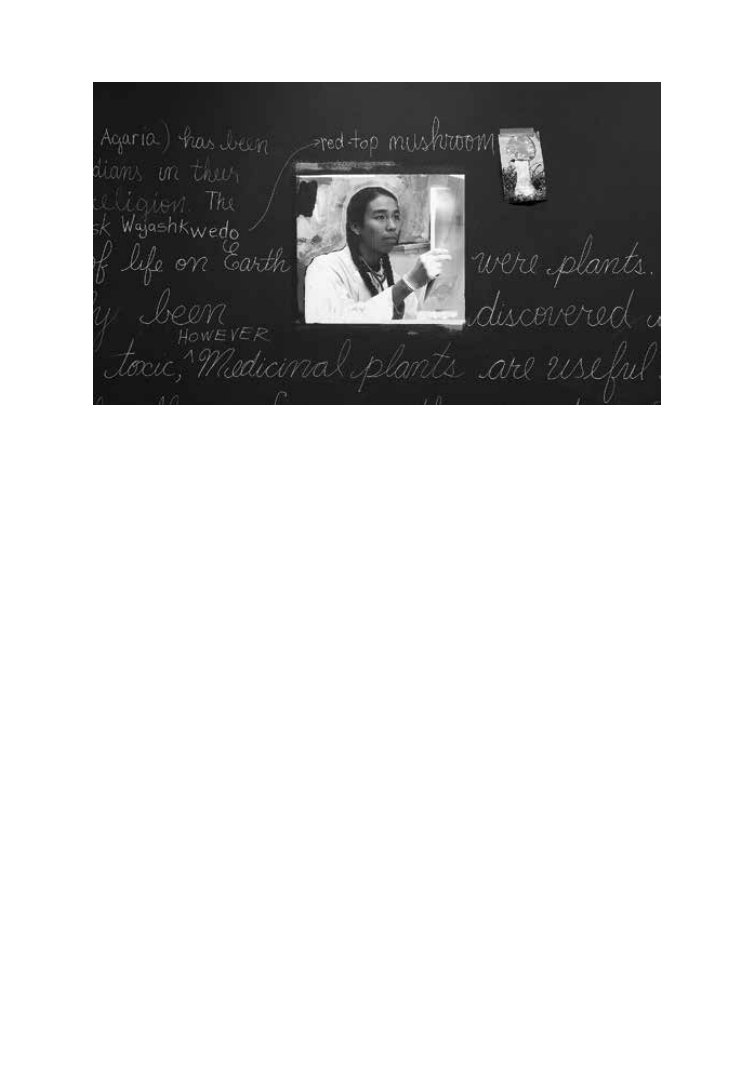
PSB 62 (2) 2016
106
Book Reviews
healers to go further and further to reach
sites at which they can still collect the plants
they use. This second chapter also includes a
profile of the Mayan healer Don Eligio Panti,
who was the teacher of Rosita Arvigo. It was
her interest in documenting Don Eligio’s
knowledge that led her to collaborate with
Michael Balick, and this, in turn, led to the
larger Belize Ethnobotany Project. In the
third chapter, the authors present 11 more
healers, representing different backgrounds,
traditions, and practices. They then provide
edited transcripts of conversations with eight
of these healers that let the reader see, in
their words, the different ways in which they
understand their work.
The account of the useful plants in the
Belizean flora in the fourth chapter is arranged
taxonomically in four sections (ferns and fern
allies, gymnosperms, monocotyledons, and
dicotyledons), following the arrangement
of the earlier checklist of the flora (Balick et
al., 2000). Flowering plant family alignments
follow Angiosperm Phylogeny Group III.
Families, genera, and species are arranged
alphabetically. The authors attempt to provide
at least one illustration (most of which are
excellent color photographs) for each genus.
Species treatments vary in length, according to
the number of uses listed. Under each species,
the lead for each ailment or other use is set
boldface, making it easy for the reader to see
the variety of uses and range of detail available.
References to voucher specimens and to the
relevant literature are provided. What I did
not find was a consistent indication of which
species are introduced in Belize. Some are
obvious, like the food plants introduced by
Europeans (e.g., breadfruit, coconut, rice).
This is too bad, as it would be interesting to
see the extent to which healers have taken
advantage of cosmopolitan weeds and other
introduced species. Evidently, the interest is
there, as one healer, the late Percival Hezekiah
Reynolds, asked Balick for dandelion seeds.
The central portion of the right panel of “Potato Peeling 101 to Ethnobotany 101” by Jane Ash
Poitras shows a First Nations youth doing the science that explains an aspect of their traditional
knowledge. Installed in the Daphne Cockwell Gallery of Canada: First Peoples, of the Royal On-
tario Museum. Courtesy of the Royal Ontario Museum, photo credit Brian Boyle.

PSB 62 (2) 2016
107
Book Reviews
The remaining two chapters are found
online, together with three appendices, at the
publisher’s website (http://global.oup.com/
us/companion.websites/9780199965762/).
Chapter 5, by Robert Heinzman and Conrad
Reining, with Michael J. Balick, describes the
timber and non-timber forest products of
Belize in historical, statistical, and economic,
as well as botanical detail. Chapter 6, by
Gordon M. Cragg and David J. Newman, is
a report on Belizean plants evaluated by the
U.S. National Cancer Institute as part of its
approach to the discovery and development
of new drugs for the treatment of cancer and
AIDS. This chapter concludes with its authors’
reflection on the HIV and anti-tumor assay
results. Only a small fraction of the species
documented showed appreciable anti-tumor
activity, and only one species was shown
to contain compounds (guttiferones) with
known anti-HIV activity. The authors note the
difficulty of inferring therapeutic potential
from ethnobotanical data when the diseases
in question, like cancer and HIV, are generally
outside the diagnostic and therapeutic
experience of traditional healers.
The book concludes with a literature cited
section and a 21-page index in fine print.
Overall, it is a wonderfully balanced work that
respects the healers and others who shared
their knowledge with the authors and, at the
same time, respects the scientific traditions
in which the authors operate, one as an
ethnobotanist and the other as a naprapathic
practitioner. This is important, because we
should recognize that the reason why the
authors attach so much importance to the role
of their book in helping Belizeans preserve
their traditional knowledge is that, when Belize
is able to provide adequate modern health
care to all of its citizens, their dependence
on traditional therapies is likely to diminish.
This is as it should be, because so many
illnesses have their origins in interactions
with bacteria, viruses, and parasites, or in
pathologies resulting from accumulated
genetic mistakes or environmental insults, all
of which are best understood in a scientific
context. North Americans and Europeans,
the majority of whom have ready access to
sophisticated medical interventions, forget
this at their peril—witness the needless recent
death of the child whose parents chose to treat
his meningitis only with herbal remedies.
–T. A. Dickinson, Senior Curator Emeritus,
ROM Green Plant Herbarium (TRT), De-
partment of Natural History, Royal Ontario
Museum, Toronto, Ontario, Canada
Literature Cited
Balick, M. J., M. H. Nee, and D. E. Atha. 2000.
Checklist of the vascular plants of Belize, with
common names and uses. Memoirs of the New
York Botanical Garden 85: 1–246.

PSB 62 (2) 2016
108
Book Reviews
HISTORICAL
Hidden Histories and
Ancient Mysteries of
Witches, Plants, and
Fungi
Frank Dugan
2015.
ISBN-13: 978-0-89054-465-5
Paperback, US$69.95. 180 pp.
APS Press, St. Paul, Minnesota,
USA
The précis to Mr. Frank Dugan’s recent
book—Hidden Histories and Ancient Mysteries
of Witches, Plants, and Fungi—describes
“convergent new findings” and “congruent
datasets” as the impetus for a revisionist
view of both crop-pathogen and plant-
human interactions in European history and
prehistory. It is, of course, common practice
for scholars to revise their views when
confronted with new evidence. What makes
Mr. Dugan’s approach unique, however, is
that his writing is at once a revision of our
understanding of crop plant migration; an
intriguing introduction to the relationship
between folklore, fakelore, and literacy; and a
finely woven tapestry of source material that
spans the fields of archaeology, linguistics,
agricultural science, and cultural geography.
His writing is concise and yet his view is
expansive, making Hidden Histories a valuable
reference for both the expert in and the
student of agricultural history.
Despite a bibliography of nearly 700
sources, Hidden Histories is a small book
that uses a narrative approach to outline a
rigorously investigated and sound intellectual
framework. The author has cleverly organized
the material around broad and encompassing
themes: the spread of crop plants and fungal
pathogens; the exchange of ethnobotanical
information between oral and literate sources;
the impact of New World plants on Old World
folklore; the transformation of traditional
knowledge following land use change and
the commercialization of plant materials;
and new forms of pagan customs originally
intended to protect crops and livestock. Each
chapter can be read on its own as a lengthy
review. Together, they represent an example of
the rare kind of multidisciplinary scholarship
that seeks to unify rather than divide.
In the opening chapter, which references the
title of a work by Hesiod—Shadows of Works
and Days—Mr. Dugan demonstrates his
scientific expertise as he considers molecular-
genetic evidence that alters our previous
understanding of crop-pathogen interactions,
the timing of crop plant introductions, and
the impact of these on the health and habits of
the European rural poor. Linguistic evidence
also plays a large role in the author’s analysis.
We are convincingly shown that weather and
existing pathogens repeatedly led to famine
in medieval and premodern Europe as scald
and rusts moved between domesticated and
wild plants. We learn of the migration of
legumes and their importance, along with
pathogen-resistance vetches, as alternate
forms of sustenance. Foraging for wild plants
and fungi is described as a necessity during
“need years.” The complexity of securing
adequate nourishment in premodern times is
contextualized by being placed alongside the
early plant science to which the experience of
scarcity gave rise.
Subsequent chapters continue tracing the role
of women as the primary foragers and keepers
of orally transmitted plant knowledge. The
tired, albeit revealing, contrast between oral
and literate societies, folklore and ethnobotany,
herbalism and patented medicine is present
in Mr. Dugan’s writing but is thankfully
downplayed. Instead, the author seems to
favor a view that suggests that one form of

PSB 62 (2) 2016
109
Book Reviews
social interaction and knowledge transfer was
necessarily eclipsed by another as writing
became the dominant form of communication
among those interested in plant lore. A novel
part of his analysis is the effect of enclosure
of the commons on rural, especially female,
interactions with wild plants. The impact
of “women … sundered from wild and
common spaces” is visible today as a nearly
complete loss of intergenerational knowledge
of mushrooms. Folkways of information
transfer are interpreted as important sources
of ethnobotanical knowledge when they can
be juxtaposed with other evidence and as
fakelore, or invented traditions, when they
cannot. Mr. Dugan is quick to remind us,
however, that fakelore often contains accurate
information about plant uses and should not
be entirely discounted as its own avenue
worthy of study.
Despite the book’s emphasis on traditional
knowledge, the reader who is seeking
information on the “ancient mysteries of
witches” mentioned in the title might be
disappointed. Gone are the days when
women who gather and work with plant
materials are given the moniker “witch.” As
Hidden Histories demonstrates, the revival
of interest in such topics as Wicca and the
occult can mask a more practical and durable
synthesis that is taking place: that between
scientific and popular approaches to botanical
knowledge. The uncommon and eclectic
illustrations provided by Mr. Dugan support
the view that plants and human culture are
inextricably joined and the evolution of one is
not entirely distinct from the development of
the other. One travels across time and space
and back again while reading this intriguing
review, and despite the fact that one’s journey
is organized more by theme than chronology,
the end result is invigorating rather than
disorienting. A trail of open doors remains.
–Andrea Kornbluh, Department of Biological
Science, Rowan University, Glassboro, New
Jersey, USA; kornbluh@rowan.edu
SYSTEMATICS
Keys to Lichens of
North America
Irwin M. Brodo
2016.
ISBN-13: 978-0-300-19573-6
Paperback, US$29.95. 424 pp.
Yale University Press, New
Haven, Connecticut, USA
Surely lichens are an underappreciated life
form, often overlooked as just growths on tree
trunks. These symbiotic organisms composed
of a fungus and alga have been shown to be
able to decompose rock, given enough time.
They also are capable of surviving in very
inhospitable conditions while also being useful
in determining air quality. Lichenologist Dr.
Irwin Brodo has championed this often-
ignored but ecologically significant group
of organisms, particularly in the 2001 book
Lichens of North America (LNA). Now lichen
enthusiasts and general naturalists have an
accompanying key to identification.
Brodo indicates in the preface that this
volume came about at the request of many
readers of the LNA book who indicated a
need for a spiral-bound, no-extras guide that
could incorporate the identification keys
from the original book. Certainly this volume
seems like a great addition to a herbarium,
classroom, or lab. It lies completely flat and
contains a huge amount of information at one’s
fingertips. However it seems unsuitable for
excessive use in the field, as the cover is paper
and the interior stock rather flimsy. This must
be a concession to the expense of printing
such an extensive work for an admittedly
narrow audience. It would not resist tears or
moisture well.
The key includes just a few photos in an
appendix, but this must be expected in a book
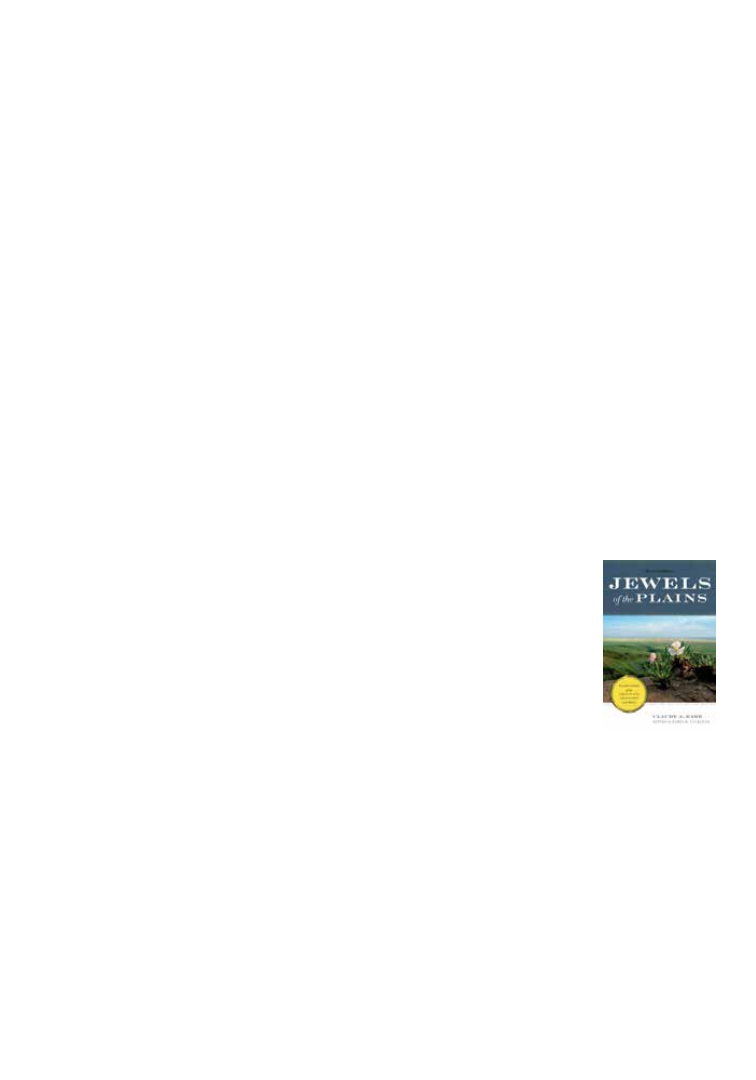
PSB 62 (2) 2016
110
Book Reviews
including over 2,000 species, nearly double the
species covered in LNA. Brodo mentions there
are 4,881 lichen species recognized as of 2014,
and the key incredibly covers nearly half of
them. There are 10 pages of figures illustrating
lichen morphology and concepts necessary for
use of the key, a most helpful inclusion even for
experienced lichenologists, and certainly vital
for students and enthusiasts. The glossary is
absolutely essential, as it clarifies terminology
used in identification. It’s fortunately very
clear, and I referred to it constantly.
Keys A through K cover major types of lichen,
including fruticose, crustose, squamulose,
umbilicate, foliose, jelly lichens, and variations
like dwarf fruticose. So, for example, if I know
I have a fruticose lichen, in Key A, Fruticose
lichens, we find “1. Thallus pale greenish
yellow, yellowish green, green, white, gray,
brown, olive, or black…6.” Following this to
6.(1) and 6., I choose 6.(1) “Thallus pendant or
almost pendant,” etc. This leads to 7., where I
must choose between “Thallus greenish yellow
or yellowish green (containing usnic acid in
the cortex)” or “Thallus shades of white, gray,
brown, olive, or black (lacking usnic acid).” I
choose the first, which refers me to 8.
Now I must choose between microscopic
characteristics: do the branches contain a
tough, single, central cord, or no? In this
hypothetical case, I can choose the former,
which tells me I have the common
Usnea,
a.k.a. old man’s beard lichen. Now I can go
further, to the section on
Usnea species
on page 348. Further characteristics, some
requiring at least a hand lens to determine,
may lead to my particular species.
By using these diagnostic characteristics, and
sequence of steps, one should be able to “key
out” ideally to species. But lichen, like the
fungi and algae that compose them, are not
the easiest organisms to identify to species;
doing so with certainty may often require
microscopic examination of spores or other
internal characteristics.
This is a utilitarian book, and should be
preceded by study of the LNA. It is intended
for use alongside the LNA. This is not a
beginner’s book, and to avoid frustration,
users should at least familiarize themselves
with terminology used in morphology, etc.
This key not only revises identifications
since the publication of LNA, but is a major
expansion. Species covered in greater detail
in LNA are helpfully in boldface, so one can
easily seek further detail. This volume is a
fantastic addition to the masterwork of lichens
that is Lichens of North America.
–Kenneth Setzer, Fairchild Tropical Botanic
Garden, Coral Gables, Florida, USA
Jewels of the Plains: Wildflowers of the
Great Plains Grass-
lands and Hills, revised
edition
Claude A. Barr, edited by
James H. Locklear
2015.
ISBN-13: 978-0-8166-9801-1
Hardcover, US$27.95. 288 pp.
University of Minnesota Press,
Minneapolis, Minnesota, USA
According to the dustjacket flap, “Claude A.
Barr did not set out to be a writer.” This re-
released and updated classic work shows that
we are all lucky that he became one. Barr
(1887–1982) homesteaded 160 acres of land in
South Dakota in 1910, which, through a stroke
of luck, ended up becoming an acclaimed
nursery. Barr became known for cultivating
native plants (and developing cultivars) from
the Great Plains. His Prairie Gem Ranch
operated for four decades, sending plants
all over the United States and the world. As

PSB 62 (2) 2016
111
Book Reviews
his name grew (thanks to his submission of
photos of native plants to various gardening
journals), people from around the country
began contacting him asking how to grow
these wonderful prairie plants. Barr began
writing about the plants as well, and here lies
the body of this work.
This work was originally published
posthumously in 1983 and has since gone
out of print. University of Minnesota Press
has done everyone who enjoys native
wildflowers a great service in updating and
re-releasing it. James Locklear (who recently
published a work on Phlox) has updated all
of the nomenclature in the original book
and otherwise left the text untouched. Also
included are an Introduction, Notes, Glossary,
and Bibliography. Locklear has not only
updated the species names for each taxon
that Barr covered but also included the “old”
name so that people who are unfamiliar with
the newer names can understand what plant
is being described. The over 500 species
covered are arranged alphabetically by genus.
Each genus has at least one species described,
sometimes many more. Barr not only wrote
about each plant’s physical characteristics, but
its distribution, cultivation, and ecology. Here
the text really shines. Barr does a fantastic job
of describing the plants and writes about them
in a way that is not often seen. I will quote a
few nice passages:
Referring to Hypoxis hirsuta: “…it puts up its
miniature reflections of the sun, singly or in
clusters, over a long season…”
Writing of Antennaria: “Many are the low,
gray mats of ladies’-tobacco, many the varied
leaf forms and patterns in different regions,
and many the attitudes of gardeners toward
these useful and beautiful subjects in garden
design.”
Arctostaphylos uva-ursi: “It delights in
modeling the irregular surface of rocks with
its advancing stems, and there displays at
their best, in early spring, its brief clusters of
tiny, pendant urns of pink and white. Is there
a finer four-season, low shrub to be found?”
I had never heard of this book before now, and
I am very grateful that it has been reprinted
for younger generations to enjoy.
–John G. Zaborsky, Botany Department,
University of Wisconsin–Madison, Madison,
Wisconsin, USA; jzaborsky@wisc.edu
Spot-characters for the
Identification of Malesian
Seed Plants: A Guide
M. M. J. van Balgooy, Y. W. Low,
and K. M. Wong
2015.
ISBN-13: 978-983-812-159-0
Paperback, US$29.63. 288 pp.
Natural History Publications
(Borneo), Kota Kinabalu, Sabah, Malaysia
Asia is one of the most biodiverse continents,
with six megabiodiverse countries— namely
China, India, Indonesia, Malaysia, the
Philippines, and Papua and New Guinea.
Due to the tropical and subtropical climate
regimes, Southeast Asia is particularly rich
in plant resources, with over 40,000 seed
plants known to science; this biodiversity
is comparable to the rich plant diversity of
the Neotropics (Central and South America)
and the Afrotropics (Sub-Saharan Africa).
Spot-characters for the Identification of
Malesian Seed Plants is a spectacular guide
book exploring the rich plant diversity of
the Malesian region. Malesia represents a
phytogeographically rich part of Southeast
Asia, comprising the countries Brunei,
Indonesia, Malaysia, Papua and New Guinea,

PSB 62 (2) 2016
112
Book Reviews
floristic set.”
This volume will be useful for field biologists,
professional botanists, ecologists, herbarium
curators and conservators, phytogeographers,
environmentalists, researchers, academics,
and students specializing in the seed plants
of Southeast Asia both within and adjacent
to the Malesian phytogeographic region. It
will also interest amateur botanists and plant
enthusiasts, particularly those interested in
the seed plants of the vast, biodiverse Indo-
Malaya ecozone. I particularly recommend
the volume to aspiring taxonomists who
wish to learn how to systematically describe
a plant in the most comprehensive fashion in
the classroom. The numerous colored plates,
micrographs, and images—along with the
accompanying texts—will enable budding
taxonomists to develop expertise on important
plant diagnostic characters in the laboratory, as
well as while scanning herbarium specimens
before formal field exposure.
–Saikat Kumar Basu, University of Lethbridge,
Lethbridge, Alberta, Canada
the Philippines, Singapore, and Timor-Leste.
It is important to note that four countries
within the Malesian region are designated
as megabiodiverse countries, suggesting the
spectacular floral diversity of the region.
This comprehensive, colorful volume lists,
discusses, and analyzes 119 spot characters of
Malesian seed plants and includes color plates
highlighting various identifiable seed plant
characters. The authors have painstakingly
included every possible taxonomic detail
necessary for clearly identifying the local seed
plants, and the volume nicely translates their
decades of cumulative experiences in seed
plant identifications under the challenging
field conditions of Southeast Asia.
The plant characters include various growth
forms, distinctive vegetative characters (like
stem and branch patterns as well as foliar
characters such as stipules, petioles, rachis, leaf
arrangement or phyllotaxy, leaf forms, shapes,
margins, venation, coloration, indument, leaf
surface, textures), and reproductive characters
(e.g., different forms of floral arrangements
or inflorescences, flowering habits, life
cycles, forms of flowers, fruits and seeds).
Quick field characters such as plant exudates
(saps and resins) and characteristic smells
that a collector or surveyor would notice
during field collections are also included.
The authors focus on important diagnostic
characters that can be easily detected both in
well-preserved herbarium specimens and in
newly collected specimens to facilitate quick
and comprehensive identification of local
seed plants. A number of easily detectable
field characters are also included in this
unique and comprehensive guide. The authors
elegantly explain that the “spot characters”
devised by them are not an attempt to replace
conventional taxonomic keys, but are simply
to assist in the process of identification of plant
families, genera, or species for a “specific
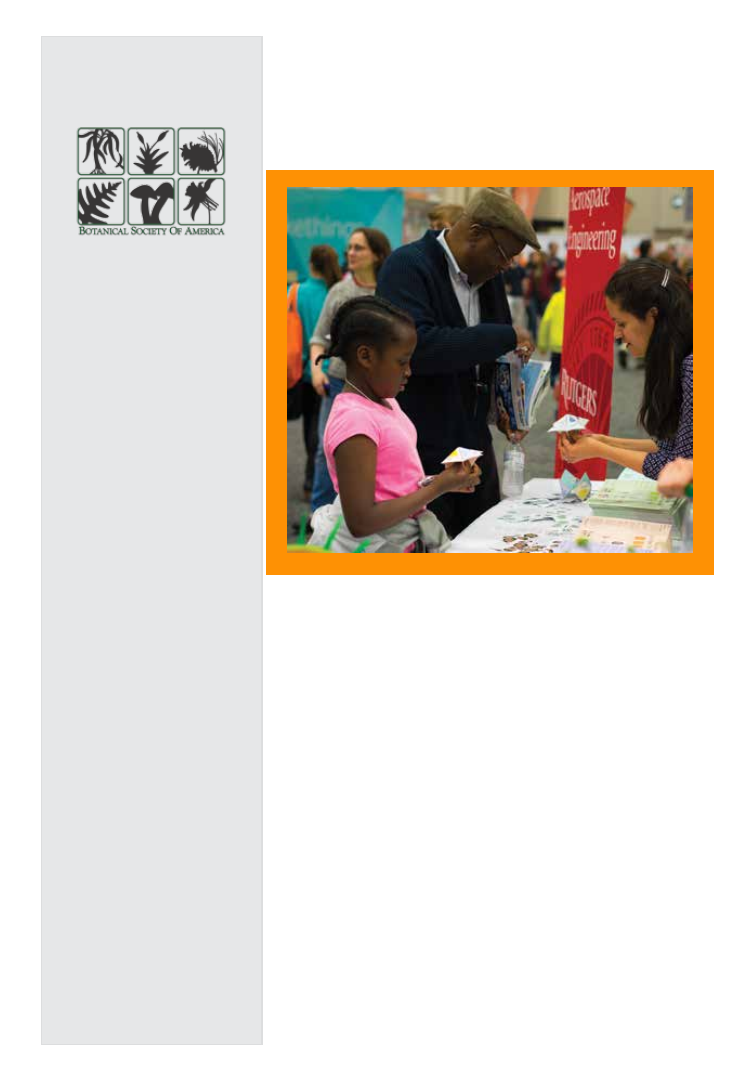
Plant Science Bulletin
Featured Image
The Botanical Society of
America is a membership soci-
ety whose mission is to: pro-
mote botany, the field of basic
science dealing with the study
& inquiry into the form, func-
tion, development, diversity,
reproduction, evolution, & uses
of plants & their interactions
within the biosphere.
ISSN 0032-0919
Published quarterly by
Botanical Society of America, Inc.
4475 Castleman Avenue
St. Louis, MO 63166-0299
Periodicals postage is paid at
St. Louis, MO & additional
mailing offices.
POSTMASTER:
Send address changes to:
Botanical Society of America
Business Office
P.O. Box 299
St. Louis, MO 63166-0299
bsa-manager@botany.org
The yearly subscription rate
of $15 is included
in the membership
Address Editorial Matters (only) to:
Mackenzie Taylor, Editor
Department of Biology
Creighton University
2500 California Plaza
Omaha, NE 68178
Phone 402-280-2157
psb@botany.org
Plant Science Bulletin
Summer 2016 Volume 62 Number 2
This April, BSA joined the U.S. Botanic Garden, the
American Society for Plant Biologists, the Donald Danforth
Plant Science Center, Society for Economic Botany, and
Rutgers University in a large, five-part, 600 square foot
“Plant Presence” booth at the USA Science and Engineering
festival (USASEF). Over the course of three days, over
365,000 people attended the festival, and thousands stopped
by the plants booth to explore hands-on activities and
demonstrations around seeds, flowers, roots, stems, and
leaves.
Above, BSA member Monica Carlsen, Research Associate -
Center for Plant Conservation at Missouri Botanical Garden,
shows a young visitor how to play the a leaf adaptation
origami game developed by Jennifer Blake Mahmud
(Rutgers) and BSA Education Director Catrina Adams.
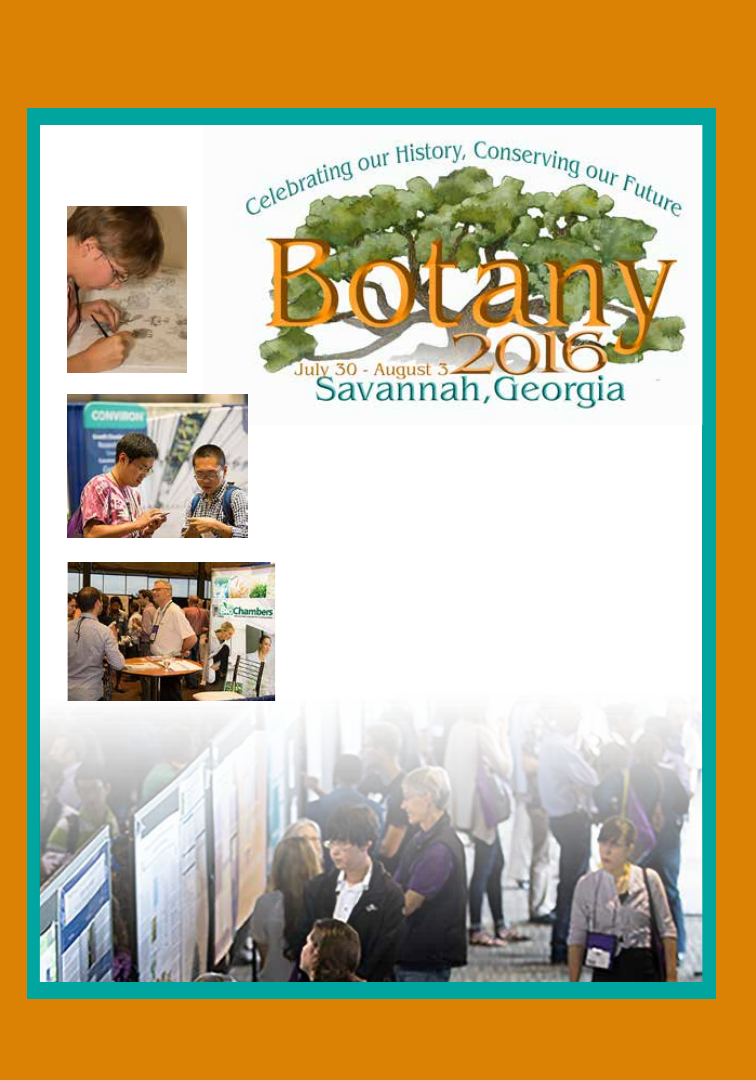
Be sure and view the video
at:www.botany.org
Savannah International Trade and
Convention Center
Symposia, Posters, Exhibits,
Field Trips, Workshops
Submit your abstract and sign up to attend this
premier botanical conference!
www.botanyconference.org